Introduction
In the rapidly evolving landscape of modern business, Automated Information Systems (AIS) have emerged as essential tools that redefine operational efficiency and drive competitive advantage. These systems, ranging from basic data entry applications to complex enterprise resource planning solutions, offer organizations the ability to streamline processes, reduce errors, and enhance decision-making capabilities.
As companies increasingly turn to automation to combat inefficiencies and improve productivity, understanding the various types of AIS and their benefits becomes paramount. This article delves into the multifaceted world of AIS, exploring their definitions, examples, and the transformative impact they can have on businesses.
By addressing both the advantages and the challenges of implementation, it provides a comprehensive framework for organizations looking to harness the power of automation and navigate the complexities of today’s data-driven environment.
Understanding Automated Information Systems: Definitions and Examples
Types of automated information system (AIS) serve as integrated frameworks that proficiently collect, store, manage, and disseminate information with minimal manual intervention. These frameworks encompass various types of automated information system, from straightforward data entry tools to sophisticated enterprise resource planning (ERP) solutions. For instance, a customer relationship management (CRM) platform automates the management of customer interactions, enabling businesses to enhance their engagement strategies.
Similarly, an inventory management solution can autonomously trigger reorders when stock levels fall below predefined thresholds, ensuring seamless supply chain operations. The fundamental advantage of AIS lies in their capacity to enhance operational performance, significantly reduce errors, and streamline workflows. As emphasized in a recent case study, a mid-sized company enhanced operational efficiency by 80% through GUI automation, overcoming challenges such as manual information entry errors and integration of legacy systems.
This case study specifically noted a 70% reduction in entry errors and a 50% acceleration in testing processes, showcasing how businesses can address poor master information quality and alleviate concerns about the complexity and costs of AI projects. The perception that AI projects are time-intensive and costly can deter organizations from adoption; however, Small Language Models (SLMs) offer a cost-effective alternative that requires less computational power and enhances data security by allowing on-premises deployment. As we embrace types of automated information systems, we not only maintain competitiveness but also catalyze transformative operational excellence.
Recent advancements in these structures, particularly in types of automated information system such as enterprise resource planning, are influencing the future of business productivity, demonstrating a clear shift towards a more automated and effective operational paradigm. In the words of Steve Polyak, ‘Before we work on artificial intelligence why don’t we do something about natural stupidity?’ This perspective underscores the importance of addressing foundational issues within AIS before progressing to more advanced technologies.
Additionally, the mission of the Information Technology Section of the American Accounting Association highlights the significance of excellence in research and practice related to types of automated information system, reinforcing the vital role of AIS in contemporary business. As statistics indicate a notable increase in the use of types of automated information system in 2024, their rising significance and influence on business productivity cannot be overstated.
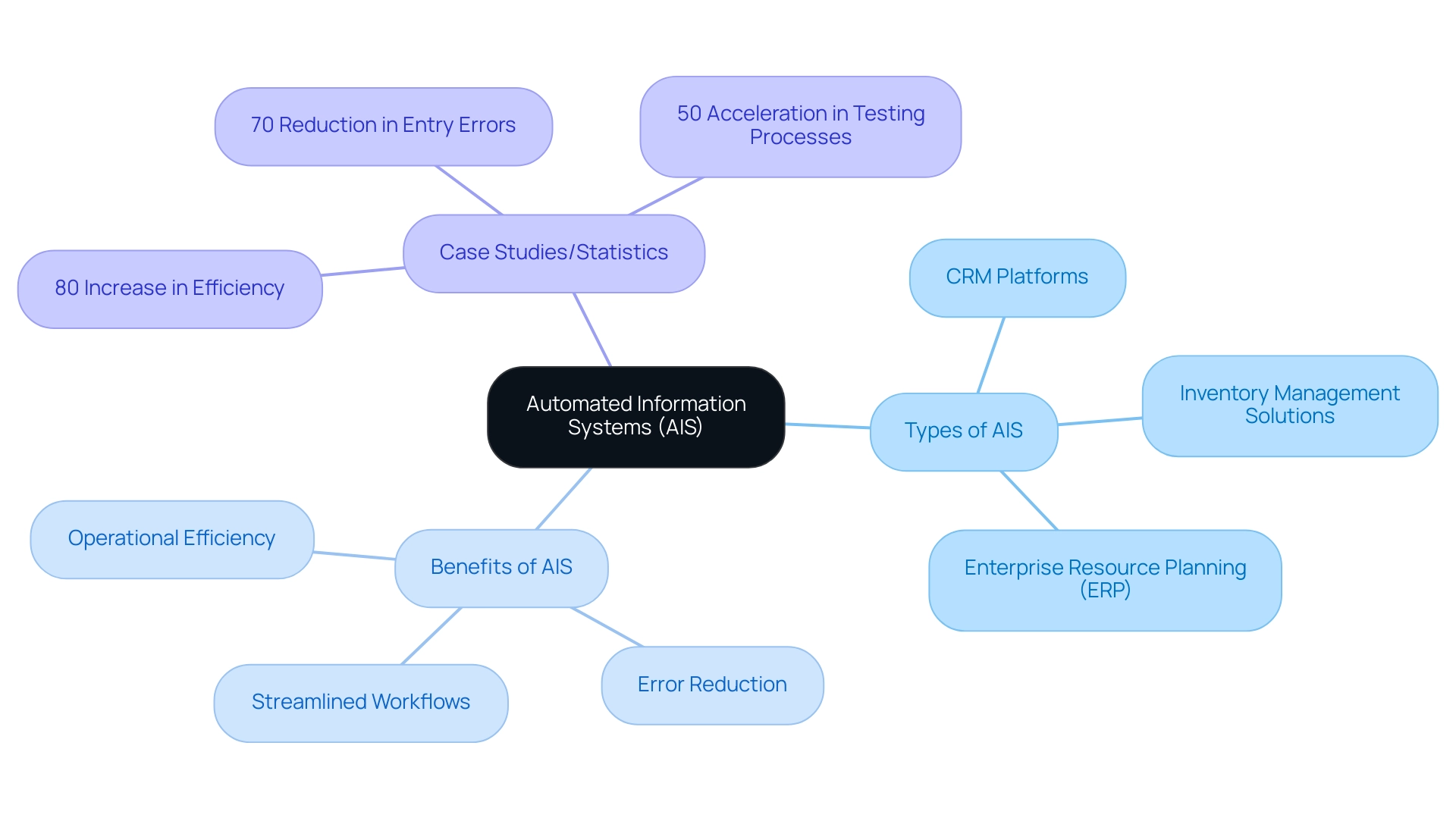
Exploring the Various Types of Automated Information Systems
Automated Information Systems (AIS) are pivotal in enhancing operational efficiency and can be categorized into several key types of automated information system.
-
Transaction Processing Systems (TPS): These systems efficiently manage routine transactions, such as sales order processing and payroll, forming the backbone of daily operations. Recent research emphasizes that OLS, backed by strong TPS, offers organizations with efficient processing capabilities, illustrating the essential role TPS has in operational success.
-
Management Information Systems (MIS): MIS produce detailed reports and analytical tools that enable managers to make informed decisions based on real-time information. Our Power BI services exemplify this, particularly through our 3-Day Power BI Sprint, which enables rapid report creation, ensuring consistency and clear actionable guidance.
-
Decision Support Tools (DSS): These tools are essential for intricate decision-making, examining large volumes of information to deliver actionable insights.
-
Executive Information Systems (EIS): Tailored for senior management, EIS provide a high-level overview of critical information, allowing for swift strategic decisions.
-
Customer Relationship Management (CRM) Tools: By automating customer interactions and managing data, CRM tools significantly enhance customer satisfaction and loyalty.
Each category of types of automated information system contributes uniquely to the enhancement of operational processes, enabling organizations to achieve increased effectiveness and productivity. Moreover, our cutting-edge RPA solutions, including EMMA RPA and Microsoft Power Automate, directly tackle challenges presented by obsolete technologies, such as sluggish operations and elevated error rates, thus streamlining processes and boosting employee morale. The case study named ‘Streamlining Operations with GUI Automation’ demonstrates how a mid-sized company decreased entry mistakes by 70% and enhanced workflow productivity by 80% through automation, highlighting quantifiable results in operational performance within healthcare.
As Robert James Wherry, Jr. demonstrates with the Human Operator Simulator (HOS), which mimics and improves human performance in intricate settings, the incorporation of advanced technologies highlights the transformative potential of AIS innovations in operational effectiveness.
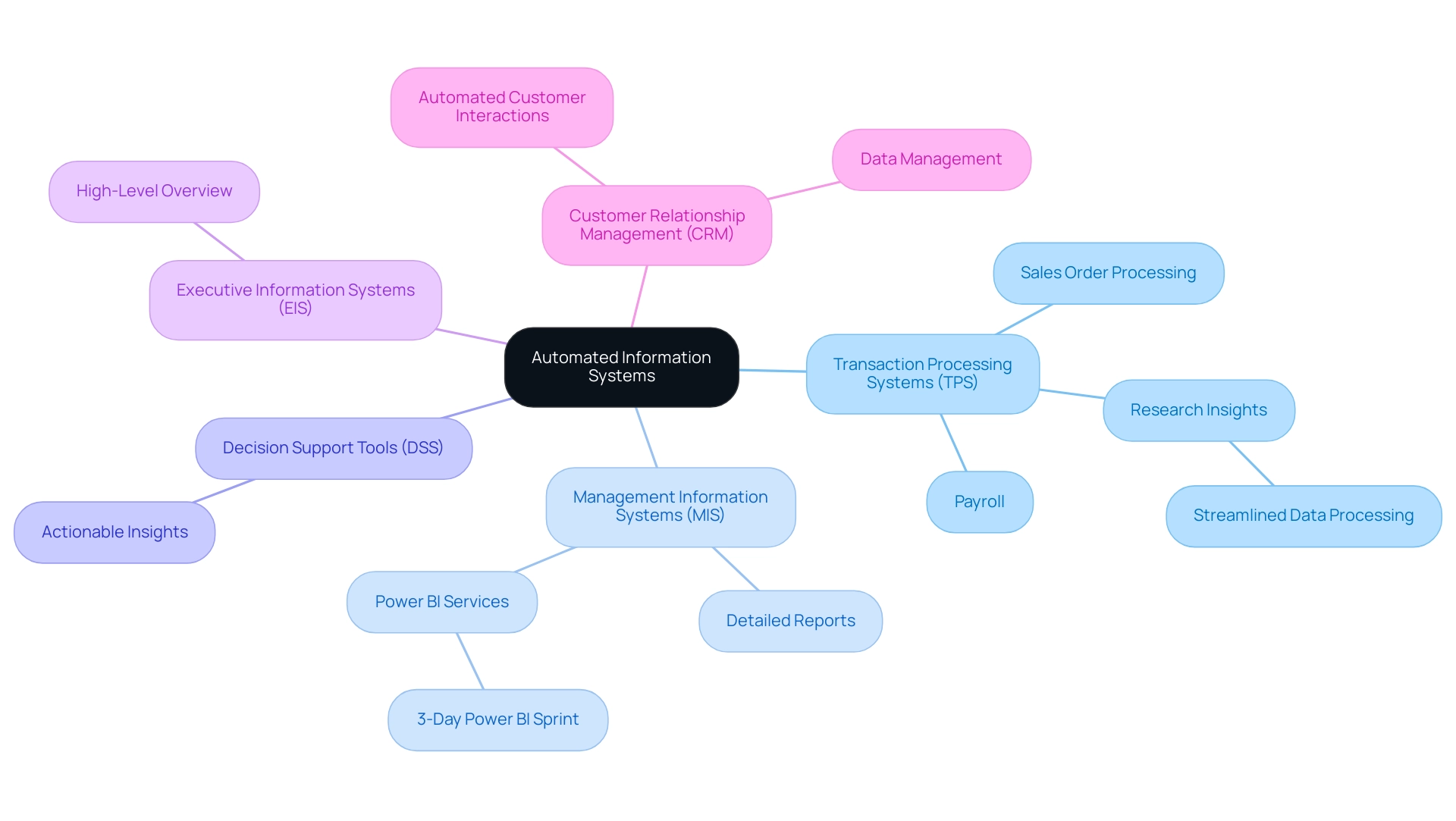
Benefits of Implementing Automated Information Systems
Implementing types of automated information systems (AIS) presents a wealth of advantages that are increasingly vital in the modern business landscape. These frameworks greatly boost productivity, lower operational expenses, and enhance information handling precision. With the potential for automation projected to encompass half of today’s work activities by 2030 and 2060, organizations can empower their employees to focus on more strategic initiatives, fostering innovation and growth.
In this context, utilizing Robotic Process Automation (RPA) plays a crucial role in addressing manual workflows and improving operational performance, particularly in the rapidly evolving AI landscape. For instance, a recent case study on a mid-sized healthcare company demonstrated how GUI automation effectively automated information entry, software testing, and legacy system integration. This implementation reduced information entry errors by 70%, accelerated testing processes by 50%, and improved overall workflow efficiency by 80%, achieving ROI within six months.
Furthermore, tailored AI solutions can help organizations navigate the complexities of automation by aligning targeted technologies with specific business goals and challenges. Business Intelligence tools facilitate informed decision-making by converting raw information into actionable insights, which are vital for remaining competitive in today’s information-rich environment. These tools can assist organizations in revealing valuable insights from their information, ensuring that decisions are based on accurate details.
As organizations embark on technology transformations, HR plays a vital role in supporting employees through the implementation of various types of automated information systems, ensuring smoother transitions and higher acceptance rates. As Bill Gates aptly noted, ‘These questions will get more pressing with time,’ emphasizing the growing necessity for organizations to embrace technological advancements for sustained success.

Challenges in Adopting Automated Information Systems
While the advantages of types of automated information system are substantial, organizations often face significant challenges during their implementation, particularly in leveraging Robotic Process Automation (RPA) to automate manual workflows. Manual, repetitive tasks can significantly slow down operations, leading to wasted time and resources. Resistance to change from employees remains one of the most common obstacles, as workers accustomed to manual processes may hesitate to embrace new technologies.
Concerns about job displacement and the perceived complexity of automated systems can hinder acceptance. Recent surveys indicate a notable level of employee resistance to technology adoption within organizations, especially among mid career workers. Manufacturers with fewer than 200 employees are embracing types of automated information system at the highest rates, highlighting the growing relevance of AIS adoption in smaller firms.
To navigate these challenges effectively, companies should prioritize comprehensive training and robust change management strategies that emphasize how various types of automated information system (AIS) and RPA can enhance job roles rather than replace them. This approach not only boosts production through human-machine collaboration but also equips workers with future-proof skills that add strategic value in the face of ongoing labor market shifts. Furthermore, unlocking the power of Business Intelligence is crucial, as it transforms raw data into actionable insights that can drive informed decision-making and enhance operational efficiency.
A pertinent case study highlights the success of manufacturers who have reskilled their workforce as they adopted automation, illustrating how targeted reskilling initiatives can mitigate employee resistance. Additionally, providing ongoing technical support during the transition can ease integration concerns and foster a smoother implementation process, ultimately leading to a more favorable reception of automated solutions that enhance business productivity through informed decision-making.
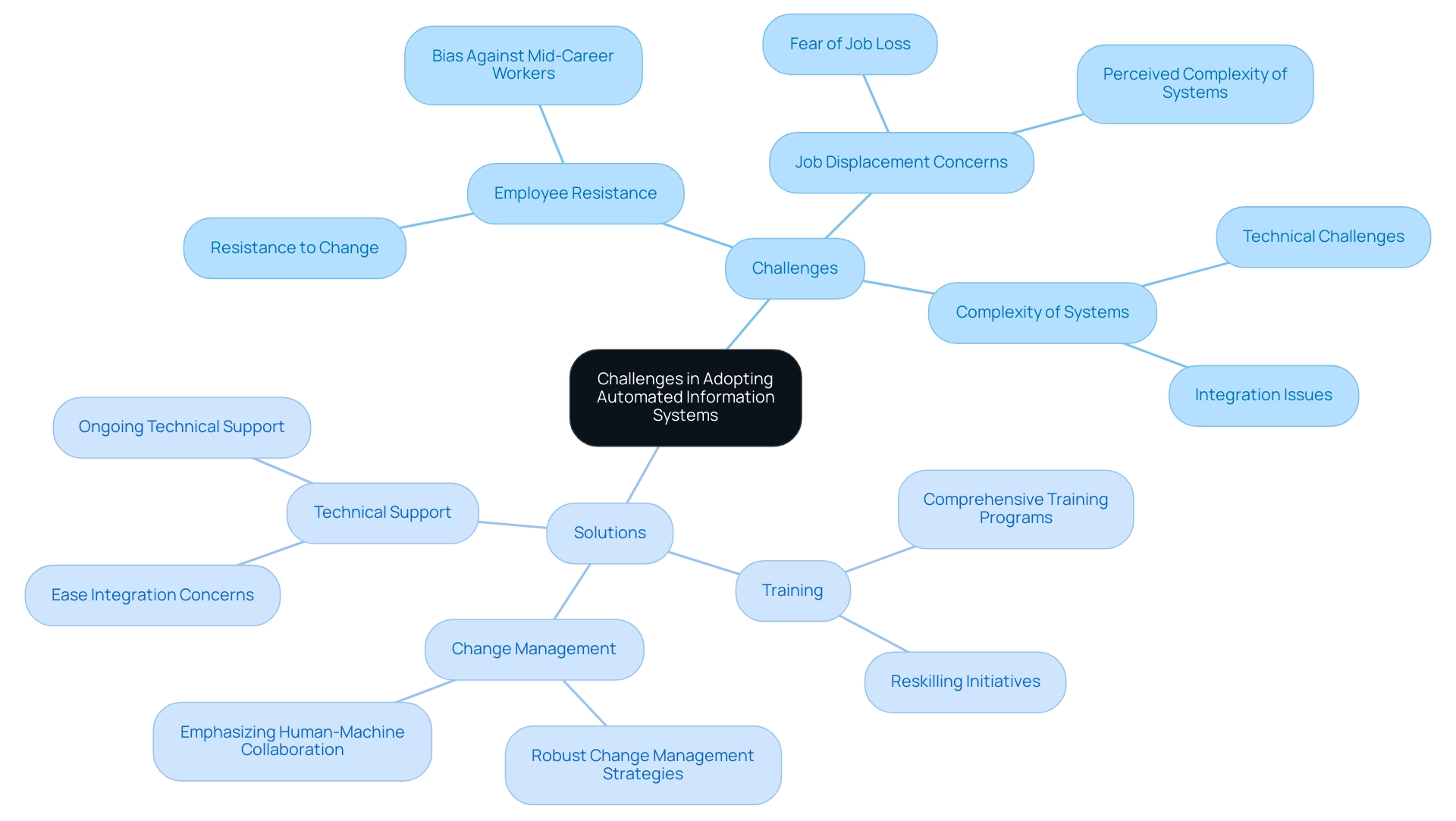
Conclusion
Automated Information Systems (AIS) are reshaping the operational landscape for businesses, providing essential tools to enhance efficiency and drive growth. By streamlining processes, reducing errors, and promoting data-driven decision-making, AIS empower organizations to navigate the complexities of a rapidly evolving market. The various types of AIS, including:
- Transaction Processing Systems
- Management Information Systems
- Customer Relationship Management Systems
each play a critical role in optimizing operations, ensuring that businesses can respond swiftly to changing demands.
While the benefits of implementing AIS are significant, organizations must also address the challenges of adoption. Resistance to change, concerns about job displacement, and the complexities of new technologies can pose hurdles. However, by prioritizing:
- Comprehensive training
- Robust change management strategies
- Ongoing technical support
companies can facilitate smoother transitions. This approach not only enhances employee acceptance but also equips the workforce with vital skills for the future.
Ultimately, embracing Automated Information Systems is not merely about adopting new technologies; it is about transforming business operations for sustained success. As organizations look toward the future, the ability to leverage automation effectively will be a key differentiator in maintaining competitiveness and achieving operational excellence. Now is the time to harness the power of AIS, turning challenges into opportunities for innovation and growth.
Introduction
In the contemporary business environment, data analytics has emerged as a crucial driver of success, offering organizations the ability to transform raw data into strategic insights. As companies seek to enhance efficiency and innovate, understanding the various types of data analytics—descriptive, diagnostic, predictive, and prescriptive—becomes vital. These analytical frameworks empower businesses to not only decipher past performance but also to forecast future trends and recommend actionable strategies.
However, the journey into data analytics is not without its challenges, including data quality concerns and employee resistance. By embracing advanced tools and methodologies, organizations can overcome these hurdles, fostering a culture of data-driven decision-making that propels operational excellence.
This article delves into the significance of data analytics, explores its diverse applications across industries, and highlights the emerging trends that will shape its future in an ever-evolving digital landscape.
Introduction to Data Analytics: Definition and Importance
The examination of information involves the structured computational analysis of information to uncover trends, correlations, and understandings that inform strategic decision-making. In a time when companies are continually aiming for efficiency, the function of information analysis is crucial. Organizations harness this powerful tool to convert raw information into actionable insights, enabling them to optimize operations, enhance customer experiences, and foster innovation.
According to recent statistics, effective analytics, supported by tailored AI solutions like Small Language Models (SLMs), can lead to significant growth in organizational function and profits, underscoring its importance in the business landscape. Overcoming typical views regarding AI deployment, such as reluctance due to inadequate master information quality or the intricacy of AI initiatives, is essential for any entity aiming to prosper. Poor master information quality can lead to inaccurate insights and flawed decision-making, making it imperative for organizations to address these issues before fully adopting AI technologies.
Understanding what are the 4 types of data analytics allows companies to tailor their strategies to meet specific goals, ultimately improving efficiency and productivity. For instance, an IoT distributor created a processing pipeline to analyze and visualize gathered information, enabling a more information-driven decision-making approach. As Andrii Shutka, a Data Science Engineer, succinctly states,
Responsible business information analysis fosters trust among consumers and protects the company’s integrity, making ethical practices a cornerstone of insight-driven strategies.
This ethical focus not only enhances operational effectiveness but also aligns with the latest advancements in analytics technology, ensuring businesses remain competitive in a rapidly evolving landscape. Furthermore, leveraging Robotic Process Automation (RPA) can enhance operational efficiency by automating manual workflows, allowing teams to focus on strategic tasks. Additionally, addressing the perceived complexities of AI projects, such as implementation costs and time requirements, is essential for entities to move forward confidently.
Workplace wellness programs are essential for promoting health and productivity, as noted by the CDC, illustrating the broader importance of data-driven decision-making in enhancing workplace efficiency.

Exploring the Four Types of Data Analytics: Descriptive, Diagnostic, Predictive, and Prescriptive
- Descriptive Analytics: This type emphasizes summarizing historical information to comprehend what has occurred in the past, leading to the inquiry of what are the 4 types of data analytics. It utilizes statistical techniques to provide insights into trends and patterns, enabling organizations to make informed decisions based on historical performance. For instance, a retail company might analyze sales information from the previous year to identify peak shopping periods.
Building on descriptive analytics, diagnostic analytics seeks to explain why certain events occurred, which is crucial when considering what are the 4 types of data analytics. It entails deeper analysis, frequently employing mining techniques to identify correlations and causations. For instance, a company might examine a sudden decline in sales by assessing customer feedback and operational adjustments, potentially improving information quality through customized AI solutions such as Small Language Models.
Predictive Analytics is one of what are the 4 types of data analytics, as it utilizes historical information and statistical algorithms to forecast future outcomes. By analyzing trends, organizations can anticipate customer behavior and market dynamics. For example, a financial organization may utilize predictive analysis to evaluate the probability of loan defaults based on previous borrower information. Incorporating predictive analysis with tools like Power BI can convert these insights into actionable reports that promote informed decision-making. The Power BI services also offer a 3-Day Power BI Sprint, allowing organizations to quickly create professionally designed reports, thereby enhancing their data reporting capabilities.
To understand what are the 4 types of data analytics, it’s important to note that prescriptive analysis is the most advanced type, as it not only predicts future outcomes but also recommends actions to achieve desired results. It utilizes optimization and simulation algorithms to provide actionable insights. For instance, a logistics firm may utilize prescriptive data analysis to optimize delivery routes and lower expenses based on anticipated traffic patterns and delivery schedules, thereby improving operational efficiency through Robotic Process Automation (RPA) solutions such as EMMA RPA and Microsoft Power Automate. By leveraging these technologies, organizations can automate manual workflows and navigate the overwhelming AI landscape effectively, while also utilizing tailored AI solutions and GenAI workshops to improve data quality and training.
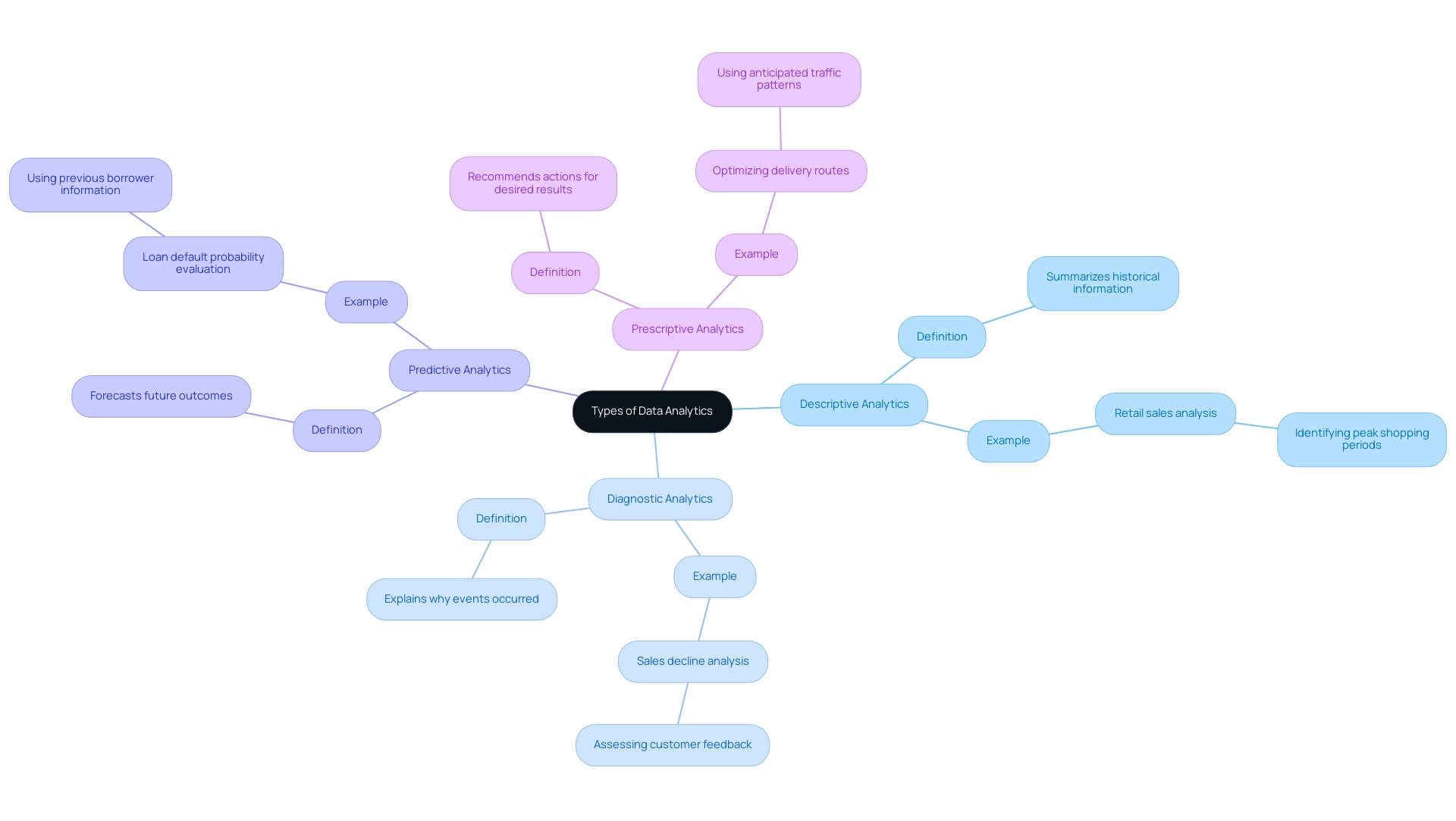
Real-World Applications of Data Analytics
Data analysis is a transformative tool that reveals what are the 4 types of data analytics, finding applications across various industries, each reaping unique benefits. In healthcare, for instance, predictive analytics plays a crucial role in anticipating patient admissions and optimizing staffing levels. This proactive approach not only enhances patient care but also streamlines operational efficiency.
Before executing GUI automation, a mid-sized healthcare firm encountered substantial challenges, including:
– Manual information entry errors
– Slow software testing
– Difficulty integrating outdated systems
A case study demonstrated how implementing GUI automation to automate data entry and software testing resulted in a 70% reduction in errors and an 80% increase in workflow efficiency, reflecting the importance of operational improvements. Robotic Process Automation (RPA) played a critical role in this transformation by automating repetitive tasks, which allowed the staff to focus on more strategic activities.
According to the European Science Foundation, medical imaging contributes to improved patient outcomes and more cost-efficient healthcare across major disease entities. Additionally, the Centers for Medicare & Medicaid Services (CMS) utilized outcome measures to calculate overall hospital quality for its 2018 star ratings, highlighting the importance of outcomes measurement in healthcare. Healthcare systems are increasingly aligning their outcomes measurement with the Quadruple Aim, ensuring that quality care and efficient delivery remain at the forefront of their strategic goals.
Predictive data analysis directly contributes to understanding what are the 4 types of data analytics by enabling healthcare providers to anticipate patient needs and allocate resources more effectively. In retail, understanding what are the 4 types of data analytics through descriptive data analysis enables companies to gain insights into customer purchasing behaviors, facilitating tailored marketing strategies and effective inventory management. The implementation of these analyses is evident in recent case studies, which illustrate how data-driven marketing strategies have led to increased customer engagement and sales.
Furthermore, in finance, prescriptive analysis enables companies to enhance investment portfolios by examining what are the 4 types of data analytics, including market trends and risk factors. This multifaceted strategy highlights the substantial enhancements in efficiency and decision-making fueled by information analysis across sectors, demonstrating to be an invaluable resource for those in leadership positions aiming to improve operational effectiveness.
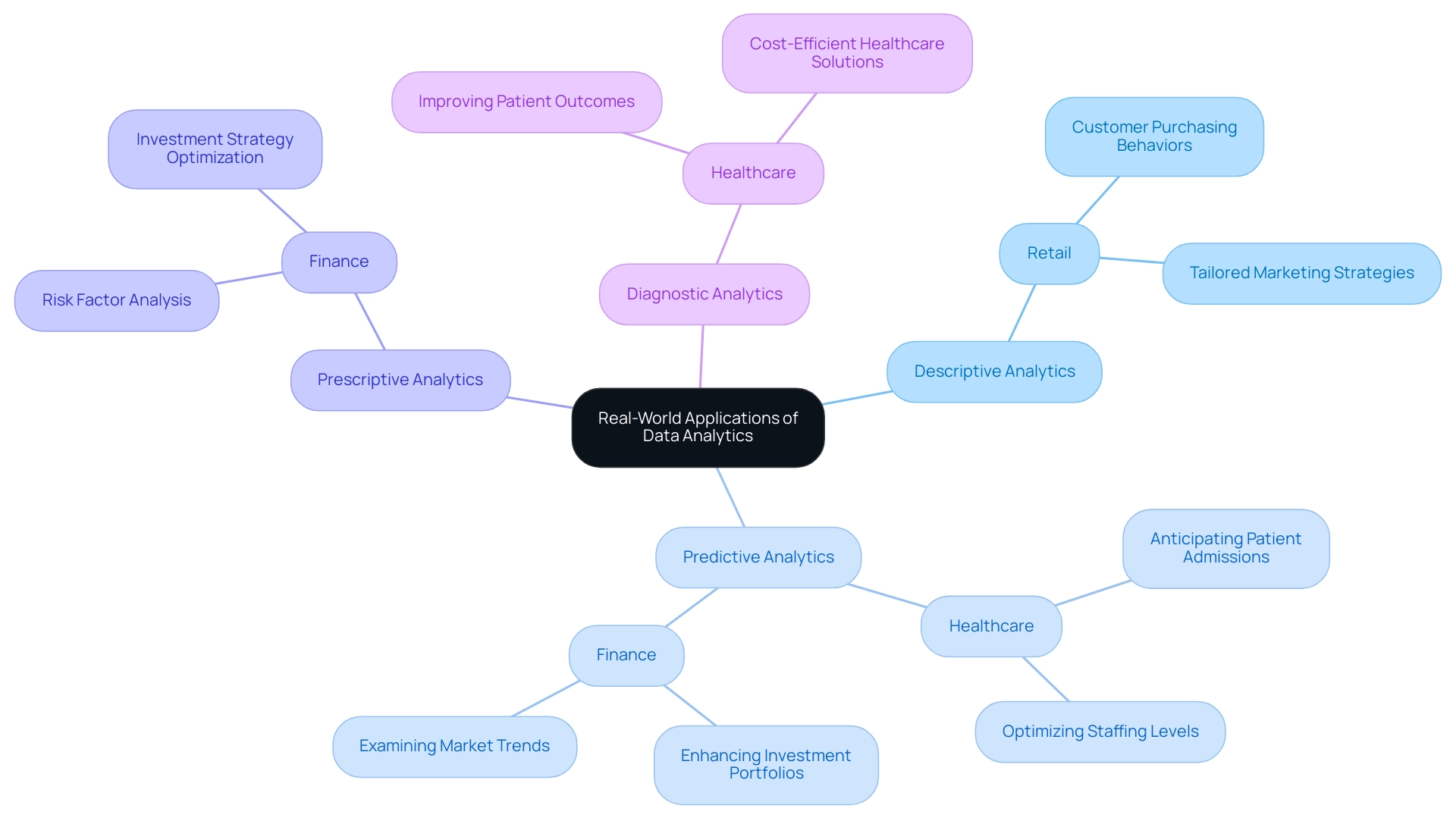
Challenges in Implementing Data Analytics
Implementing analytics can present several challenges for companies, including:
- Quality issues
- Resistance to change from employees
- A lack of understanding of analytical tools
To efficiently utilize information from statistics, organizations must surmount these obstacles. For example, Creatum’s 3-Day Power BI Sprint enables you to produce a fully functional, professionally designed report, assisting you in leveraging information instead of getting lost in report creation.
This report can also serve as a template for future projects, ensuring a consistent and professional design from the start. Furthermore, ensuring that information is accurate and reliable is crucial for deriving meaningful insights. By embracing business intelligence and integrating RPA solutions, entities can enhance operational efficiency, streamline workflows, and foster a culture of data-driven decision-making.
Creatum’s specialized training services provide employees with the essential skills and knowledge to effectively utilize analytical tools, addressing resistance to change and enhancing information literacy. Addressing these challenges not only drives operational efficiency but also positions entities for growth and innovation.
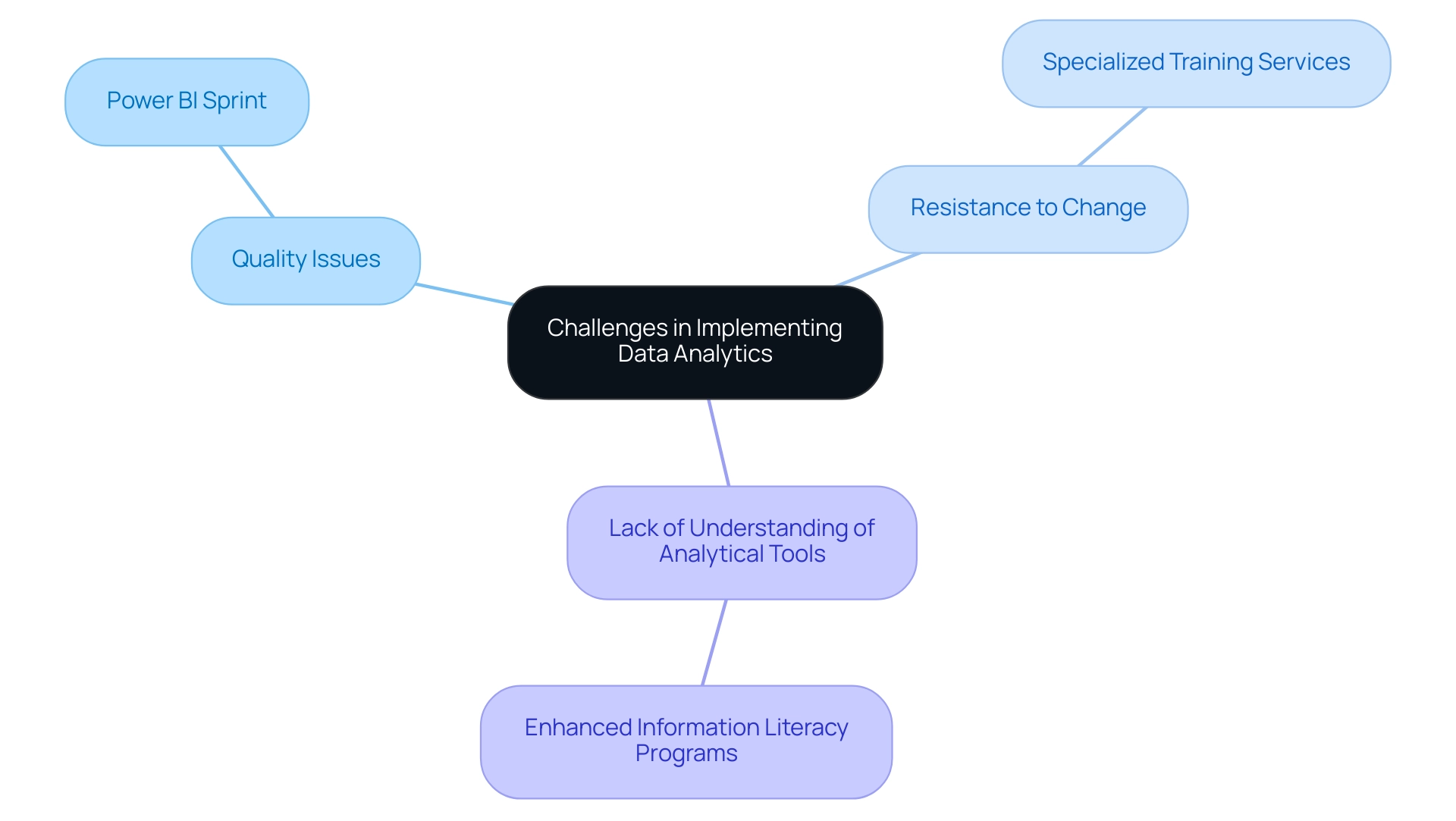
The Future of Data Analytics: Trends and Innovations
The future of information analysis is poised for a remarkable change, significantly shaped by the advancements in artificial intelligence and machine learning. As organizations strive to enhance operational efficiency, leveraging Robotic Process Automation (RPA) tools like EMMA RPA and Microsoft Power Automate will be crucial in automating manual workflows, thus freeing teams to focus on strategic initiatives. Emerging trends indicate a rise in automated data tools, such as Tableau and Power BI, simplifying data examination for non-technical users and broadening access to vital insights.
Moreover, the prevalence of real-time analysis allows businesses to make immediate, data-driven decisions, enhancing productivity and reducing costs. The integration of AI in predictive and prescriptive analytics will further refine the accuracy of forecasts and actionable recommendations. Customized AI solutions can help entities in navigating the complexities of the evolving AI landscape, ensuring they select the right technologies that align with their specific business goals.
As the AI landscape continues to evolve, harnessing the power of RPA and Business Intelligence will be essential for organizations aiming to maintain a competitive edge and drive growth.
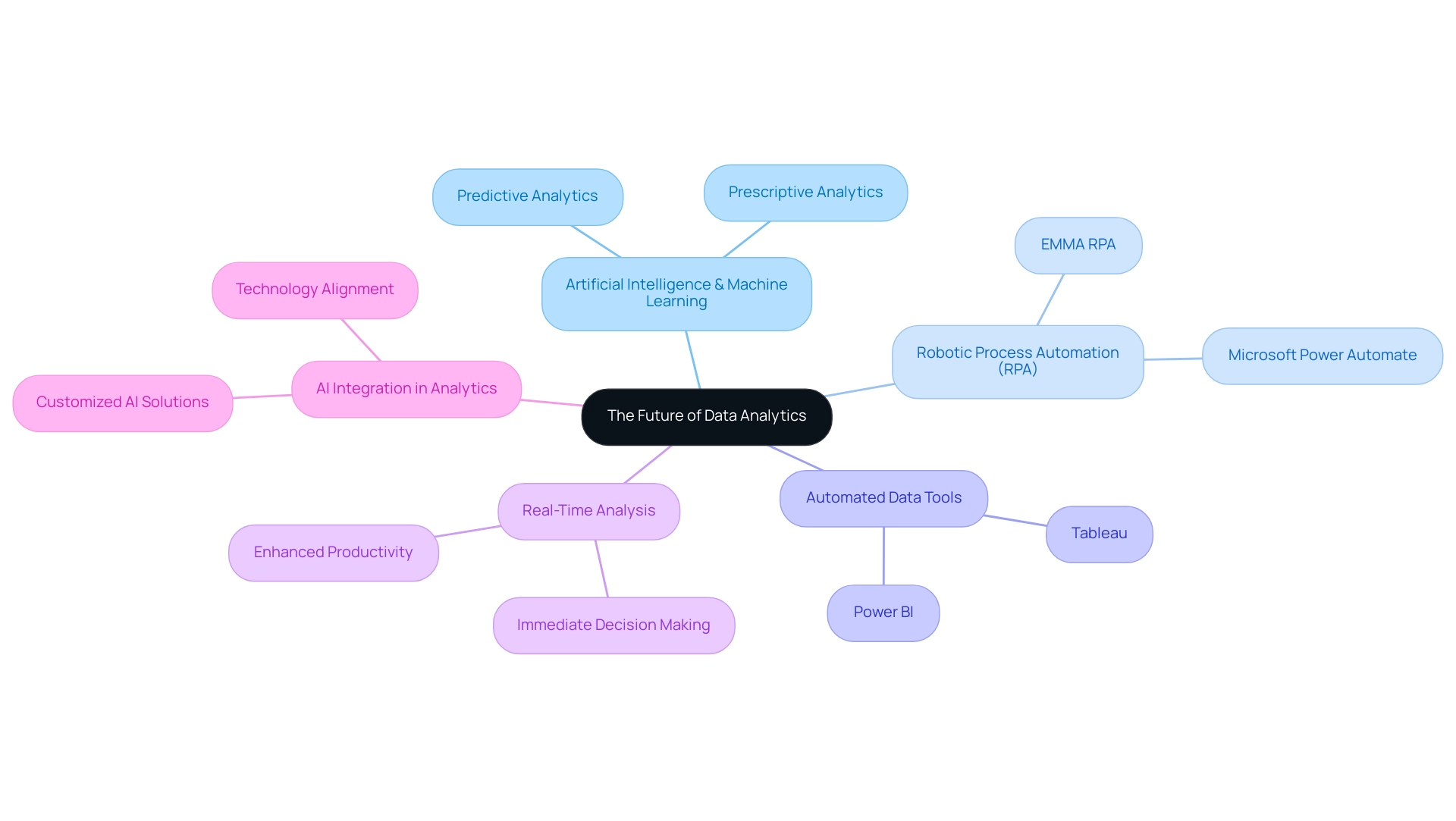
Conclusion
Data analytics stands as a cornerstone of modern business strategy, transforming raw data into powerful insights that drive informed decision-making. By understanding the different types of analytics—descriptive, diagnostic, predictive, and prescriptive—organizations can tailor their approaches to meet specific operational goals, enhancing efficiency and fostering innovation. The real-world applications of data analytics across various industries showcase its transformative potential, with notable improvements in healthcare, retail, and finance all illustrating how data-driven strategies can lead to operational excellence and better outcomes.
However, the path to effective data analytics is not without its challenges. Issues like data quality, employee resistance, and the complexities of AI implementation can hinder progress. By addressing these barriers through training, advanced tools, and a focus on data integrity, organizations can cultivate a culture of data-driven decision-making. This proactive approach not only streamlines workflows but also positions companies to leverage analytics as a competitive advantage.
Looking ahead, the future of data analytics is poised for remarkable advancements, particularly with the rise of AI and automation tools. These innovations will simplify data analysis, broaden access to actionable insights, and empower organizations to make real-time decisions that enhance productivity. Embracing these trends will be essential for businesses aiming to thrive in an increasingly data-centric landscape. By investing in the right technologies and fostering a data-driven mindset, organizations can unlock the full potential of analytics, ensuring sustained growth and operational efficiency in the years to come.
Introduction
In the dynamic landscape of railway operations, the integration of Robotic Process Automation (RPA) is heralding a new era of efficiency and innovation. By deploying intelligent software bots to tackle repetitive tasks, the railway industry is not only reducing human error but also empowering its workforce to focus on strategic initiatives that drive growth.
From streamlining ticketing and scheduling to enhancing compliance reporting, RPA is reshaping how railways operate, promising significant improvements in service reliability and customer satisfaction. As organizations prepare for a predicted surge in RPA adoption, understanding its practical applications and the transformative benefits it offers is essential for staying competitive in today’s fast-evolving market.
This article delves into the multifaceted impact of RPA on railway operations, exploring its challenges, future trends, and real-world success stories that illustrate its potential to revolutionize the sector.
Introduction to Robotic Process Automation in Railways
The RPA railway is transforming train operations by utilizing software robots, or ‘bots,’ to manage repetitive, rule-based tasks that have historically been performed by human staff. This transformative technology is especially pertinent in areas such as ticketing, scheduling, and compliance reporting. By automating these processes, train systems can significantly minimize manual errors, enhance service reliability, and enable employees to concentrate on strategic initiatives that drive growth, thus freeing up valuable time for more value-adding work.
In today’s rapidly evolving AI landscape, RPA serves as a powerful ally, enabling organizations to identify tailored solutions that align with their specific business objectives. Predictions suggest that the adoption of RPA railway technologies in railway activities is anticipated to rise considerably by 2024, with a projected growth rate of 30% as organizations pursue excellence. The advantages of RPA go beyond simple task automation; they include enhanced efficiency and increased customer satisfaction, essential elements in preserving a competitive advantage in the contemporary marketplace.
As highlighted by industry experts, embracing RPA not only streamlines operations but also empowers staff to deliver superior service. Real-world uses of RPA railway in train systems demonstrate its capacity to tackle persistent issues, leading to improved results and greater resilience in operations. For instance, the case study titled ‘Scenario D: High Work-From-Home with Slow Growth‘ illustrates the challenges encountered in a high remote work environment, emphasizing the need for RPA to adapt to changing working landscapes.
Furthermore, ongoing advancements in RPA technology promise to unlock new efficiencies and capabilities, making it an indispensable asset for modern transportation management. As highlighted by the Gateway Development Commission, the economic implications of RPA adoption could be profound, influencing not only expenses but also broader tax contributions in the sector. By leveraging RPA alongside tailored AI solutions and Business Intelligence, organizations can transform raw data into actionable insights, enabling informed decision-making that drives growth and innovation.
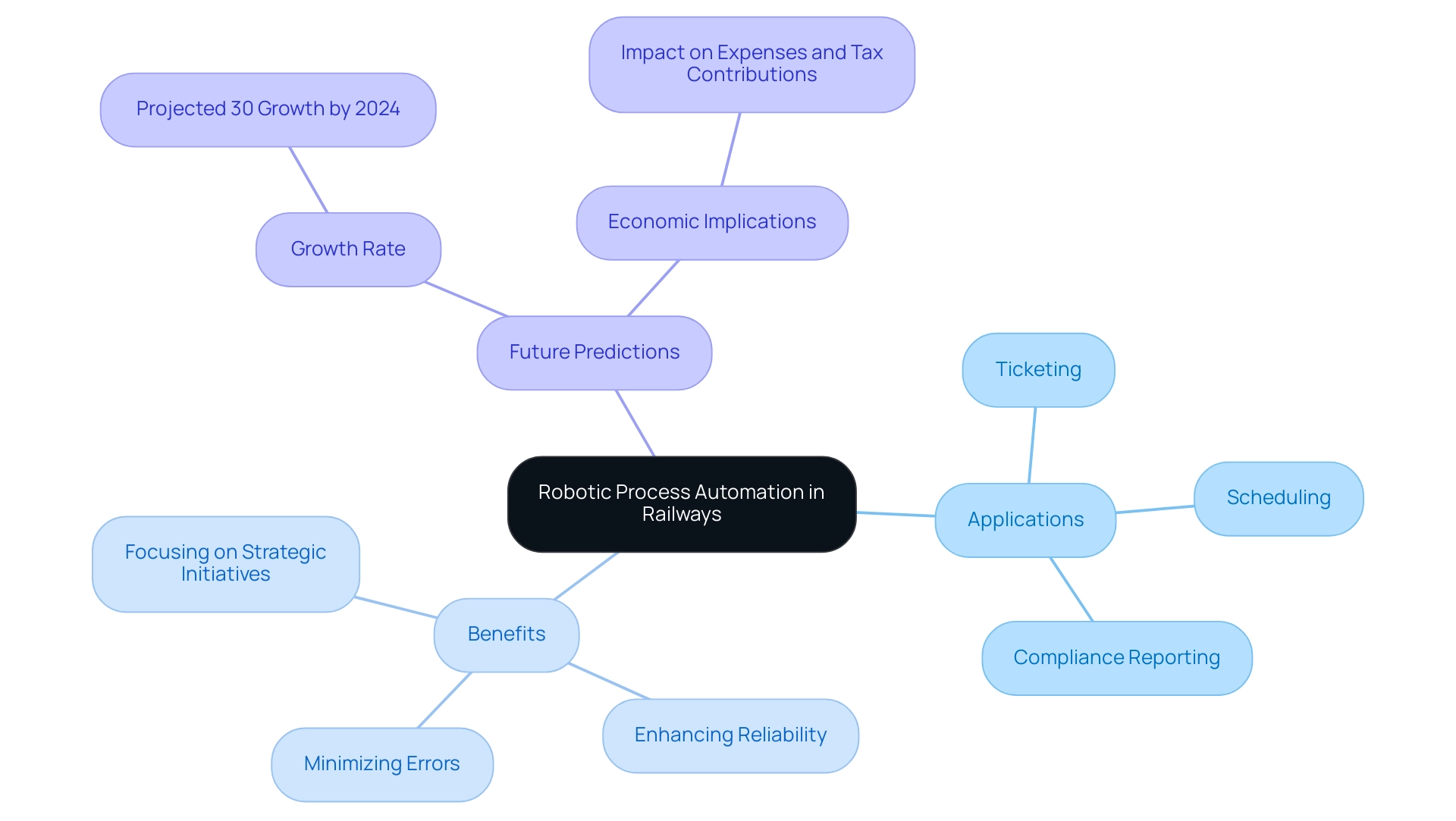
Practical Applications and Benefits of RPA in Railway Operations
RPA railway can be effectively applied in train operations to automate various processes such as:
- Ticket processing
- Inventory management
- Customer inquiries
For instance, automated ticketing systems streamline transactions, significantly reducing queues at stations and enhancing the overall customer experience. Additionally, RPA solutions like EMMA RPA and Microsoft Power Automate play a crucial role in addressing staffing shortages by automating routine tasks, allowing employees to focus on more strategic activities.
These tools can also assist in compliance by automatically generating reports required by regulatory bodies, thereby minimizing the risk of human error. The advantages of implementing RPA railway in the transportation sector are manifold:
- Increased operational efficiency
- Enhanced safety through reduced human error
- Improved service delivery
All contributing to higher customer satisfaction and loyalty. Furthermore, by alleviating the burden of repetitive tasks, RPA enhances employee morale, fostering a more engaged and productive workforce.
By leveraging these advanced RPA tools, transportation companies not only achieve substantial cost savings but also optimize resource allocation, paving the way for innovation and growth in the sector.
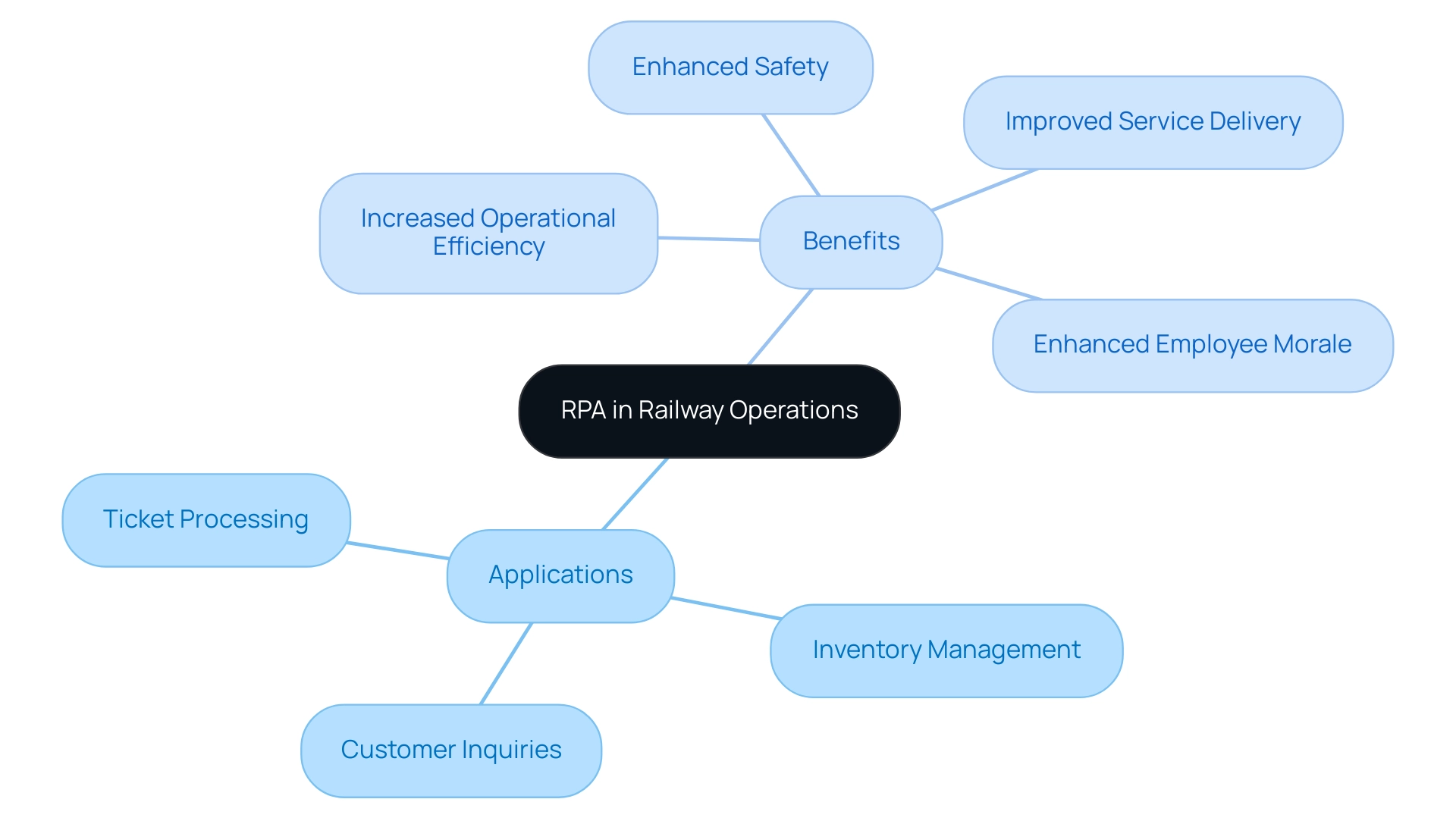
Challenges in Implementing RPA in Railway Operations
Introducing RPA railway in train management presents unique challenges, including potential resistance from employees who are worried about job displacement and skepticism regarding the effectiveness of automation. Furthermore, manual, repetitive tasks can considerably hinder processes, resulting in wasted time and resources. Integrating RPA with existing systems can introduce technical difficulties that necessitate strategic planning and execution.
To navigate these hurdles successfully, it is crucial to cultivate a culture of collaboration and continuous learning. Engaging staff and communicating the transformative benefits of RPA can help alleviate fears and facilitate a smoother transition. Moreover, leveraging tailored AI solutions and Business Intelligence can enhance decision-making processes, ensuring that the integration of RPA is both effective and aligned with organizational goals.
Importantly, the RPA railway can lead to significant cost savings by automating time-consuming tasks, further emphasizing its value. Conducting a comprehensive assessment of existing workflows prior to implementation will help identify potential integration issues, paving the way for a more seamless adoption of RPA technologies.
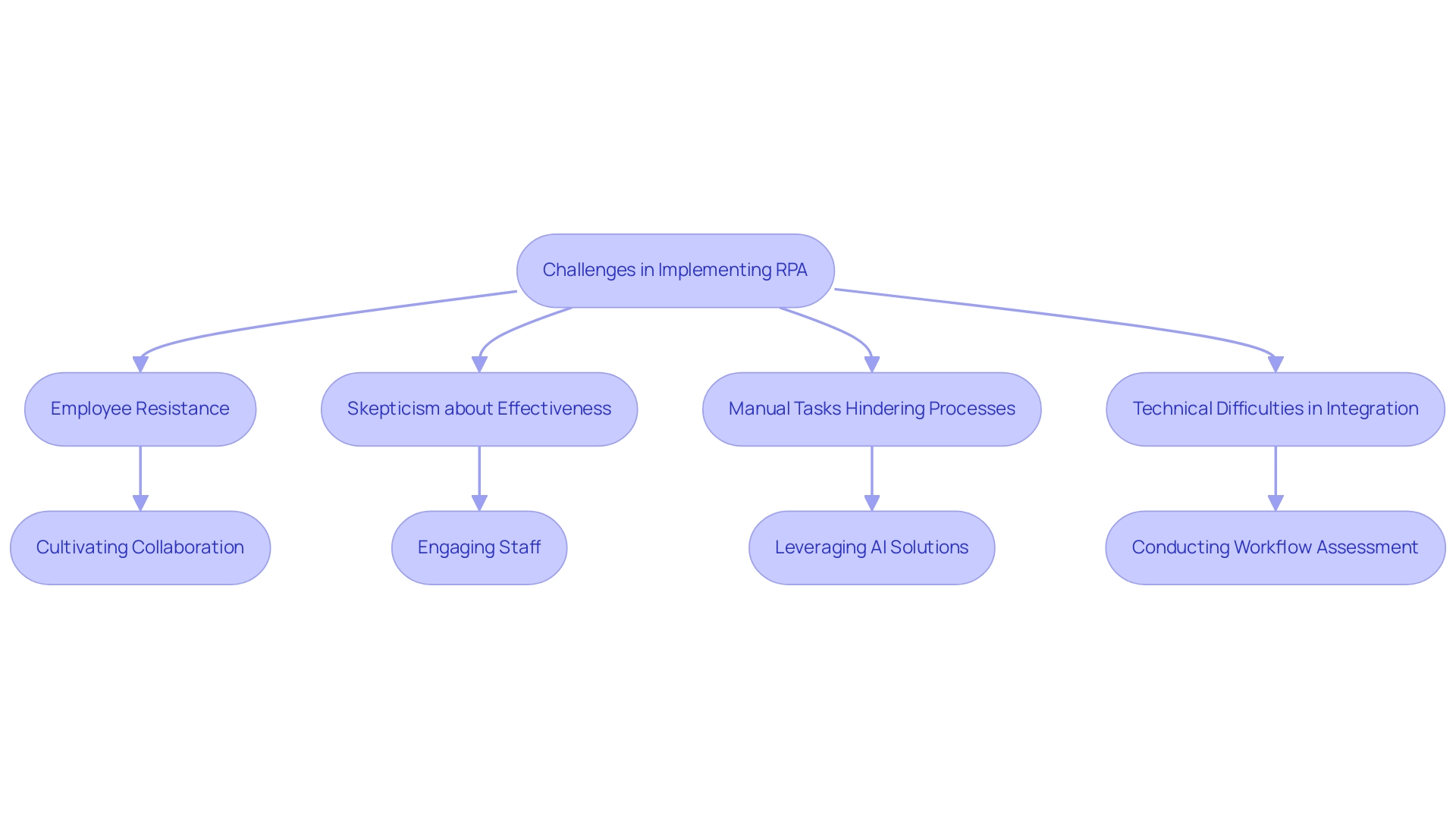
Future Trends of RPA in Railway Operations
As technology continues to advance, the future of RPA in train operations looks promising. By leveraging Robotic Process Automation alongside tailored AI solutions and Business Intelligence, organizations can automate manual workflows and significantly enhance efficiency. Tailored AI solutions complement RPA by providing data-driven insights that inform decision-making, while Business Intelligence transforms raw data into actionable strategies.
Emerging trends, such as the integration of artificial intelligence and machine learning with RPA, are expected to further elevate automation capabilities. For example, predictive analytics can be seamlessly combined with RPA to anticipate maintenance needs, thereby reducing downtime and improving safety. Furthermore, the rise of cloud-based RPA solutions offers greater flexibility and scalability for train operators.
Organizations that embrace these innovative trends will not only boost their operational efficiency but also position themselves as leaders in the industry, adept at adapting to changing market demands and customer expectations. Additionally, by addressing technology implementation challenges, organizations can ensure a smoother transition to automated processes, maximizing the benefits of RPA and AI integration.
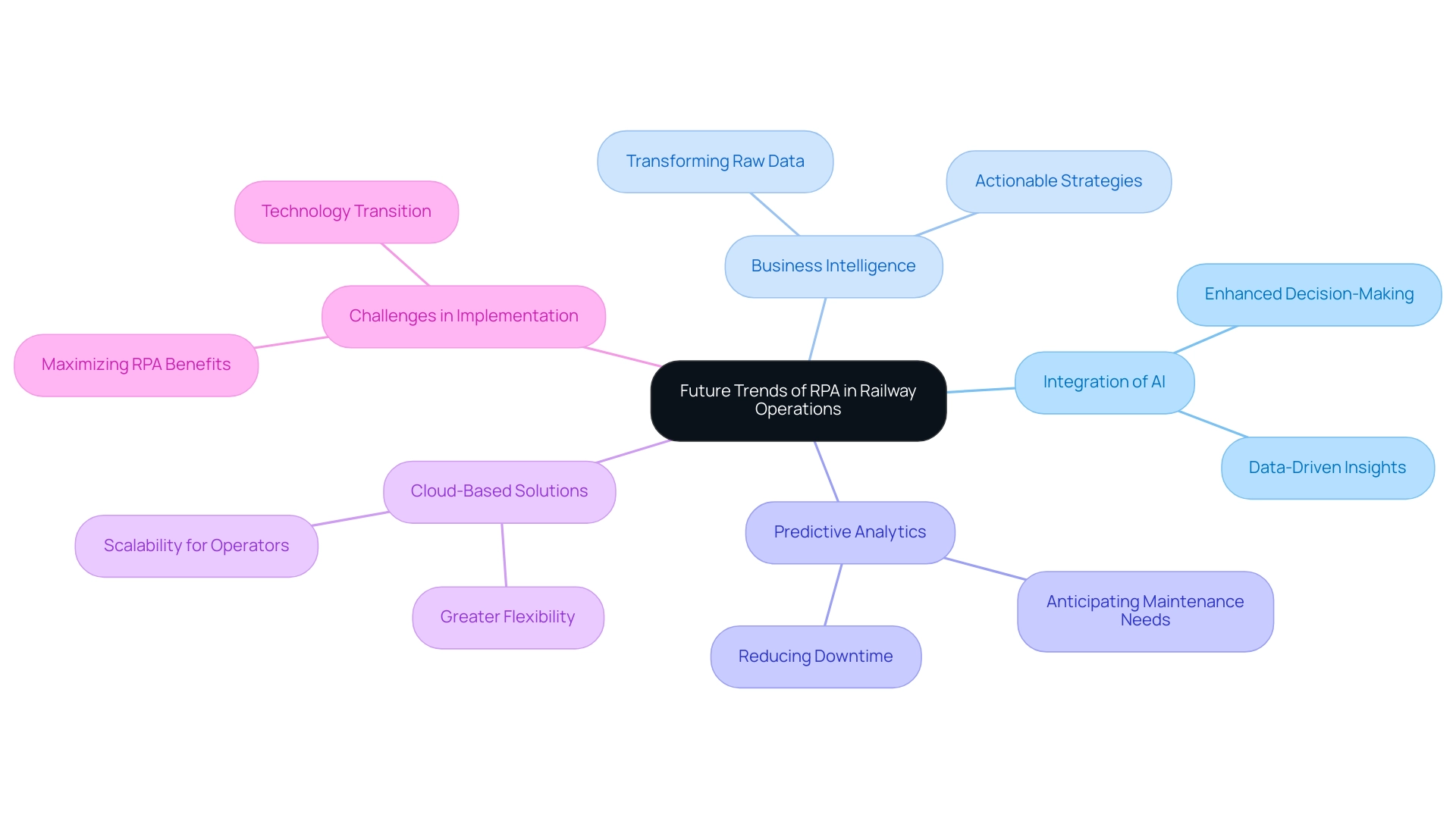
Case Studies of Successful RPA Implementation in Railways
Several organizations, including train operators, have successfully implemented RPA to enhance their operations. For example, a major transport operator in Europe utilized RPA to automate its ticketing and customer service processes, resulting in a 30% reduction in processing time and significantly improving customer satisfaction ratings. This mirrors the experience of a mid-sized company that faced challenges such as manual data entry errors and slow software testing.
By implementing GUI automation to streamline data entry and software testing, they achieved a remarkable 70% reduction in data entry errors and an 80% increase in workflow efficiency, with a return on investment (ROI) realized within six months. Additionally, an RPA railway in North America adopted RPA for inventory management, leading to a 25% decrease in stock discrepancies and improving supply chain efficiency.
These examples collectively highlight how RPA and GUI automation can transform operations across various sectors, driving efficiency and delivering tangible benefits while addressing workplace challenges such as repetitive tasks and outdated systems.
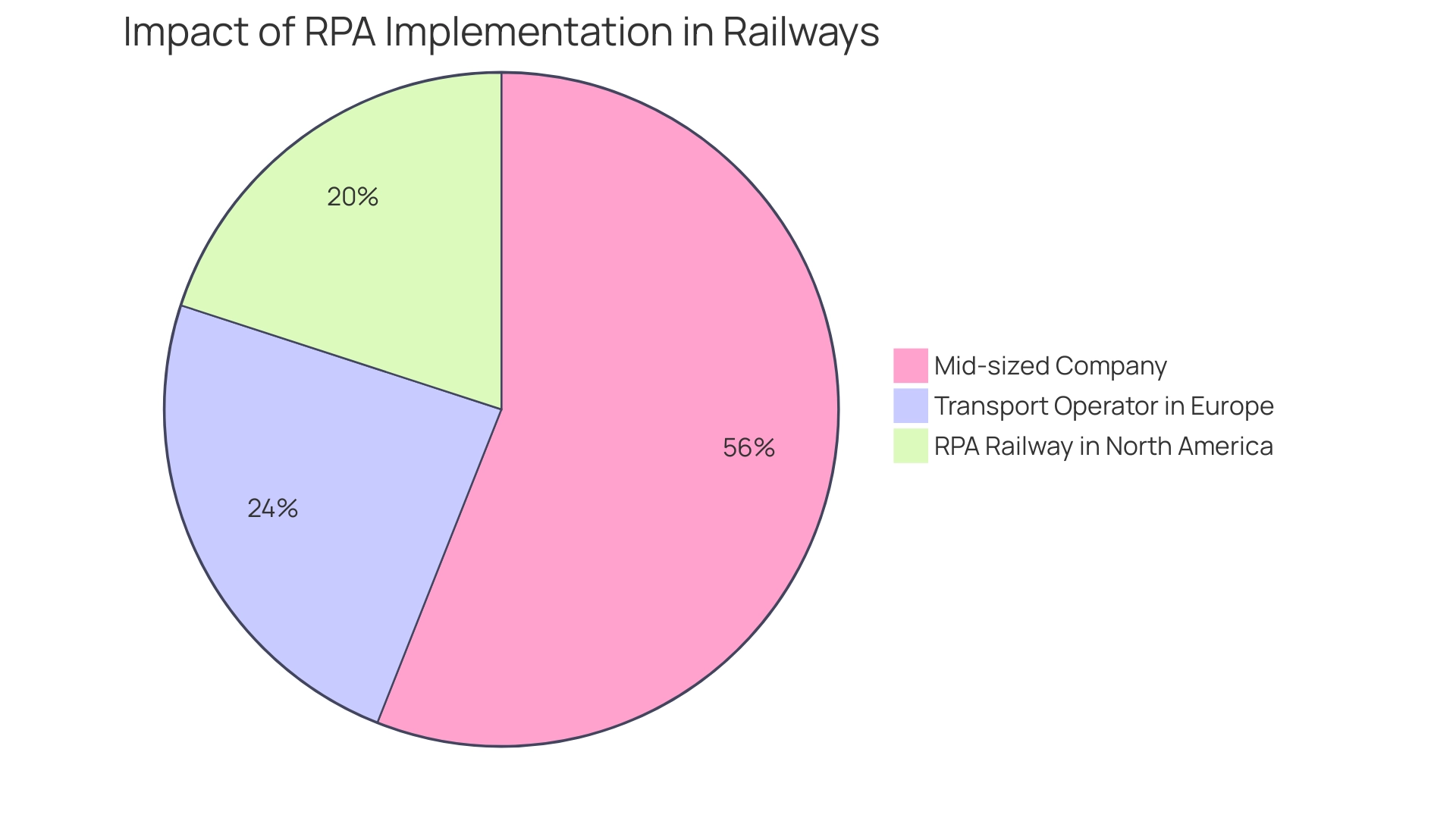
Conclusion
The integration of Robotic Process Automation (RPA) into railway operations is not just a technological advancement; it represents a fundamental shift towards enhanced efficiency and innovation. By automating repetitive tasks such as:
- Ticket processing
- Inventory management
- Compliance reporting
railways can drastically reduce human error and operational inefficiencies. This strategic use of RPA not only improves service reliability but also empowers employees to focus on higher-value initiatives, fostering a more motivated and productive workforce.
While challenges such as employee resistance and integration complexities exist, they can be effectively managed through clear communication and a culture of collaboration. By emphasizing the benefits of RPA and its role in driving operational excellence, organizations can facilitate smoother transitions and maximize the technology’s potential. Real-world case studies demonstrate significant improvements in processing times and customer satisfaction, reinforcing the argument that RPA is a game-changer in the railway sector.
Looking ahead, the future of RPA in railways is bright, with emerging trends such as AI integration and predictive analytics poised to further enhance automation capabilities. As railway operators adapt to these innovations, they will not only improve operational efficiency but also position themselves as leaders in a competitive landscape. Embracing RPA is essential for organizations aiming to thrive in the evolving market, ensuring they remain agile and responsive to changing customer demands and operational challenges. The time to act is now; the benefits of RPA are clear, and the journey towards a more efficient railway operation is well within reach.
Introduction
In an age where operational efficiency is paramount, organizations are increasingly turning to purchase-to-pay automation as a transformative solution. This innovative approach streamlines the procurement process from requisition to payment, minimizing manual errors and accelerating workflows. By harnessing cutting-edge tools like Robotic Process Automation (RPA) and advanced analytics, companies can not only enhance their efficiency but also gain real-time insights that empower strategic decision-making.
As businesses navigate the complexities of modern procurement, the implementation of automation stands out as a critical driver for:
1. Reducing costs
2. Improving compliance
3. Fostering stronger supplier relationships
The following exploration delves into the multifaceted benefits of purchase-to-pay automation, illustrating how it can propel organizations toward greater operational excellence and future readiness.
Enhancing Efficiency and Control through Purchase-to-Pay Automation
The efficiency of the purchasing workflow from requisition to payment is significantly enhanced by purchase-to-pay automation. By leveraging innovative tools like EMMA RPA and Microsoft Power Automate, organizations can automate repetitive tasks, substantially reducing the time spent on manual data entry and approvals. This not only speeds up the acquisition cycle but also reduces errors linked to manual processes.
Furthermore, purchase-to-pay automation solutions address critical challenges such as:
- Task repetition fatigue
- Staffing shortages
- Outdated systems
These solutions provide better control over spending. They offer real-time insight into procurement activities that allow entities to enforce compliance with budgets and policies effectively. As evidenced by case studies demonstrating substantial operational improvements—such as a 70% reduction in data entry errors and an 80% improvement in workflow efficiency—teams can focus on strategic decision-making rather than getting bogged down by administrative tasks, leading to enhanced productivity and operational efficiency.
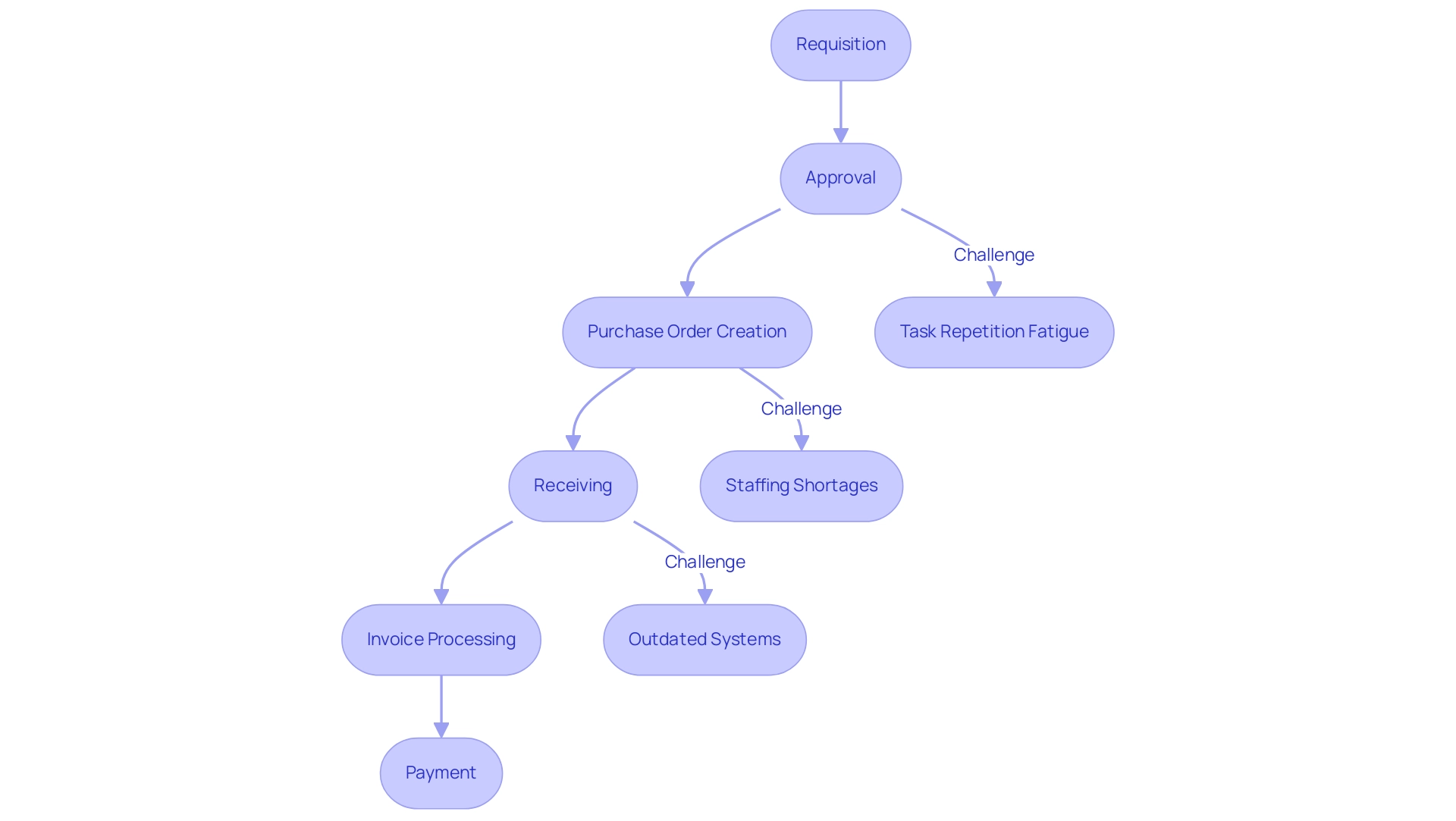
Future-Proofing Your Business with Purchase-to-Pay Automation
In the rapidly evolving business landscape, future-proofing your entity is essential. In this endeavor, purchase-to-pay automation acts as a cornerstone, empowering entities to adapt seamlessly to shifting market conditions and technological advancements. By leveraging advanced analytics and generative AI, organizations can extract actionable insights that inform strategic planning and bolster decision-making.
Automation tools not only enhance efficiency but also provide remarkable scalability, enabling businesses to adjust purchasing processes in alignment with their evolving needs. As noted by McKinsey, ‘GenAI applications in procurement have led to improved accuracy, reduced costs, and enhanced decision-making capabilities.’ This adaptability is crucial for maintaining competitiveness and responding swiftly to emerging challenges, ultimately driving innovation and growth in an increasingly dynamic environment.
Notably, SIRVA, a global provider of moving and relocation services, has experienced significant efficiency gains through the implementation of Zycus’ GenAI-based solutions, exemplifying how automation can future-proof businesses in practical terms. Furthermore, as companies struggle with manual workflows, leveraging Robotic Process Automation (RPA) can streamline operations, reduce errors, and free up teams for more strategic work. In this context, Small Language Models (SLMs) provide additional benefits, such as efficient data analysis and enhanced privacy, making them a cost-effective solution for enterprises.
IDC has acknowledged Zycus for its innovative AI solutions in the purchasing sector, highlighting the potential of these technologies to enhance efficiency. As we approach 2024, entities emphasizing purchase-to-pay automation and customized AI solutions will be better prepared to manage the intricacies of contemporary procurement, a feeling reflected by the increasing interest in the subject, demonstrated by the 660 views on the blog entry titled ‘The Future of Procurement Streamlining.
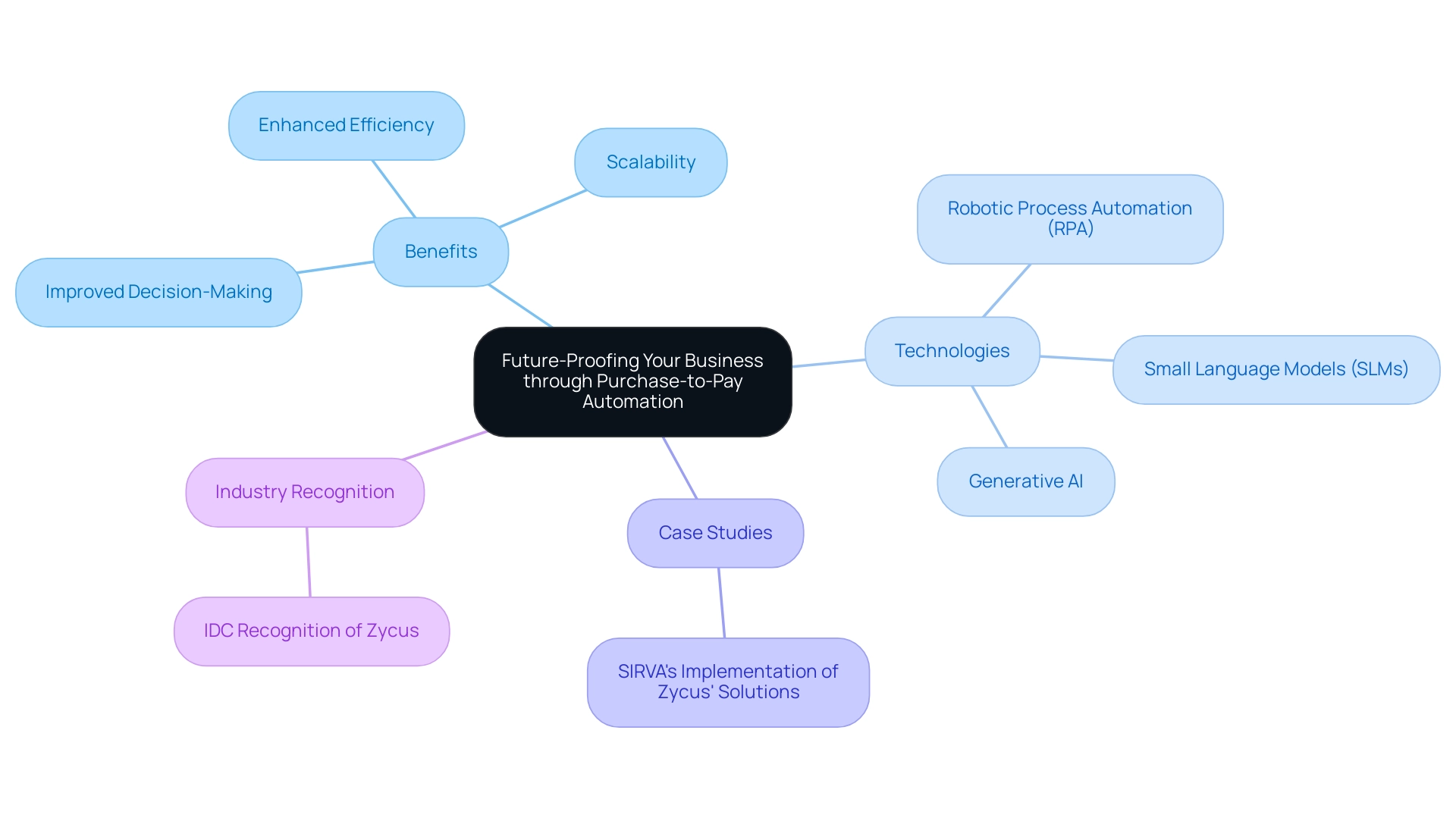
Reducing Costs and Enhancing Financial Control
One of the most significant advantages of purchase-to-pay automation in automating healthcare and financial processes, such as invoice processing and payment approvals, is its ability to reduce costs while enhancing financial control. By leveraging Robotic Process Automation (RPA) tools like EMMA RPA and Power Automate, businesses can enhance their purchase-to-pay automation, minimizing processing costs and mitigating the risk of late payment fees. Furthermore, the implementation of purchase-to-pay automation ensures improved accuracy in financial reporting, allowing finance teams to adhere to budgets and reduce discrepancies.
However, entities may face challenges in implementing these technologies, such as:
- Resistance to change
- The need for staff training
In today’s rapidly evolving AI landscape, having real-time data at their fingertips enables finance teams to make informed decisions that enhance cash flow management and optimize working capital. This financial clarity empowers entities to allocate resources more effectively and strategically, resulting in a healthier bottom line and driving business growth.
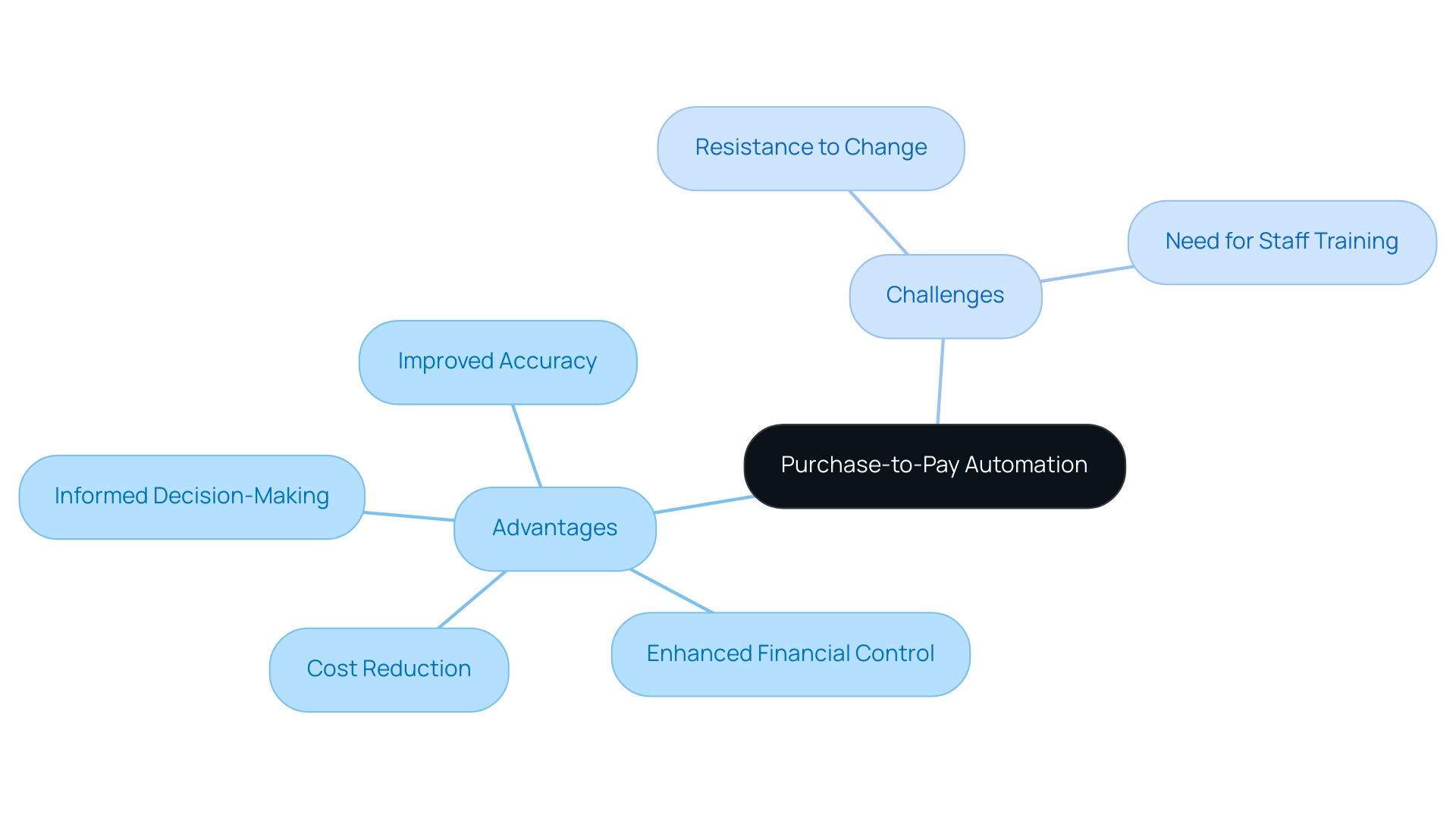
Improving Compliance and Risk Management
Purchase-to-pay automation serves as a robust instrument for improving compliance and risk management within purchasing processes. By utilizing purchase-to-pay automation through Robotic Process Automation (RPA), firms can ensure that all purchasing activities align with established policies and regulations, creating a reliable audit trail for every transaction. This capability not only simplifies tracking compliance and conducting audits, significantly improving organizational transparency, but also boosts operational efficiency.
Furthermore, these automated systems, through purchase-to-pay automation, enforce structured approval workflows and implement spending limits to effectively mitigate risks associated with unauthorized purchases and potential fraud. In an era where regulatory landscapes are constantly evolving, purchase-to-pay automation ensures that organizations remain compliant with the latest legal requirements, shielding them from potential penalties and cultivating a culture of accountability. As Marharyta Golobrodska notes, “Focusing on the topics of purchase-to-pay automation, P2P, AP, and supply chain efficiency is crucial for overall business efficiency and operational success.”
Moreover, as customized AI solutions and analytics continue to drive deeper insights, the ability to measure performance and optimize resource management becomes increasingly vital. Business Intelligence plays a key role here, transforming raw information into actionable insights that enable informed decision-making and drive growth. The case study titled ‘Procurement Analytics and Reporting in ERP‘ illustrates how effective analytics empower procurement teams to enhance their performance and operational efficiency—an essential consideration for any Director of Operations Efficiency.
Additionally, RPA addresses the challenges posed by manual, repetitive tasks, freeing up valuable resources for more strategic initiatives. In a rapidly evolving AI landscape, understanding and implementing these technologies is critical for maintaining a competitive edge.
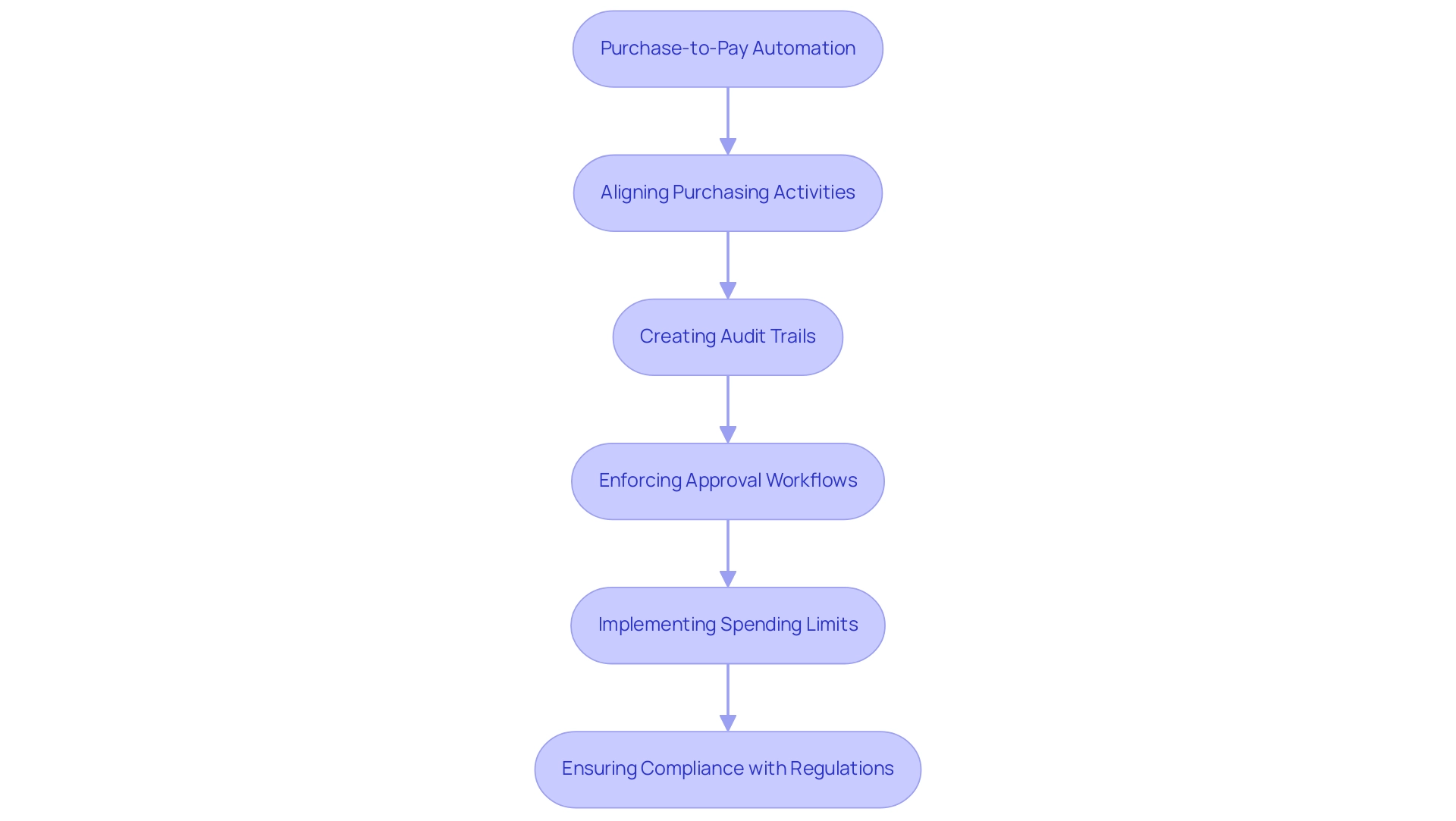
Enhancing Supplier Relationships
The implementation of purchase-to-pay automation can significantly enhance supplier relationships by streamlining communication and increasing transparency. Before implementing GUI processes, the mid-sized company faced challenges such as manual data entry errors and slow software testing, which hindered operational efficiency. With automated systems, organizations can ensure timely payment processing—a crucial factor for sustaining strong partnerships.
In fact, timely payments are known to build trust and reliability with suppliers, which can lead to improved negotiation terms and collaboration opportunities. Andrew Brethauer from ScalePad highlights this potential, stating, ‘with so much time spent on manual tasks, this is where automated processes emerge as a game changer.’ Furthermore, mechanization provides suppliers with real-time access to critical information regarding their invoices and payment statuses, fostering a more collaborative environment.
This improvement in communication not only strengthens relationships but also contributes to a more resilient and efficient supply chain. Additionally, insights from a case study on GUI automation highlight that businesses have reduced data entry errors by 70% and accelerated testing processes by 50%, illustrating how automation specifically addresses the challenges of manual data entry and slow testing. Research shows that 50% of the time, the first to respond gets the sale, underscoring the importance of timely payments and responsiveness in supplier relationships.
As procurement leaders, it is vital to prioritize optimizing purchase-to-pay automation processes to enhance supplier relationships, reduce costs, and improve overall efficiency. By leveraging RPA and tailored AI solutions, companies can transform P2P processes into true value-creation drivers through purchase-to-pay automation, enabling informed decision-making and driving growth.
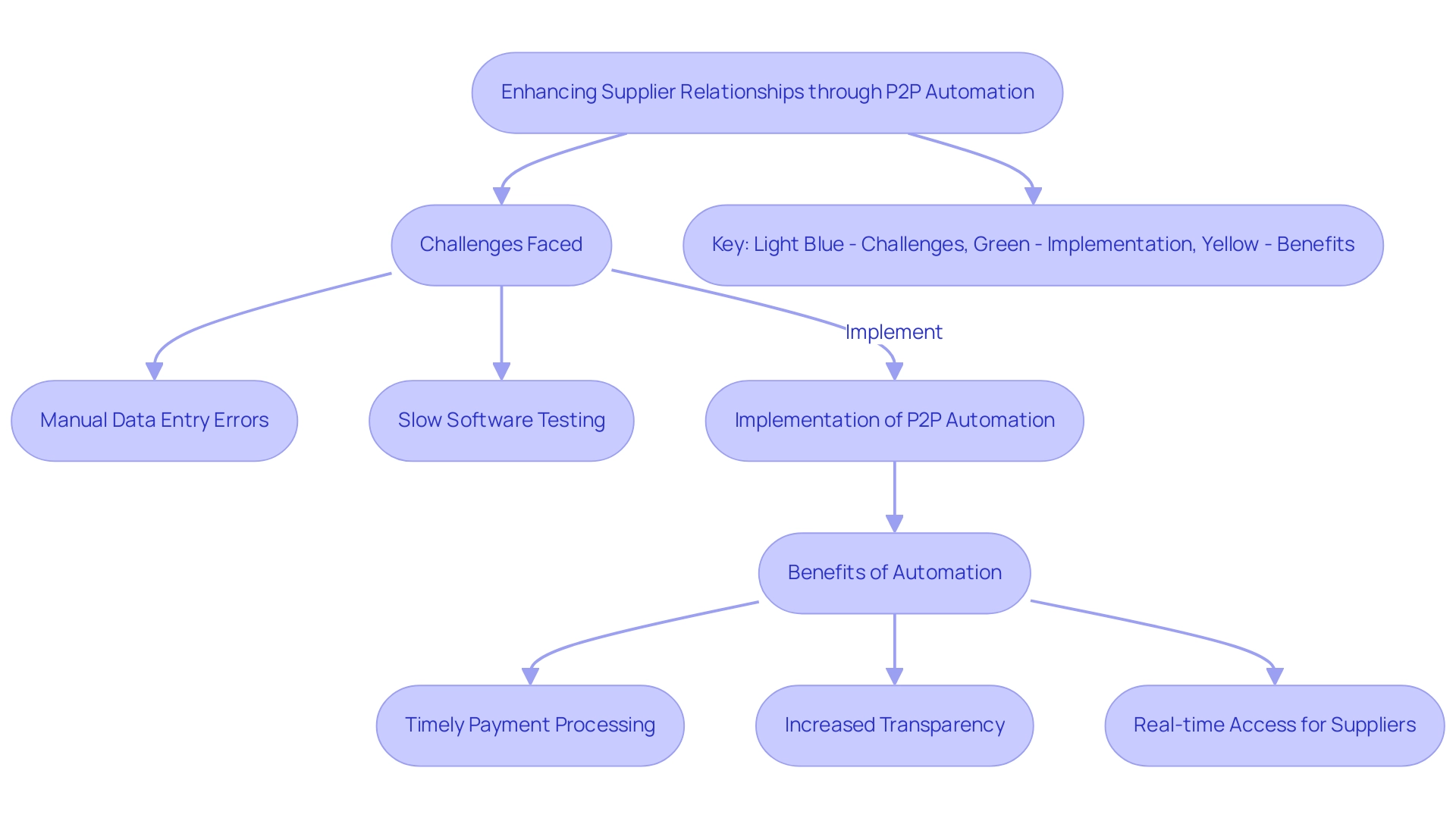
Driving Data-Driven Decision Making
Purchase-to-pay automation allows entities to leverage information for informed decision-making. By utilizing purchase-to-pay automation to automate information gathering and analysis, organizations can gain insights into:
- Spending patterns
- Supplier performance
- Purchasing efficiency
This data-driven approach enables decision-makers to identify areas for improvement and make strategic adjustments to procurement strategies using purchase-to-pay automation.
Our Power BI services, including:
- The 3-Day Sprint for rapid report creation
- The General Management App for comprehensive oversight
enhance reporting and actionable insights. Additionally, our Robotic Process Automation (RPA) solutions, featuring EMMA RPA and Microsoft Power Automate, address challenges such as:
- Task repetition fatigue
- Staffing shortages
- Outdated systems
These solutions streamline workflows and improve employee morale by alleviating repetitive tasks. Automated reporting tools offer real-time insight into key metrics, enabling entities to respond swiftly to changing market conditions.
Moreover, our tailored Small Language Models (SLMs) provide effective information analysis and improved privacy, ensuring that entities can implement AI securely and affordably. By harnessing the power of data and innovative tools, organizations can enhance their competitive edge and drive continuous improvement in their purchase-to-pay automation processes.
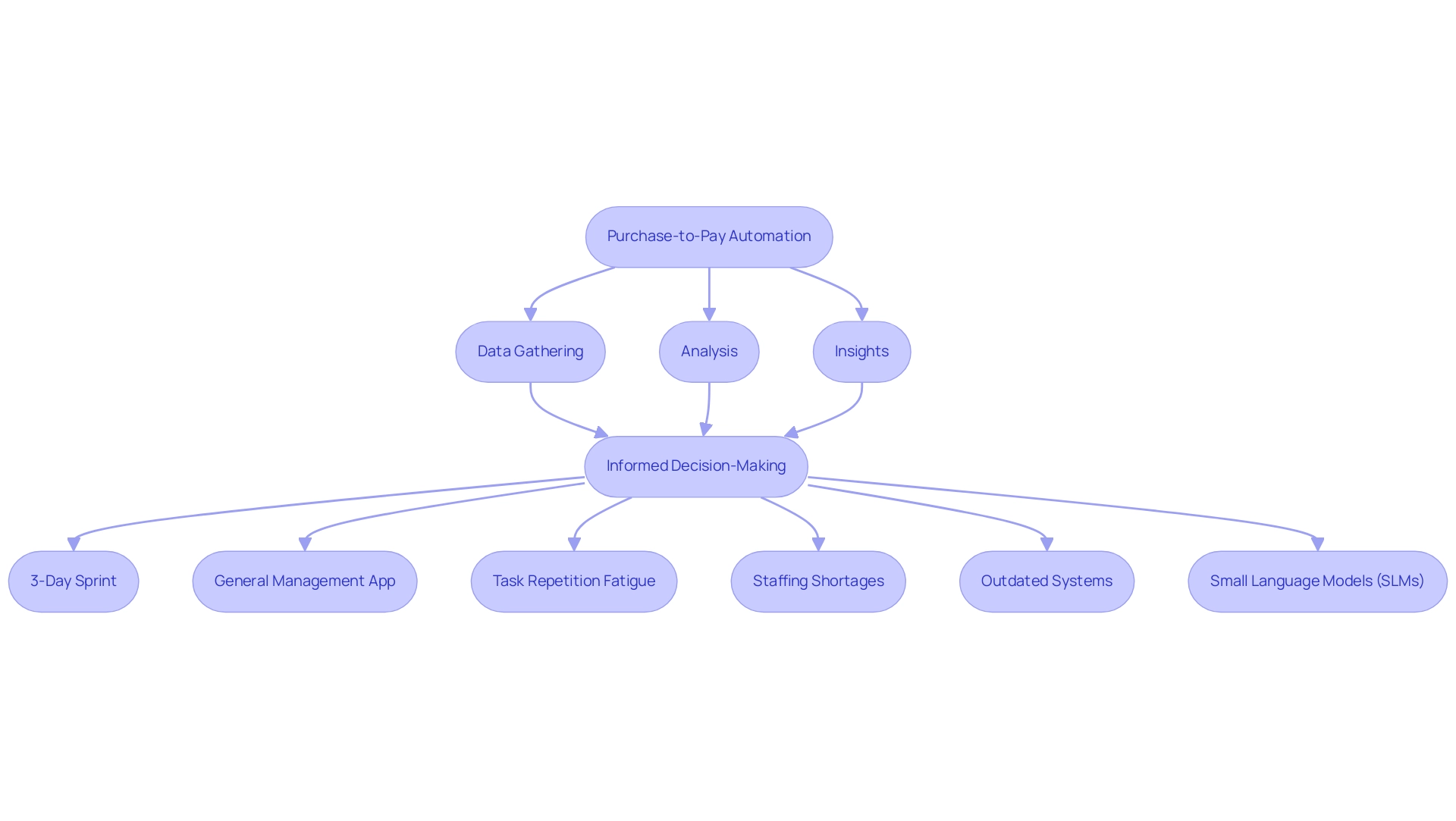
Facilitating Employee Engagement and Satisfaction
Implementing purchase-to-pay automation can significantly enhance employee engagement and satisfaction. By reducing the burden of manual, repetitive tasks, employees can focus on more strategic and value-adding activities, which boosts job satisfaction and fosters a culture of innovation and creativity within teams. Furthermore, automation, particularly through Robotic Process Automation (RPA) and GUI technologies, improves the overall employee experience by providing user-friendly interfaces and streamlined processes.
This makes it easier for employees to navigate procurement activities effectively. For instance, a recent case study demonstrated that a healthcare entity reduced invoice processing time by 60%, leading to a measurable ROI within six months. As organizations invest in tailored purchase-to-pay automation solutions, they not only enhance their workforce’s experience but also mitigate risks associated with the investment, ultimately resulting in higher retention rates and a more motivated team, all while ensuring a risk-free approach to achieving measurable ROI.
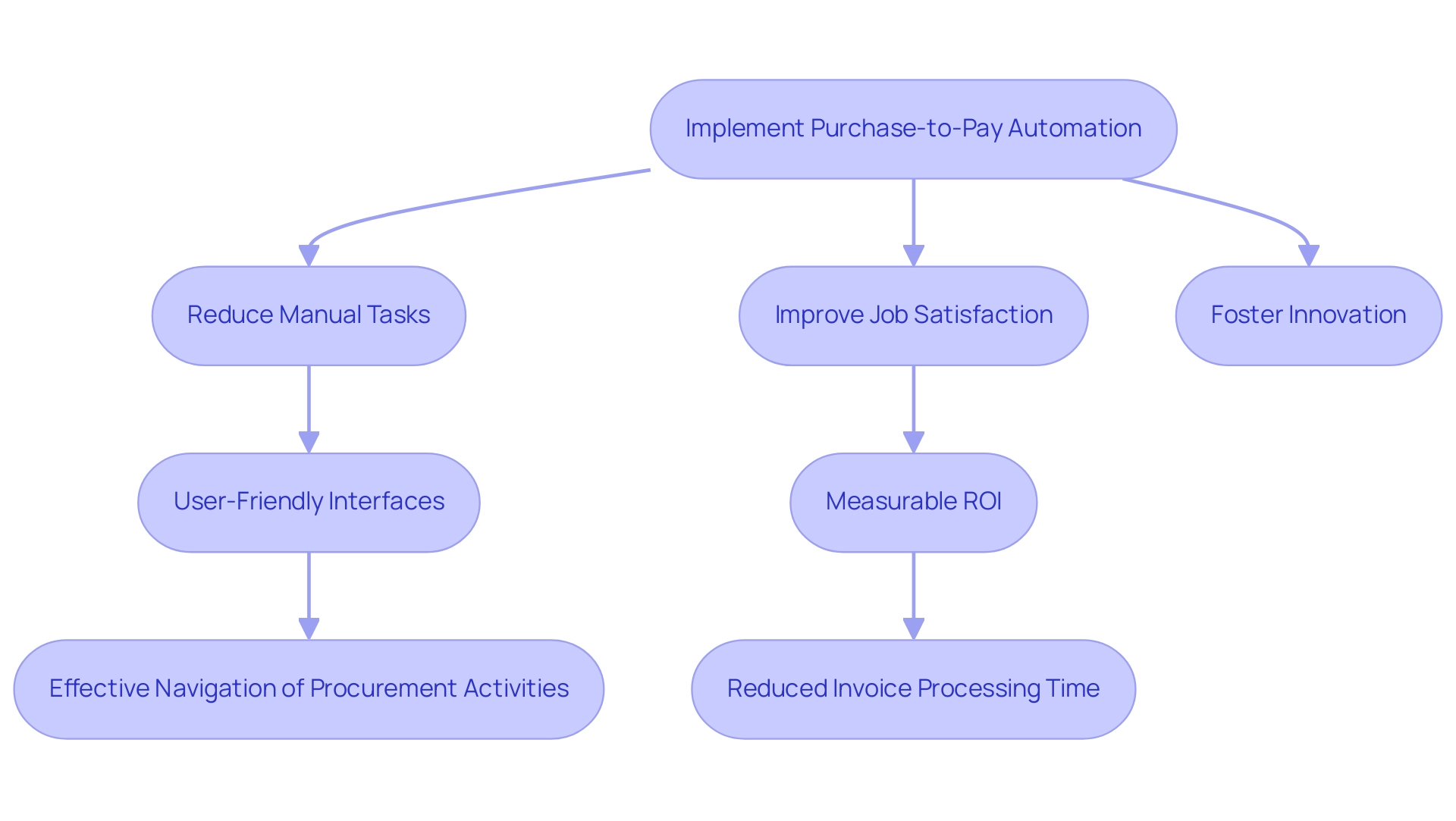
Conclusion
Embracing purchase-to-pay automation presents a powerful opportunity for organizations to enhance their operational efficiency and strategic decision-making. By streamlining the procurement workflow from requisition to payment, automation minimizes manual errors and accelerates processes, allowing teams to focus on high-value tasks. The use of advanced tools such as Robotic Process Automation (RPA) and analytics not only improves accuracy and compliance but also fosters stronger supplier relationships, ultimately driving cost reductions and enhancing financial control.
As businesses face evolving market conditions, the adaptability offered by purchase-to-pay automation becomes crucial for future-proofing operations. The insights gained from data analytics enable organizations to make informed decisions, ensuring they remain competitive and innovative. Moreover, by addressing manual workflow challenges, automation empowers finance teams to optimize cash flow management and resource allocation, leading to improved bottom-line results.
In summary, the integration of purchase-to-pay automation is not just a technological upgrade; it is a strategic initiative that enhances employee engagement, improves compliance, and fosters a culture of accountability. Organizations that prioritize this transformation are better positioned to navigate the complexities of modern procurement, ultimately achieving operational excellence and sustainable growth in an increasingly dynamic landscape. The time to act is now—embracing automation can unlock significant value and propel organizations toward a more efficient and resilient future.
Introduction
In the rapidly evolving landscape of automation, Robotic Process Automation (RPA) contracts emerge as a cornerstone for organizations seeking to harness the power of technology while mitigating risks. These agreements not only clarify the expectations and responsibilities of all parties involved but also serve as a safeguard against the uncertainties that accompany automation projects.
By establishing detailed frameworks that outline deliverables, timelines, and performance metrics, businesses can ensure that their RPA initiatives align seamlessly with operational goals. As organizations navigate the complexities of automation, understanding the intricacies of RPA contracts becomes essential for fostering accountability, driving efficiency, and ultimately achieving a robust return on investment.
This article delves into the critical elements of RPA contracts, the challenges they present, and best practices for negotiation, offering valuable insights for those committed to transforming their operations through automation.
Introduction to RPA Contracts: Definition and Importance
RPA contracts are formal documents that detail the terms and conditions for deploying Robotic Process Automation solutions within an organization. You only pay if we provide what was promised, reinforcing our commitment to risk-free ROI-driven services. These RPA contracts are crucial as they define the scope of work, responsibilities, and expectations for all parties involved, including vendors and clients.
The significance of RPA contracts lies in their ability to establish clear guidelines that help mitigate risks associated with automation projects. By clearly defining deliverables, timelines, and performance metrics, organizations can ensure that RPA implementations align with their operational goals and deliver the anticipated benefits. Furthermore, RPA contracts foster accountability and provide a framework for resolving disputes should they arise, making them an essential component of any successful RPA initiative.
Together, we will:
1. Assess a process of yours that you would like to automate,
2. Calculate the efforts required to automate the process,
3. Estimate the time savings you will achieve after the project and calculate the ROI, and
4. Automate the process, executed by a certified professional on our side.
Additionally, as shown in successful case studies, adopting GUI processes not only reduces manual workflow bottlenecks but also enhances productivity and operational efficiency.
With an emphasis on ROI, our risk-free solutions enable enterprises to utilize RPA effectively, fostering business growth through enhanced data-driven insights and optimized operations.
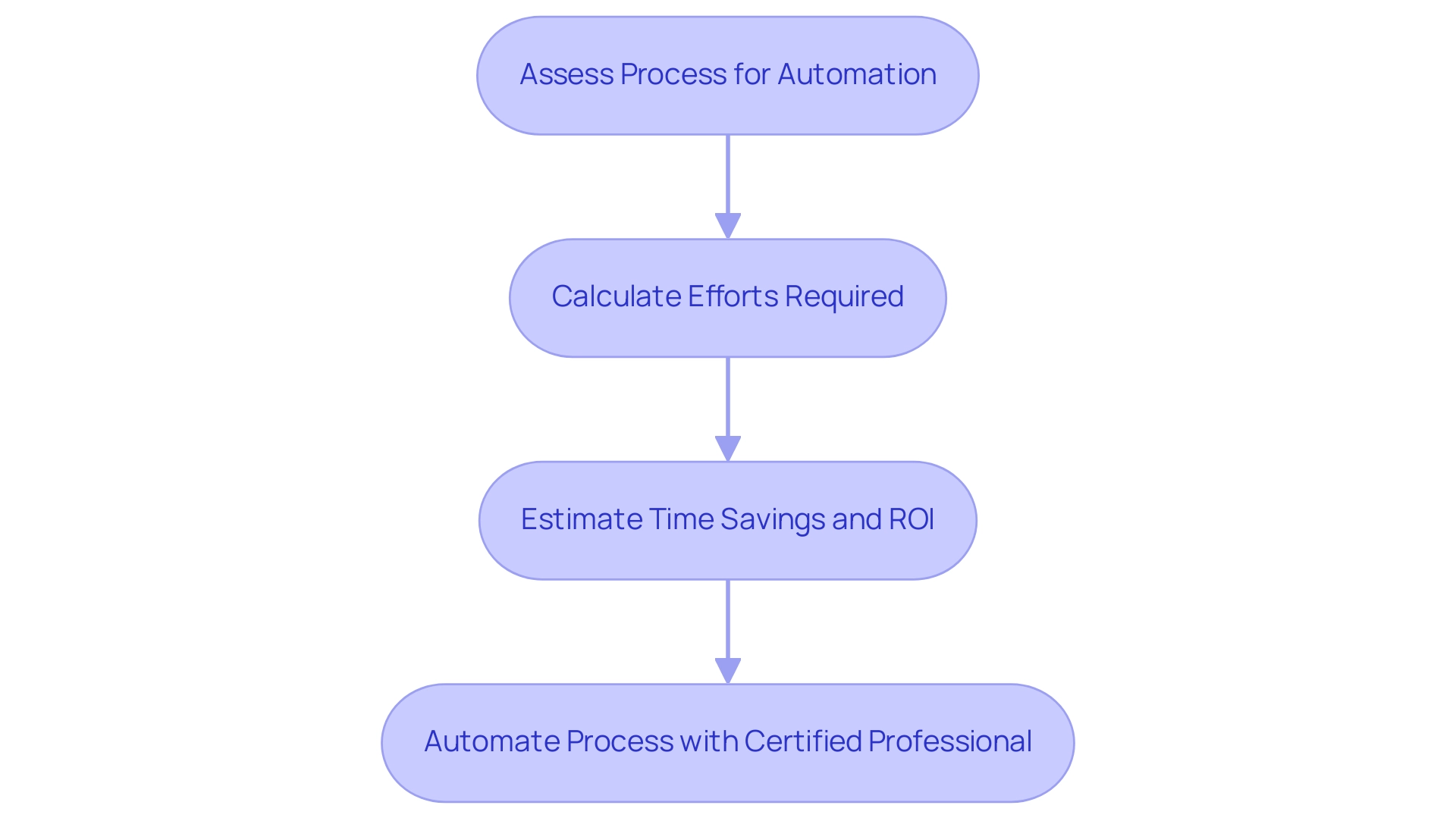
Understanding Arbitration in RPA Contracts: Binding vs. Non-Binding Decisions
Arbitration in RPA contracts acts as a mechanism for resolving disputes that may arise during the implementation of robotic process automation. With the rise of innovative tools like EMMA RPA and Microsoft Power Automate, it is essential for companies to address potential conflicts efficiently. RPA solutions tackle challenges such as task repetition fatigue and staffing shortages, which can hinder operational efficiency.
There are two primary types of arbitration:
- Binding arbitration
-
Binding arbitration means that the decision made by the arbitrator is final and enforceable by law, leaving no room for appeal. This is crucial for entities that prefer a definitive resolution to disputes without protracted litigation, especially when implementing transformative RPA solutions aimed at enhancing efficiency and employee morale.
-
Non-binding arbitration
- Conversely, non-binding arbitration allows for the option to pursue further legal action if one party is dissatisfied with the outcome. Recognizing these distinctions is crucial for companies when they negotiate RPA contracts. A well-defined arbitration clause in RPA contracts can save time and resources, ensuring that any disagreements are resolved efficiently, thus maintaining the momentum of automation projects.
By incorporating clear arbitration terms, entities can protect their interests and foster a collaborative environment, ultimately enhancing the success of their RPA initiatives and driving operational efficiency in a rapidly evolving AI landscape. To learn more about how our RPA solutions can benefit your organization, book a free consultation today.
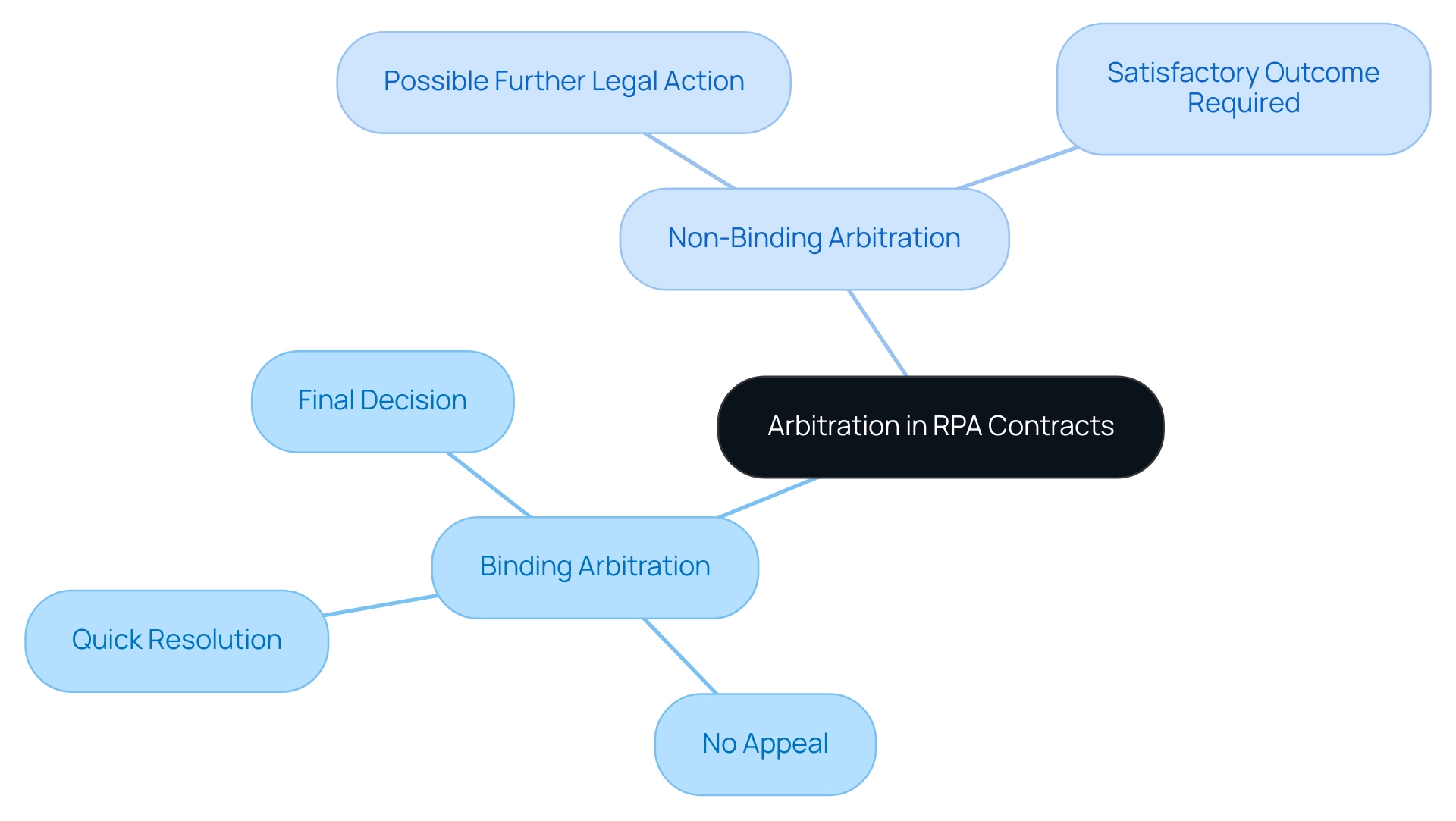
Key Elements of RPA Contracts: What to Include
Drafting effective RPA contracts requires careful consideration of several vital elements to ensure clarity and protection for all stakeholders. For instance, a direct-to-consumer retailer struggling with operational inefficiencies due to outdated systems can significantly benefit from well-structured RPA contracts. These RPA contracts should outline the scope of work, performance metrics, timelines, and payment terms, providing a clear structure for the automated process.
It’s crucial to define the roles and responsibilities of each party, including any third-party vendors, to foster accountability and collaboration. Moreover, safeguarding intellectual property rights connected to the mechanization processes is crucial to avoid future conflicts. Provisions for change management and termination clauses are also necessary to safeguard against unforeseen circumstances during implementation.
By integrating these essential components, entities can establish strong RPA contracts that facilitate successful initiatives while mitigating risks. For example, the case study ‘Streamlining Operations with GUI Automation’ highlights how a mid-sized company improved efficiency by automating repetitive tasks, which reduced data entry errors by 70% and accelerated testing processes by 50%. RPA solutions can also alleviate staffing shortages by automating mundane tasks, allowing employees to focus on higher-value work, which in turn aids in talent retention.
As Alan Hester, President of Nividous, aptly states, ‘Embracing RPA transcends being merely a choice; it represents a strategic move toward a future characterized by agility, efficiency, and innovation.’ This strategic foresight is particularly relevant for retailers and other organizations facing operational challenges, empowering them to navigate obstacles effectively and enhance overall productivity through RPA solutions.
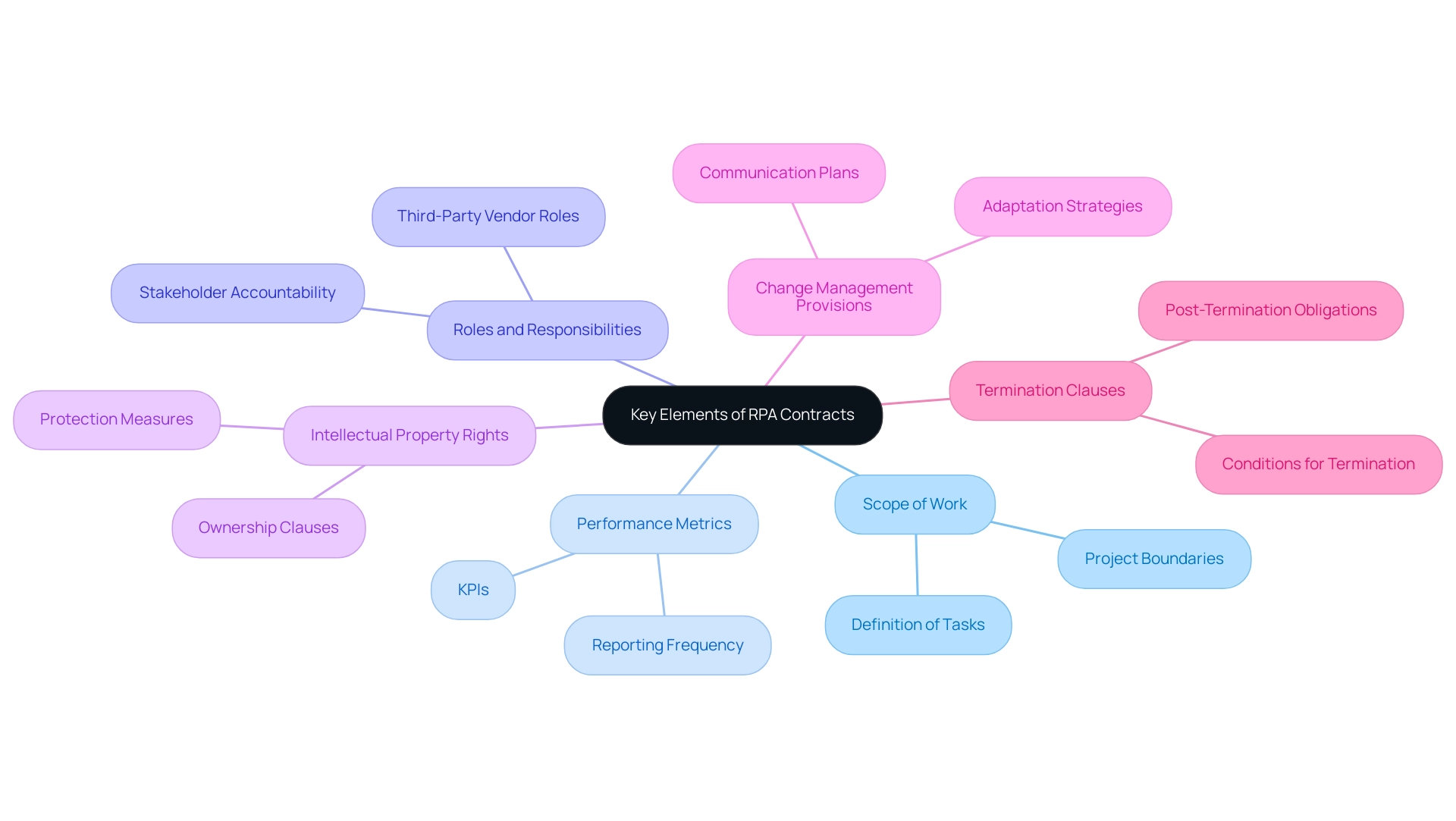
Challenges and Risks Associated with RPA Contracts
RPA contracts play a crucial role in the success of automated initiatives, yet they present challenges that necessitate careful navigation. A prominent concern is scope creep, where project requirements can expand uncontrollably beyond the initial agreement, leading to inflated costs and delays. This is a significant issue, as studies show that 70% of automation projects face scope management challenges.
Additionally, aligning stakeholder expectations can be difficult, often resulting in friction that hampers progress. Concerns about job displacement may also lead to employee resistance, complicating the implementation of new technologies. Alan Hester, President of Nividous, emphasizes this, stating,
Embracing RPA transcends being merely a choice; it represents a strategic move toward a future characterized by agility, efficiency, and innovation.
For instance, a high-tech manufacturer achieved annual savings exceeding $90,000 by automating over 20 business processes, showcasing the advantages of effective RPA management. To mitigate the risks associated with scope creep in RPA contracts, organizations should prioritize establishing clear communication channels and robust change management strategies. Regular reviews and updates to the RPA contracts are essential to accommodate evolving needs and prevent misunderstandings, ensuring that the automation journey remains aligned with initial objectives.
Furthermore, integrating tailored AI solutions with RPA can significantly enhance operational efficiency by addressing specific business challenges and providing deeper insights. A leading conglomerate faced challenges in configuring security devices and troubleshooting alerts through manual processes. By leveraging RPA alongside Business Intelligence tools, they not only automated these tasks but also extracted actionable insights from data, demonstrating the real-world impact of addressing RPA agreement challenges.
By proactively tackling these issues and utilizing a combination of RPA, tailored AI solutions, and Business Intelligence, businesses can harness the full potential of RPA, transforming operational efficiency and driving productivity forward.
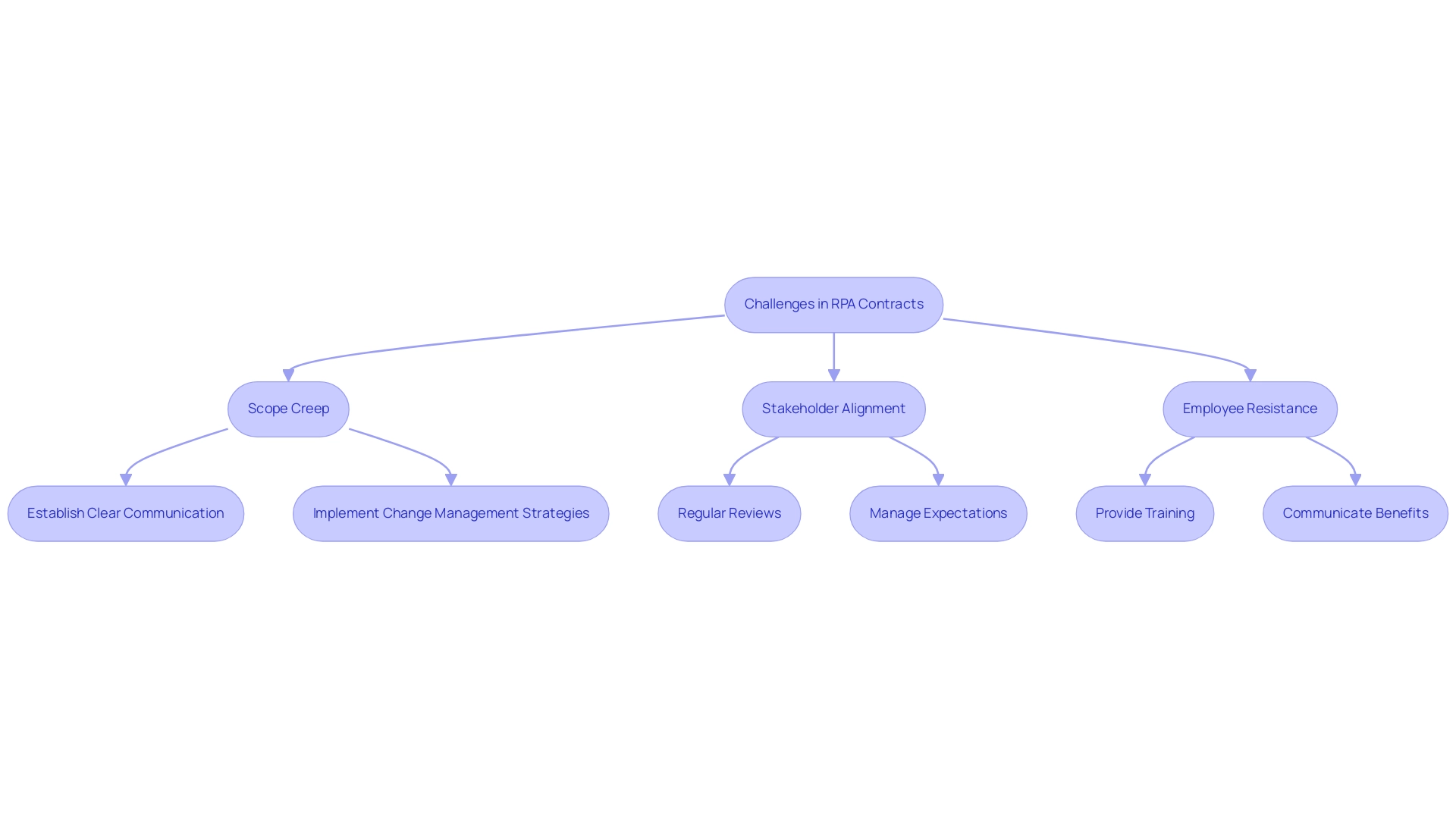
Best Practices for Negotiating RPA Contracts
Negotiating RPA contracts requires careful consideration and strategic planning in the context of enhancing operational efficiency and productivity. Organizations should begin by conducting thorough research on potential vendors, understanding their capabilities and past performance. It’s essential to establish clear goals and expectations that align with the broader objectives of automating manual workflows and enhancing productivity through RPA, which can lead to significant cost reductions.
During negotiations, entities should advocate for favorable terms that support these goals, including:
– Performance guarantees
– Flexible change management provisions
Additionally, leveraging Business Intelligence is crucial, as it can transform data into actionable insights that inform negotiation strategies and decision-making. Seeking legal advice to review agreement terms and ensure adherence to relevant regulations is also essential.
By following these best practices and integrating insights from tailored AI solutions and Business Intelligence, organizations can secure RPA contracts that effectively bolster their RPA initiatives and drive significant operational improvements while overcoming challenges in the rapidly evolving AI landscape.
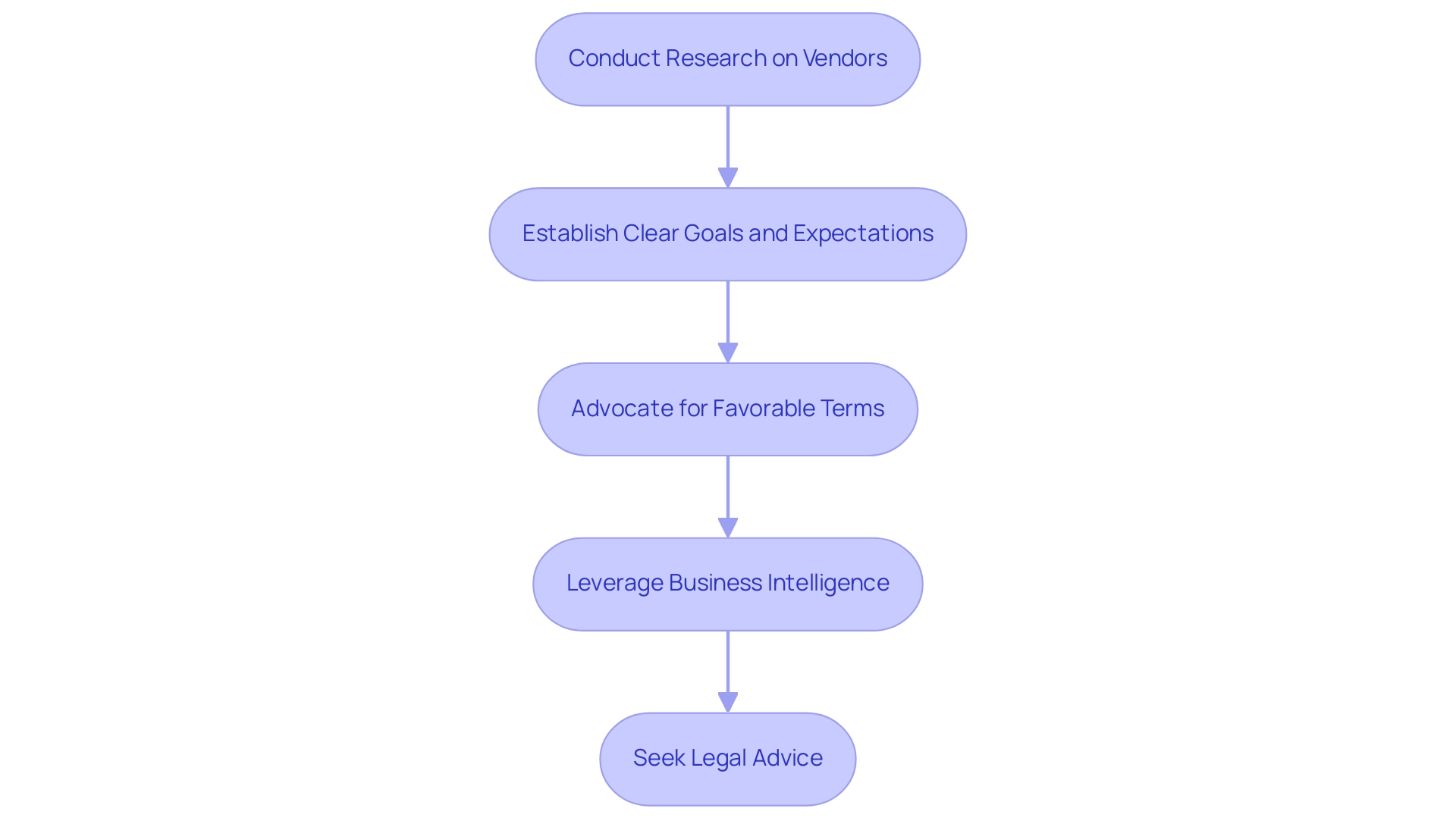
Conclusion
Robotic Process Automation (RPA) contracts are not merely bureaucratic documents; they are foundational elements that can make or break an automation initiative. By clearly defining the scope of work, responsibilities, and performance metrics, organizations can mitigate risks and ensure that automation projects align with operational goals. The significance of these contracts lies in their ability to foster accountability and provide a structured approach to resolving disputes, ultimately paving the way for successful implementations.
Navigating the complexities of RPA contracts requires a keen understanding of potential challenges, such as scope creep and stakeholder alignment. Organizations that proactively address these issues by establishing effective communication and change management strategies can safeguard their automation investments. Incorporating essential elements into RPA contracts, such as intellectual property rights and termination clauses, further enhances protection and clarity for all parties involved.
Best practices in negotiating RPA contracts emphasize the importance of research, clear goal-setting, and leveraging insights from Business Intelligence. By advocating for terms that support an organization’s broader objectives and seeking legal counsel, businesses can secure agreements that not only protect their interests but also drive operational efficiency. As organizations embrace RPA, the focus should remain on transforming challenges into opportunities for growth, ultimately leading to improved productivity and innovation in a competitive landscape.
Introduction
In the realm of modern business operations, the quest for efficiency is paramount. As organizations navigate the complexities of manual workflows, AWS Batch emerges as a transformative solution, streamlining batch computing workloads in the cloud. This fully managed service not only optimizes resource allocation but also integrates seamlessly with APIs to automate processes, ultimately empowering teams to focus on strategic initiatives rather than repetitive tasks.
Coupled with the insights derived from Business Intelligence, AWS Batch presents a robust framework for driving operational excellence. This article delves into the intricacies of AWS Batch, offering a comprehensive guide on:
- Job submission via API Gateway
- IAM configuration
- Monitoring strategies
- Best practices to harness its full potential
By understanding and implementing these strategies, businesses can enhance productivity and achieve a competitive edge in an increasingly data-driven landscape.
Understanding AWS Batch and API Integration
Manual, repetitive tasks can significantly hinder operational efficiency, leading to wasted time and resources. AWS is a robust, fully managed service that allows organizations to efficiently execute batch computing tasks in the AWS Cloud. By intelligently allocating the optimal quantity and type of compute resources—whether CPU or memory—AWS handles the specific needs of the submitted tasks, thereby alleviating the challenges associated with manual workflows.
This capability significantly enhances operational efficiency and resource utilization, making it an excellent complement to Robotic Process Automation (RPA) strategies aimed at automating these manual tasks.
The integration of APIs further enhances the usability of AWS services. Developers can programmatically submit tasks to trigger API actions, automating workflows and triggering processes based on a variety of events. Comprehending how AWS processes interact with APIs is essential for maximizing this potential and improving business productivity through customized AI solutions.
Additionally, the role of Business Intelligence is vital in transforming data into actionable insights, enabling informed decision-making that drives growth. The AWS API Gateway serves as a pivotal bridge, allowing you to create, publish, maintain, monitor, and secure APIs at scale. By utilizing API Gateway, you can effortlessly trigger API for AWS processing tasks from your applications or other AWS services, streamlining operations and enhancing productivity.
Notably, the path override for the AWS Job submitJob action is /v1/submitjob, and while the API Gateway resource method can be either GET or POST, it is essential that the integration request uses POST for the AWS Job submitJob call.
A pertinent case study titled ‘Submitting an AWS Task from AWS API Gateway‘ examines how to initiate AWS tasks using AWS API Gateway, emphasizing the difficulties encountered in comprehending the integration process and the particular settings needed. The author successfully documented the necessary configurations, including the integration type, HTTP method, and mapping templates, to streamline the process for others. This integration not only simplifies job submission but also enables more responsive and automated responses to business needs, empowering your team to focus on strategic, value-adding work.
Furthermore, in a rapidly evolving AI landscape, understanding the right solutions for your business needs is crucial, and AWS services, combined with RPA and Business Intelligence, offers a robust framework for achieving operational excellence.
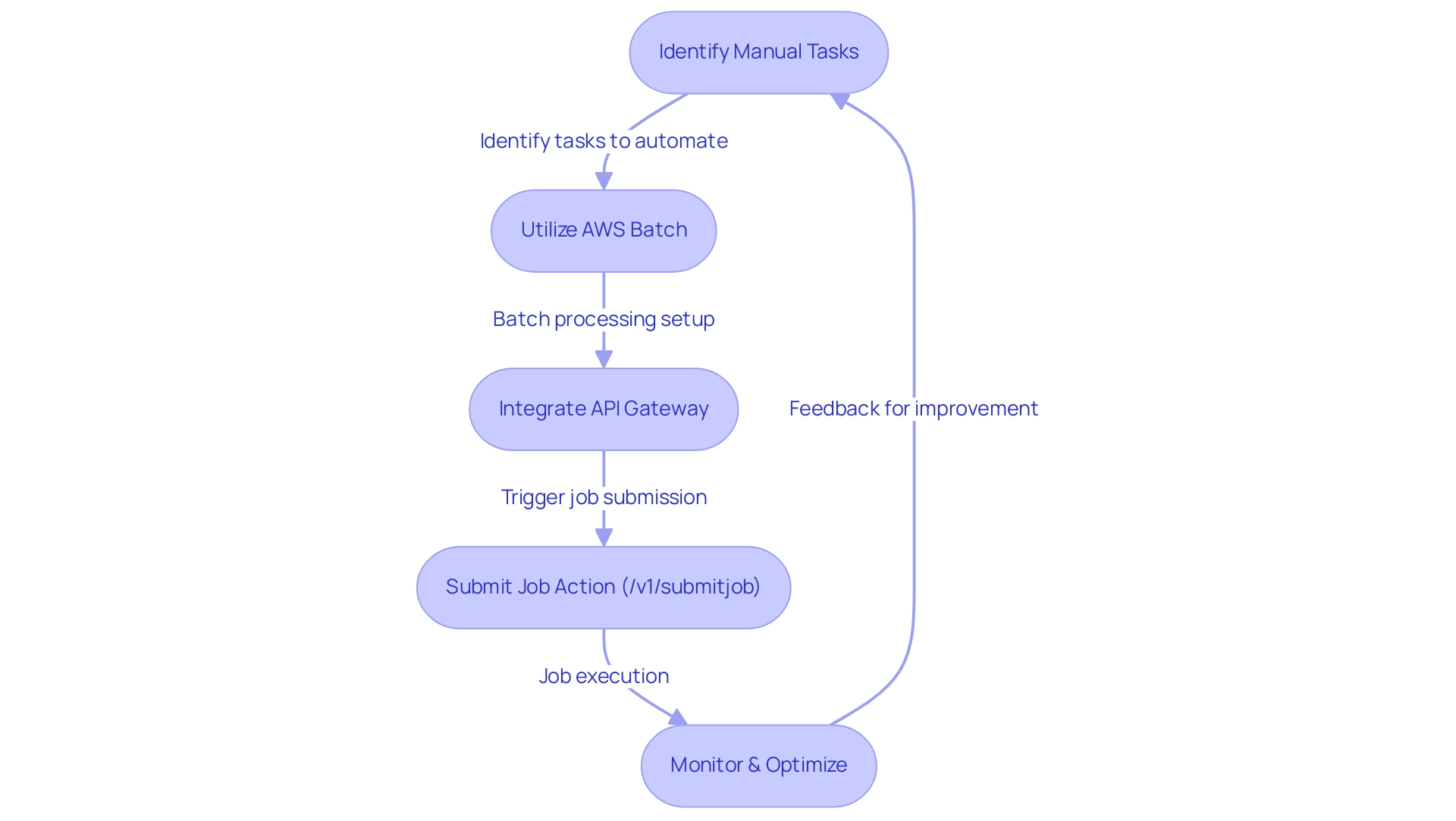
Step-by-Step Process for Submitting AWS Batch Jobs via API Gateway
To automate the submission of AWS Batch jobs via the API Gateway, follow these structured steps:
-
Create an AWS Job Definition: Start by developing a job definition that outlines the execution parameters for your job. Access the AWS console, create a new job definition, and configure key attributes such as job name, container image, and resource allocation.
-
Set Up API Gateway: Access the AWS Management Console and navigate to the API Gateway service. Initiate the creation of a new API, selecting the REST API option, and tailor the configuration to meet your operational needs. Depending on your use case, choose between regional or edge-optimized APIs.
-
Create a Resource and Method: Within your API, establish a new resource, such as
/submit-job. Subsequently, generate a method (e.g., POST) for this resource. For the method settings, select AWS Service as the integration type and configure it to interface with AWS Processing. -
Configure Method Request: Define the request parameters and body that your API will accept. Ensure these include essential job parameters like job name, job queue, and job definition to facilitate seamless processing.
-
Set Up Integration Request: Map the incoming requests from the API Gateway to the AWS Processing API. It’s crucial to ensure that the request body adheres to the format expected by the AWS
SubmitJobAPI call, enabling efficient job submission. -
Deploy the API: After finalizing your API configuration, deploy it to a designated stage (e.g., production). This deployment will create an endpoint that you can utilize to initiate AWS tasks efficiently.
-
Test the API: Utilize tools such as Postman or curl to validate your API endpoint. Execute a POST request with the requisite parameters to confirm that your AWS jobs are triggered as intended.
Important Considerations: It’s essential to note that AWS does not provide managed-node orchestration for CoreDNS or other deployment pods, which may affect your job submission strategy.
As AWS OFFICIAL states, “How do I run an AWS job using Java?” – this emphasizes the versatility in job execution methods.
Furthermore, citing the case study named “Triggering AWS Mainframe Modernization Jobs” demonstrates how specialists have effectively automated job scheduling and enhanced workflow management in AWS, highlighting the practical implications of this automation process.
By following these steps, you can simplify the process of submitting AWS jobs through the trigger API, thereby improving your operational efficiency and automation capabilities.

Configuring IAM Roles and Permissions
Setting up IAM roles and permissions for AWS jobs and API Gateway is vital for guaranteeing secure and efficient operation. Here’s a step-by-step guide to setting this up effectively:
-
Create an IAM Role: Start by navigating to the IAM console in AWS.
Create a new role, selecting AWS service as the trusted entity. Choose AWS as the service that will utilize this role for batch processing. Note that the service might return information about five IAM roles, which can help you understand the available options. -
Attach Policies: Next, attach the necessary policies that grant permissions for AWS processing operations, such as
AWSBatchFullAccess.
Additionally, if you wish to monitor your jobs, consider attaching logging policies likeCloudWatchLogsFullAccessto enable comprehensive tracking of your job activities. -
Specify Trust Relationships: It’s crucial to modify the trust relationships of the IAM role to permit the API Gateway to assume the trigger API role.
To do this, add a trust policy that specifies API Gateway as a trusted entity to trigger API, ensuring seamless integration between the services. AWS services now support using service-linked roles in all regions, making it essential to leverage this capability for enhanced functionality. -
Assign the Role to Your Job Processes: When creating a job definition in AWS, ensure you specify the IAM role you just created.
This assignment allows your roles to access other AWS resources securely, adhering to the principle of least privilege. If you face challenges during a deletion task, refer to the AWS services documentation to understand how to clean up resources effectively.
By carefully configuring IAM roles and permissions, you enable your AWS processing tasks to operate securely and efficiently, accessing only the resources they need. This strategic approach not only enhances operational efficiency but also mitigates potential security risks associated with over-permissioning.
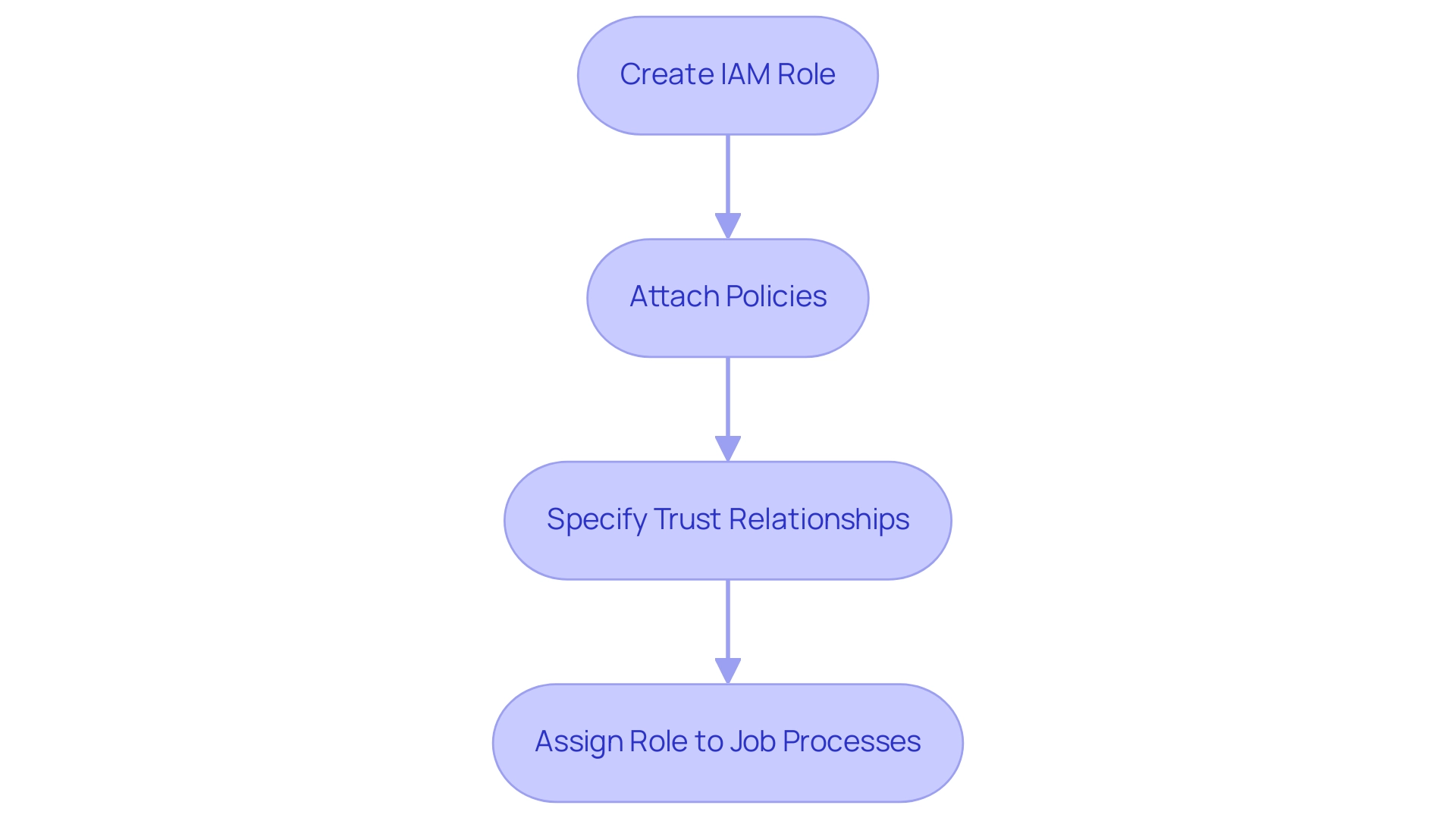
Monitoring and Troubleshooting AWS Batch Jobs
To effectively monitor and troubleshoot AWS Batch jobs, consider implementing the following strategies:
-
Utilize the AWS Management Console: Access the AWS Batch console to check the status of your tasks at a glance. You can easily recognize whether tasks are pending, actively running, or have failed, enabling quick decision-making. Remember that the job queue has a priority of 1, which is crucial for managing job execution effectively.
-
Enable CloudWatch Logs: Ensure that logging is activated for your tasks. This crucial step allows you to capture both output and error logs, providing a detailed view that is essential for troubleshooting. In fact, AWS Batch job monitoring statistics for 2024 indicate that organizations leveraging CloudWatch Logs report a significant reduction in troubleshooting time.
-
Establish CloudWatch Alarms: Set up CloudWatch alarms to notify you of task failures or when tasks exceed their expected runtime. This proactive method helps you address potential issues before they escalate into critical failures, maintaining operational efficiency.
-
Review Job Definitions Carefully: In the event of job failures, thoroughly review the job definitions to ensure all parameters are accurately configured. Common pitfalls include incorrect resource allocations or misconfigured environment variables. A case study on container image pull failures highlights the importance of precise configurations; despite a retry strategy allowing for ten attempts, a failure due to a ‘CannotPullContainerError’ resulted in immediate job termination due to misconfiguration.
-
Verify IAM Permissions: Check that the IAM roles linked to your tasks possess the necessary permissions. Inadequate permissions can lead to job failures and hinder the overall efficiency of your operations. By creating an instance role and attaching it to an instance profile, you can ensure proper interaction with Amazon ECS. Expert insights indicate that by defining retry strategies, you can effectively respond to various infrastructure events or application signals, enhancing reliability. “By defining retry strategies you can react to an infrastructure event (like an EC2 Spot interruption), an application signal (via the exit code), or an event within the middleware (like a container image not being available).”
By adopting these monitoring and troubleshooting strategies, you can significantly enhance the reliability of your AWS jobs, ensuring they operate smoothly and efficiently.
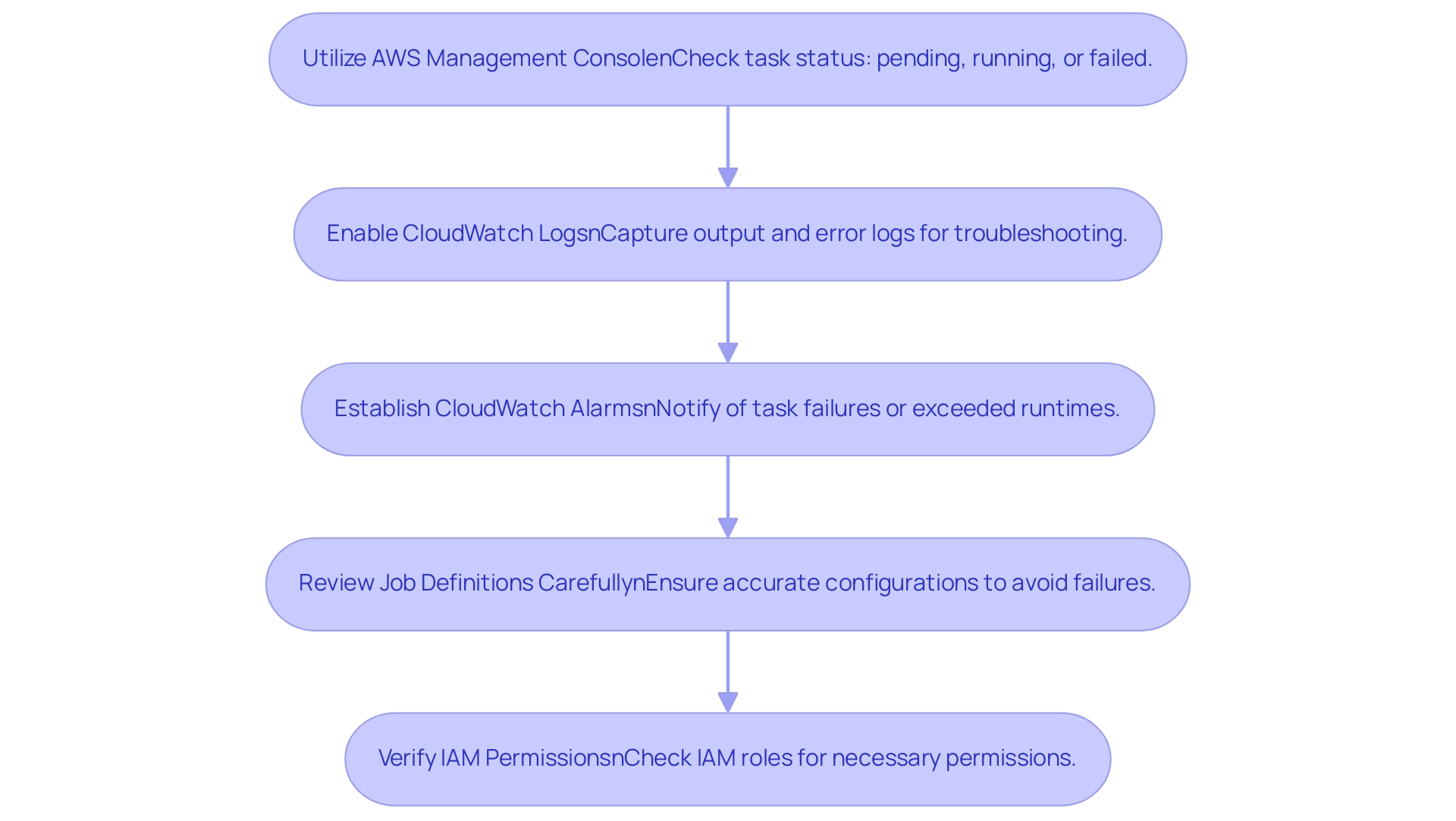
Best Practices for Using AWS Batch and API Integration
To harness the full potential of AWS job processing and API integration while leveraging Robotic Process Automation (RPA) for enhanced operational efficiency, consider implementing the following best practices:
-
Optimize Job Definitions: Regularly assess and refine your job definitions to align with evolving operational needs. This includes specifying crucial elements such as the Docker image, vCPUs, and memory requirements based on performance metrics, which can lead to improved efficiency and reduced costs, particularly when integrated with RPA to automate repetitive tasks.
-
Utilize Environment Variables: Implement environment variables within your job definitions to dynamically manage configuration settings. This approach not only streamlines updates but also mitigates the risk of errors when deploying modifications, enhancing overall reliability, and supporting the agile integration of tailored AI solutions.
-
Establish Version Control: Adopt version control for your job definitions to trigger API configurations. This strategy allows for effective tracking of changes and facilitates quick rollbacks in case of unexpected issues, thereby maintaining stability in your operations while reinforcing the efficiency of RPA processes.
-
Automate Testing: Introduce automated testing procedures that trigger API endpoints to verify their functionality consistently. By catching potential issues early in the development cycle, you can ensure smoother deployments and greater confidence in your systems, which is critical in a rapidly evolving AI landscape.
-
Document Your Processes: Create and maintain detailed documentation of your AWS Job Scheduling and configurations for the trigger API Gateway. This invaluable resource aids in troubleshooting and serves as a training tool for onboarding new team members, ensuring continuity and knowledge transfer, which is crucial for overcoming technology implementation challenges.
-
Leverage Business Intelligence: Integrate Business Intelligence tools to analyze data generated from your RPA processes. This can provide actionable insights that enhance decision-making and operational strategies, ensuring your organization remains competitive in a data-rich environment.
-
Address Implementation Challenges: Be aware of common pitfalls in RPA deployment, such as inadequate training or resistance to change among staff. Creating a change management plan can assist in alleviating these difficulties, promoting a more seamless shift to automated workflows.
By following these best practices, you can enhance your AWS processing usage, making sure it stays efficient, secure, and scalable while effectively managing expenses related to processing jobs. For instance, AWS service allows users to track and manage costs through cost allocation tags and budget alerts, providing a real-world example of how these strategies can lead to better financial oversight and control. The flexibility of AWS Batch also plays a crucial role in efficient management and scaling, further enhancing operational efficiency through the integration of RPA and Business Intelligence.
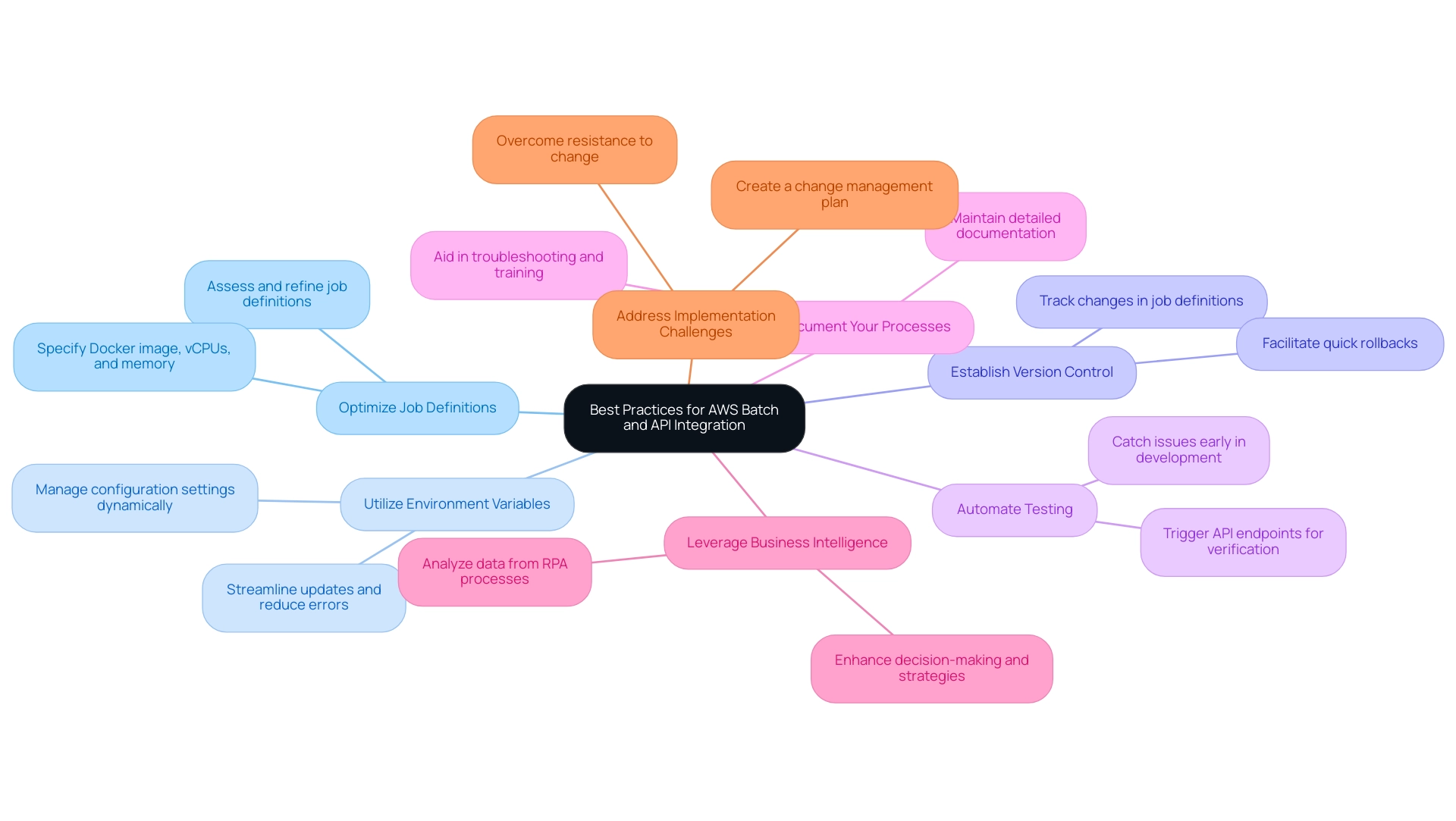
Conclusion
In summary, AWS Batch stands out as an essential tool for organizations aiming to enhance operational efficiency and streamline batch computing workloads in the cloud. By automating job submissions via the API Gateway, configuring IAM roles, and implementing effective monitoring strategies, businesses can alleviate the burdens of manual workflows and focus on strategic initiatives that drive growth.
The integration of AWS Batch with Business Intelligence and Robotic Process Automation creates a robust framework that not only empowers teams but also facilitates informed decision-making through actionable insights. By following best practices such as:
– optimizing job definitions
– utilizing environment variables
– maintaining thorough documentation
organizations can harness the full potential of AWS Batch while ensuring security and scalability.
Ultimately, embracing AWS Batch is not just about adopting a new technology; it’s about transforming operations to achieve a competitive edge in a data-driven landscape. By prioritizing efficiency and automation, businesses can position themselves for success in an ever-evolving marketplace, paving the way for innovation and growth.
Introduction
Navigating the complexities of automation in security policies is no small feat for organizations striving to enhance their operational efficiency. As businesses increasingly turn to technologies like Robotic Process Automation (RPA) to streamline workflows, they encounter a range of challenges—from integrating automated systems with existing frameworks to overcoming employee resistance rooted in fear and misunderstanding.
However, by adopting strategic training and communication practices, organizations can effectively demonstrate the transformative benefits of automation. This article delves into the critical aspects of automation, including:
- The importance of golden configuration validation for compliance
- Strategies to overcome resistance
- Metrics to measure success
By addressing these key areas, organizations can unlock the full potential of automation, driving innovation and operational excellence.
Identifying Key Automation Challenges in Security Policies
The challenges of automation in security policies present an automation challenge that entities must navigate for effective implementation. The automation challenges include:
- Integrating automated systems with existing security frameworks
- Ensuring continuous monitoring
- Keeping security protocols updated in line with evolving threats
Moreover, companies may encounter an automation challenge from staff familiar with manual methods who might be reluctant to rely on automated systems.
To tackle the automation challenges, it is crucial for organizations to participate in comprehensive training and communication strategies that highlight the advantages of mechanized processes, such as improved efficiency and minimized errors through Robotic Process Automation (RPA). Additionally, RPA can play a crucial role in addressing talent retention issues by alleviating the burden of repetitive tasks, allowing employees to focus on more strategic initiatives.
Establishing clear protocols to address the automation challenge of security tasks not only streamlines operations but also aligns with regulatory standards, thereby empowering teams to focus on more strategic, value-adding work while modernizing outdated systems.
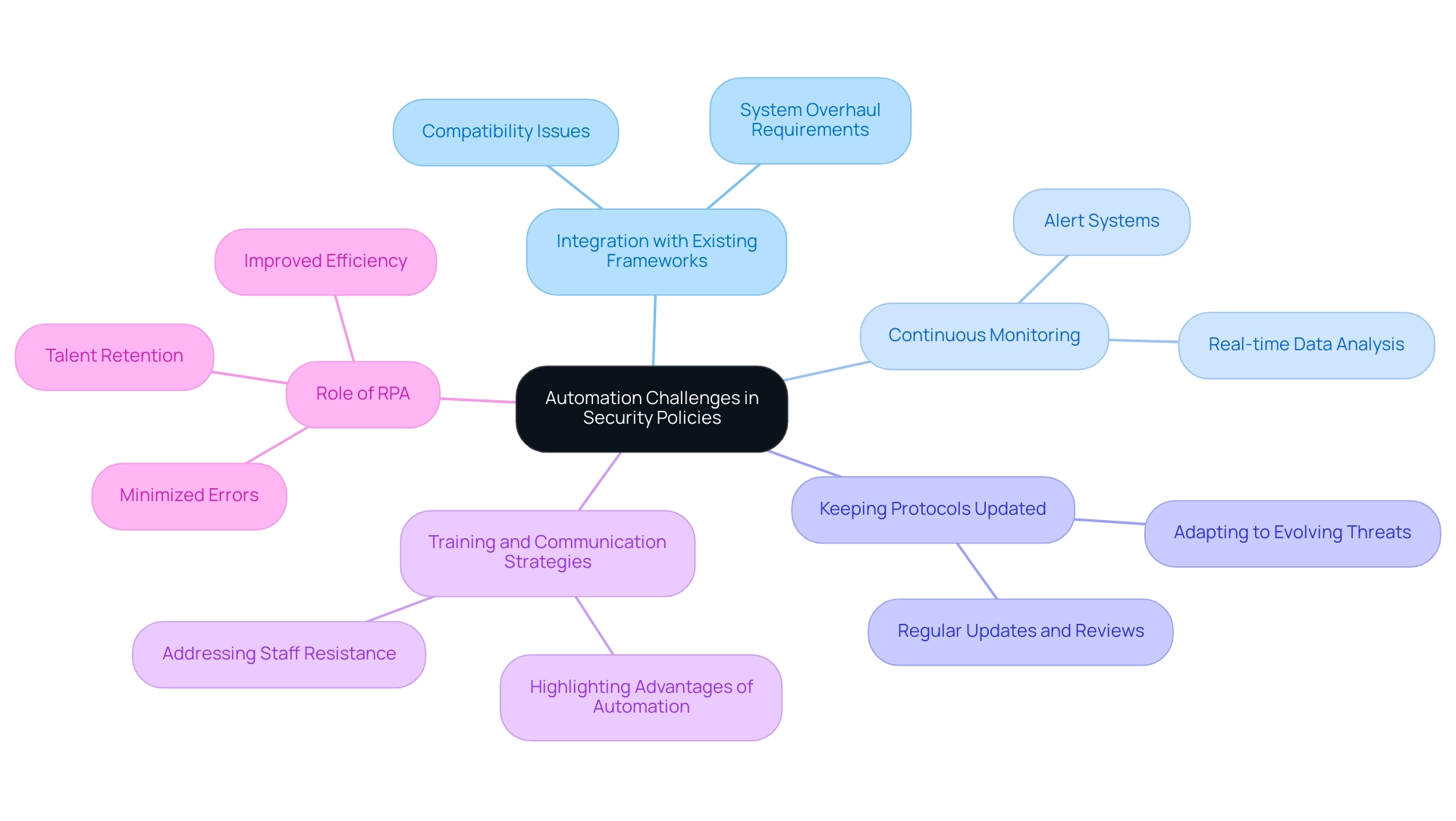
Ensuring Compliance: The Importance of Golden Configuration Validation in Automation
Golden configuration validation is a critical element of ensuring compliance in automated systems. This practice involves establishing a baseline configuration that meets security standards and regularly validating that automated systems tackle the automation challenge by adhering to this configuration. Manual, repetitive tasks can significantly slow down operations, leading to wasted time and resources; therefore, by implementing golden configuration validation, entities can significantly reduce the risk of security vulnerabilities that arise from misconfigured systems.
This process not only aids in adhering to regulatory requirements but also tackles the automation challenge by improving operational efficiency through Robotic Process Automation (RPA) while promoting a culture of accountability and continuous improvement within the entity. Furthermore, utilizing customized AI solutions alongside routine audits and updates to the optimal configuration is crucial for adjusting to new threats and guaranteeing that processes remain effective and secure, ultimately promoting informed decision-making and business growth.

Overcoming Resistance to Automation in Organizations
Opposition to mechanization presents an automation challenge for companies, frequently arising from fears of job loss or a lack of understanding regarding the benefits of mechanization. To overcome this resistance, it is essential to engage employees in the automation challenge from the outset. Providing training sessions that educate staff on how technologies like Robotic Process Automation (RPA) can help overcome the automation challenge by streamlining workflows, boosting efficiency, and reducing errors enhances their roles rather than replace them, fostering a more positive outlook.
Furthermore, highlighting success stories of enterprises that have effectively implemented customized AI solutions and utilized Business Intelligence to promote informed decision-making can inspire confidence. For instance, a recent case study revealed that a company reduced its processing time by 40% after integrating RPA into its operations. Fostering open dialogue and feedback during the implementation can also assist in addressing concerns related to the automation challenge and in creating a supportive atmosphere for change.
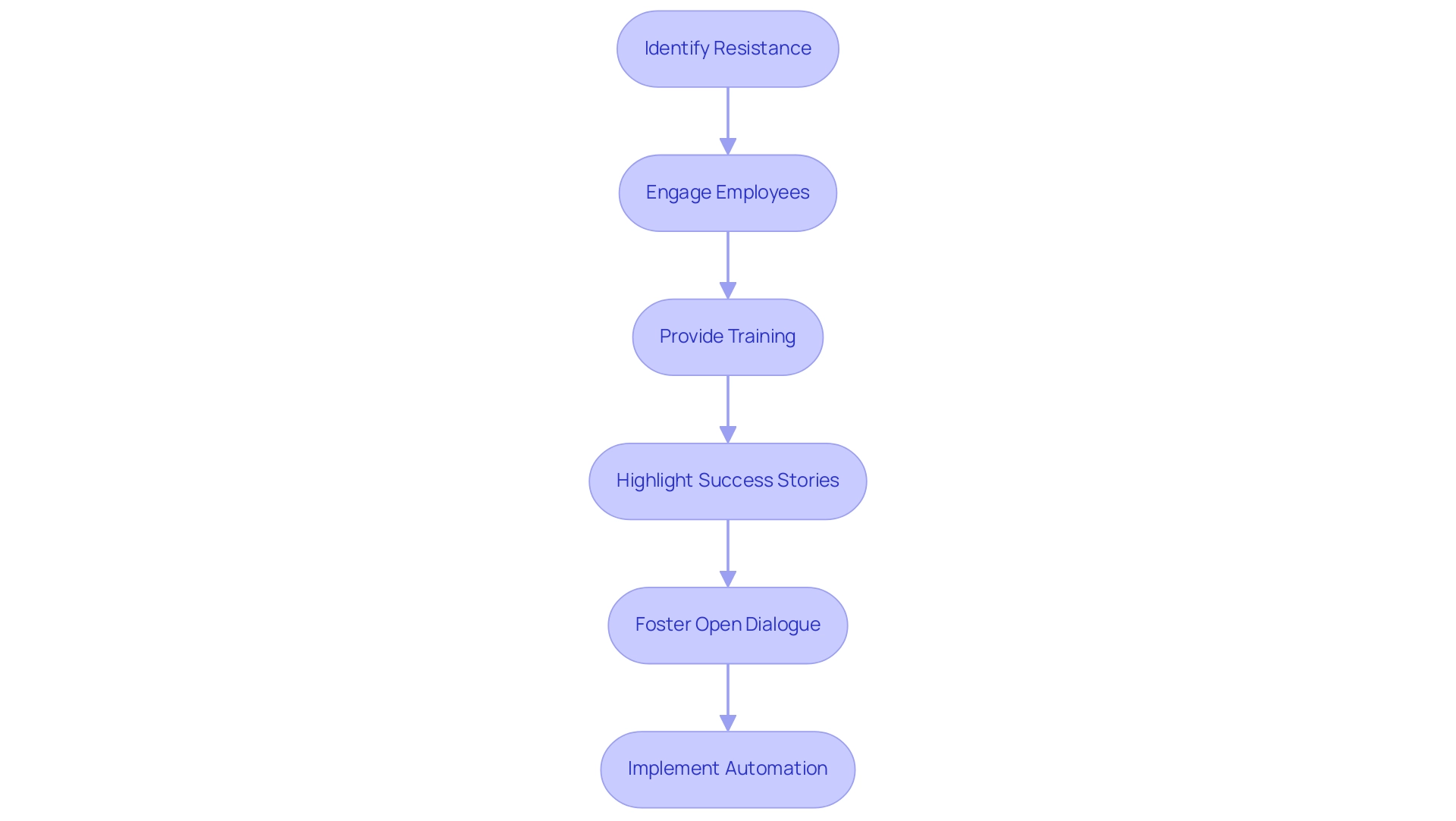
Measuring Success: Metrics for Automation Effectiveness
To effectively assess the success of automated initiatives, companies should define clear key performance indicators (KPIs) that address the automation challenge and align with their business goals. These metrics can encompass:
- Time savings
- Error reduction rates
- Overall productivity improvements
Particularly through the use of innovative tools like EMMA RPA, which automates repetitive tasks, and Microsoft Power Automate, which streamlines workflows. Consistently analyzing these metrics allows businesses to assess the effect of mechanization on their operational processes and make informed choices regarding future investments.
Furthermore, gathering feedback from employees utilizing the automated systems is crucial, as it provides insights into their experiences and highlights potential areas for enhancement. By continuously monitoring and refining automation strategies based on these metrics, organizations can tackle the automation challenge and optimize the benefits of their RPA efforts, ultimately enhancing overall productivity and employee morale while addressing task repetition fatigue and staffing shortages.

Conclusion
Embracing automation in security policies is a transformative journey that organizations must navigate with strategic foresight. By identifying key challenges such as integration with existing frameworks and employee resistance, businesses can proactively address potential hurdles. Engaging employees through comprehensive training and transparent communication not only alleviates fears but also highlights the significant benefits of automation, including enhanced efficiency and reduced error rates.
The importance of golden configuration validation cannot be overstated. This practice ensures compliance and operational efficiency by establishing a secure baseline configuration that automated systems must adhere to. Regular audits and updates are essential to adapting to evolving threats, fostering a culture of accountability that drives continuous improvement.
Furthermore, measuring the success of automation initiatives through clear key performance indicators is vital. By focusing on metrics such as time savings and error reduction, organizations can track the effectiveness of their automation strategies and make informed decisions for future enhancements. Continuous feedback from employees also plays a crucial role in refining these processes.
Ultimately, the integration of automation in security policies empowers organizations to modernize their operations while enabling employees to focus on more strategic tasks. By overcoming resistance, ensuring compliance, and measuring success, organizations can unlock the full potential of automation, paving the way for innovation and operational excellence. Now is the time to embrace this evolution, transforming challenges into opportunities for growth and success.
Introduction
In a world where operational efficiency is paramount, the Discovery Bot emerges as a game-changing tool for automating process recordings. However, its 60-minute session limit can pose a challenge, particularly for complex workflows. Understanding these constraints is essential for maximizing productivity and ensuring that no critical steps are overlooked.
This article delves into practical strategies for overcoming time limitations, including:
- Effective use of the pause and resume features
- Best practices for recording
By embracing these insights, organizations can navigate the intricacies of automation, enhance training, and streamline operations, ultimately leading to improved efficiency and reduced error rates. As the landscape of automation continues to evolve, equipping teams with the right knowledge and tools is crucial for driving success in today’s fast-paced environment.
Understanding Time Limits of the Discovery Bot
The discovery bot is a powerful tool for automating task documentation, yet it’s essential to acknowledge its limitation: each session is capped at 60 minutes. This constraint can present significant challenges, particularly for lengthy processes, potentially leading to incomplete recordings and the risk of data loss. For instance, the NEST building has evolved with progress in technology, highlighting the importance of recognizing these limitations to enhance operational efficiency.
Choosing reliable automation solutions, such as those from Belimo, is crucial for ensuring quality service and technical support. Users need to be aware of this time limit, which necessitates proactive planning for their submissions with the help of the discovery bot. If a process exceeds the set duration, the recording will halt, requiring a restart that could disrupt workflow continuity.
The Training Center ROVC case study demonstrates how technology tools can enhance training in sectors like HVAC, while also emphasizing the need to strategize around session time limits. By preparing adequately, users can capture every essential step without interruptions, ultimately supporting enhanced productivity and operational efficiency. Furthermore, as emphasized in the case study of a mid-sized company, implementing GUI technology resulted in a 70% decrease in data entry errors and enhanced workflow efficiency by 80%.
Addressing staffing shortages and outdated systems through automation not only mitigates these challenges but also streamlines operations, ensuring that organizations can maintain productivity in the face of evolving demands.
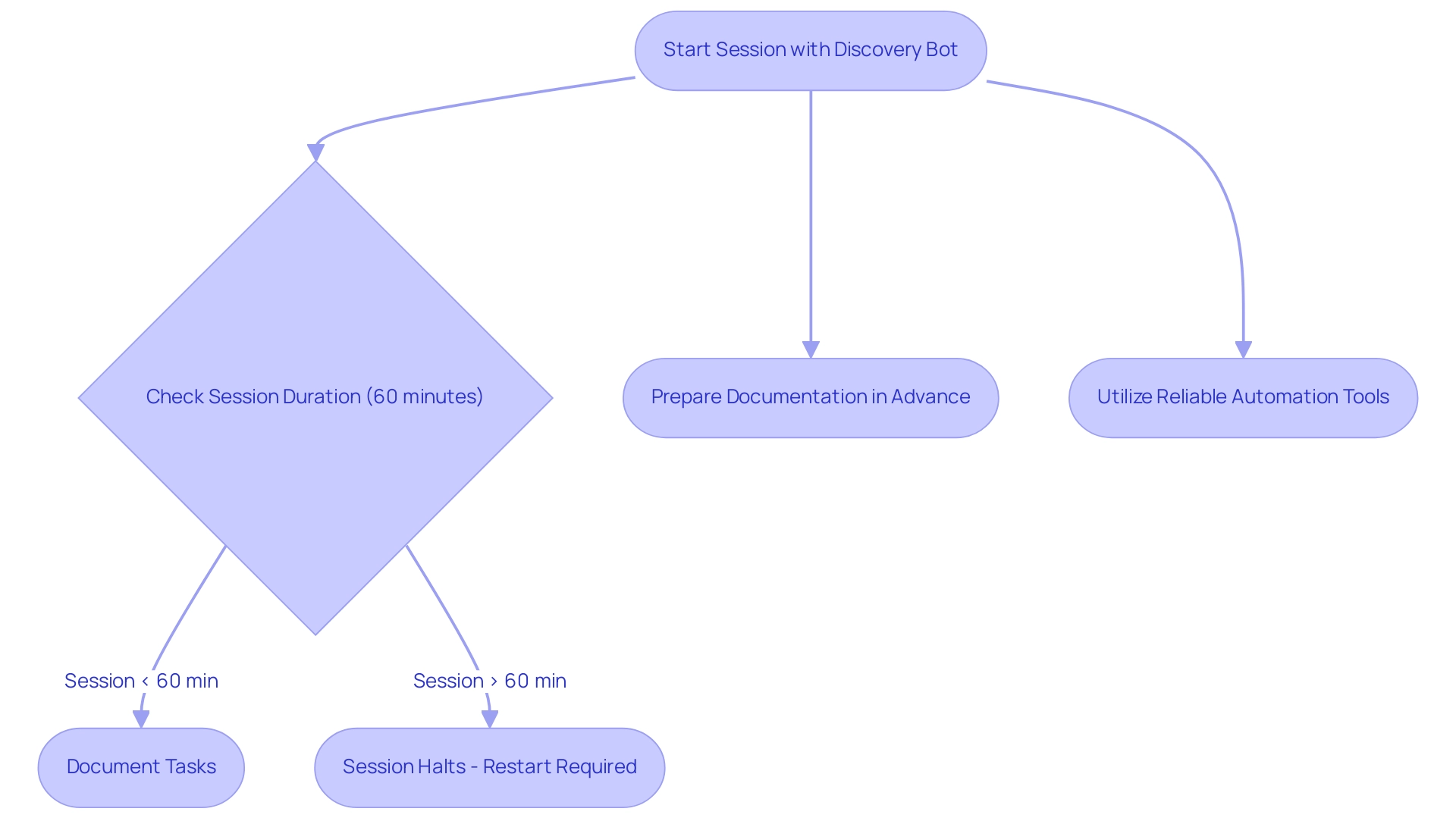
Strategies to Overcome Time Constraints with the Discovery Bot
To effectively manage the time constraints of the discovery bot while leveraging the power of Robotic Process Automation (RPA), consider the following strategies:
-
Break Down Processes:
Divide lengthy processes into smaller, manageable segments. This allows you to record each segment separately, ensuring that no important steps are missed. -
Use Timed Sessions:
Schedule your captures during periods of low activity to minimize interruptions. This enhances the probability of finalizing a capture within the time limit. -
Monitor Progress:
Keep an eye on the timer during sessions. If you reach the 60-minute mark, be ready to pause the playback and continue it as necessary. -
Document Steps:
Maintain a checklist of the steps involved in your procedure outside of the Discovery Bot. This way, if a playback stops, you can easily continue from where you left off without losing track. -
Leverage Multiple Instances:
Run several Discovery Bots to capture different aspects of a workflow simultaneously. This can assist you in bypassing the time limit by dividing the workload.
By applying these strategies, users can efficiently manage the time limitations of the discovery bot and enhance their overall productivity when documenting activities. Additionally, embracing RPA solutions like EMMA RPA, which offers advanced operational efficiency features, and Microsoft Power Automate, known for its streamlined workflow automation and risk-free ROI assessment, can further boost efficiency and improve employee morale across your organization. These tools address key challenges such as task repetition fatigue and staffing shortages, ensuring that your team can focus on more strategic, value-adding work.
With tailored AI solutions and business intelligence, you can transform raw data into actionable insights, enabling informed decision-making that drives growth and innovation.
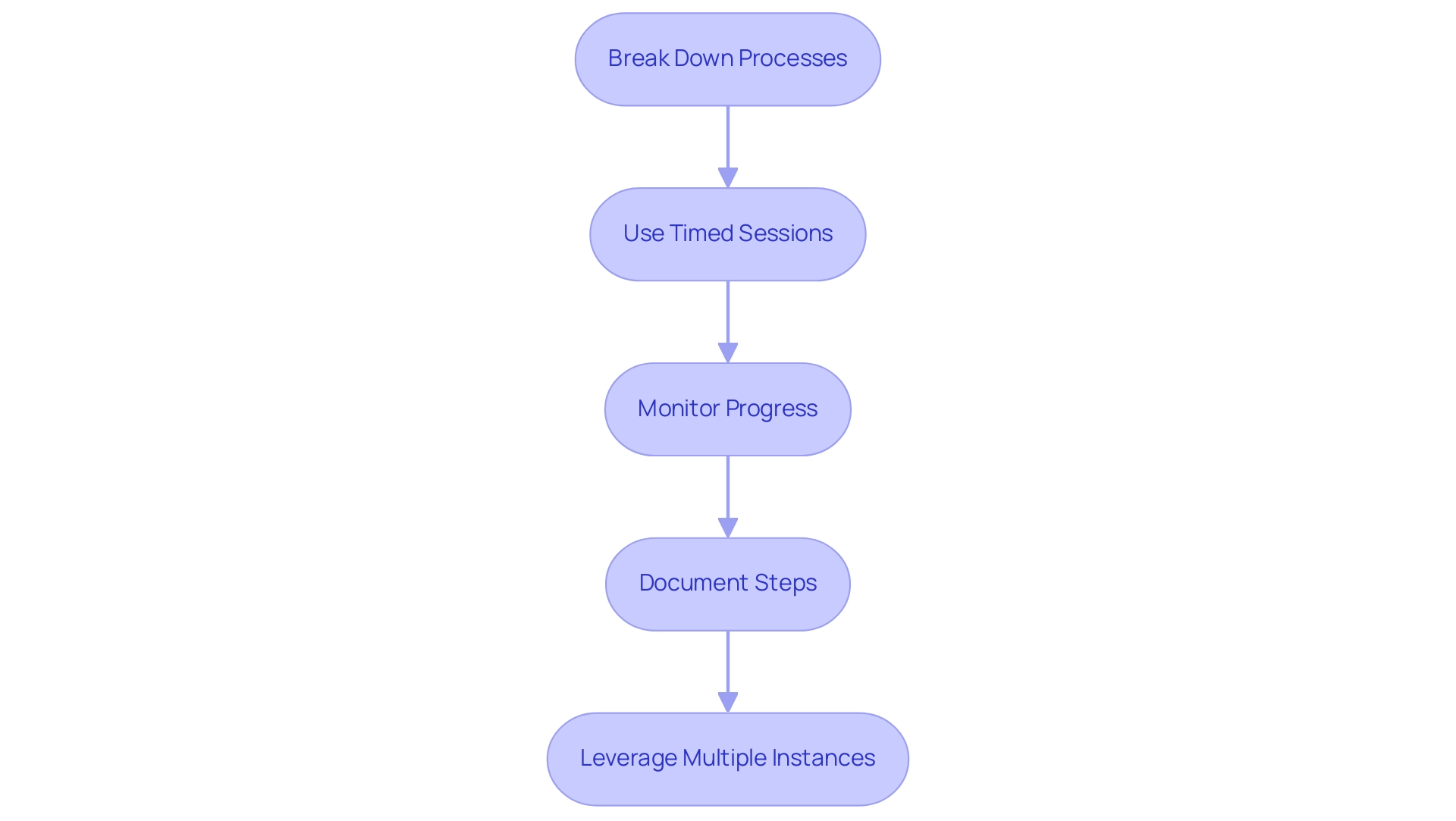
Utilizing the Pause and Resume Features
The pause and resume functionality of the discovery bot is an essential asset for managing time constraints effectively in documentation processes, particularly in the context of improving transparency in teaching and learning, as emphasized by TILT Higher Ed. Here’s how to maximize these features:
- Pause When Necessary: If you anticipate that a session might exceed the 60-minute limit, confidently pause by clicking the pause button in the interface.
This strategic move helps maintain the quality of your audio and aligns with the goal of fostering an engaging learning environment.
-
Resume with Ease: When you’re ready to continue, simply click the resume button to pick up exactly where you left off. This feature is particularly beneficial for lengthy tasks that may require breaks or moments of waiting for user input, ensuring that no critical information is missed and supporting a more inclusive approach to recording.
-
Keep Track of Time: While using the pause feature, it’s vital to monitor the total time spent. The discovery bot conveniently monitors the overall duration, allowing for better planning and ensuring that your files remain organized and efficient. This is essential as Hulleman and Harackiewicz (2009) discovered that contemplating the usefulness of materials can greatly improve student engagement and performance.
By effectively utilizing the pause and resume features, users can maintain the integrity of their captures while documenting lengthy processes seamlessly. As noted by educators Darby & Lang, sharing authentic experiences can enhance engagement; thus, using these tools not only serves functional purposes but also fosters a supportive learning atmosphere. For instance, in the case study on ‘Strategies for Active and Inclusive Online Classrooms,’ the authors illustrate how structured pauses can lead to more thoughtful interactions and deeper learning experiences, reinforcing the value of these features in real-world educational settings.
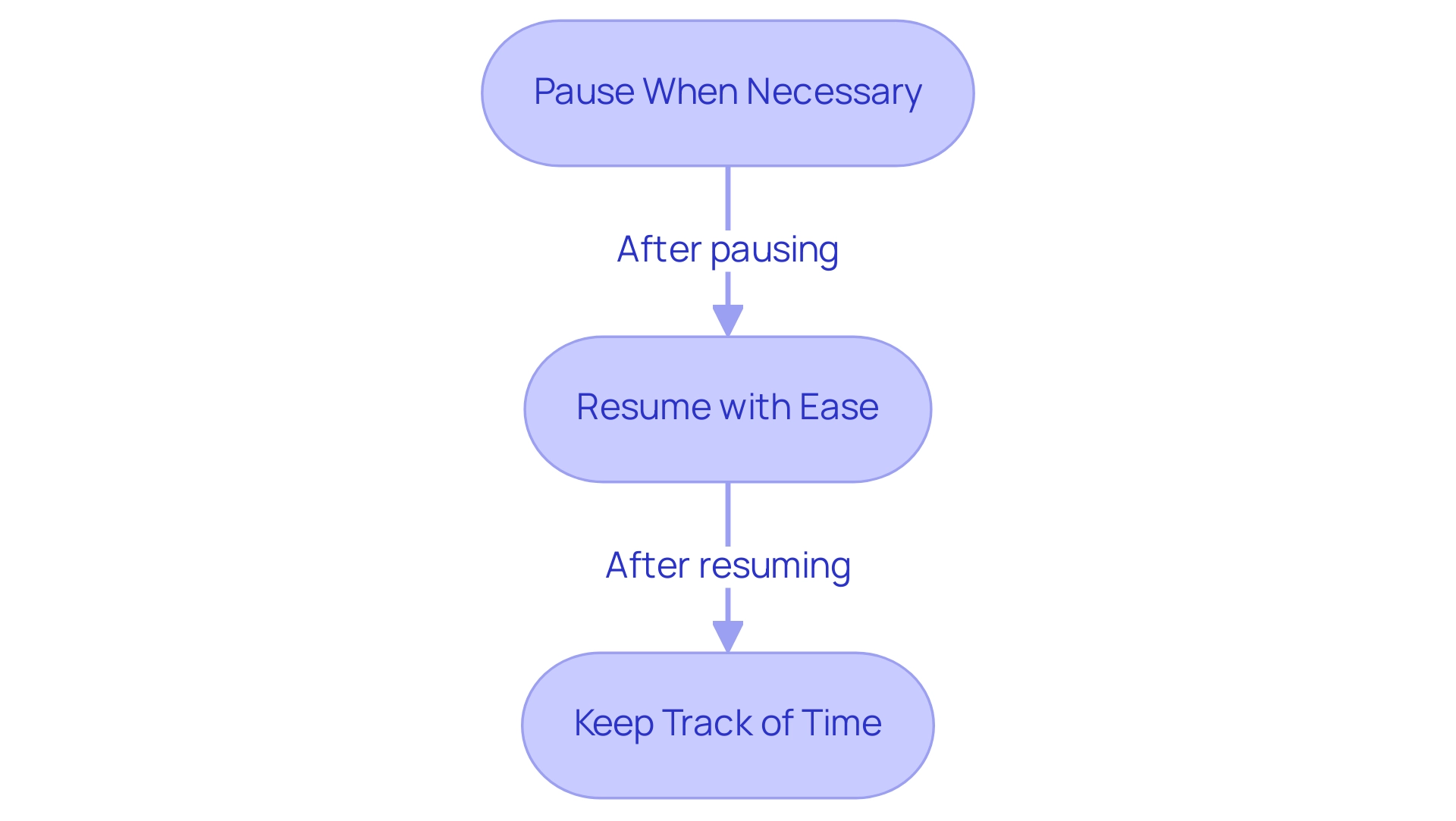
Best Practices for Recording with the Discovery Bot
To maximize the benefits of your captures with the Discovery Bot and improve your operational efficiency through automation, consider these best practices:
-
Prepare Your Environment: Ensure that the setting is conducive to capturing, with minimal distractions and interruptions. This helps maintain focus and ensures clarity in the recorded process, enabling a smoother workflow.
-
Outline the Process: Before beginning the capture, outline the steps you plan to follow. This preparation can help you stay organized and ensure that all necessary actions are recorded, providing a clear roadmap for efficiency.
-
Test the Setup: Run a test capture to check that all necessary components are functioning correctly. This proactive measure can assist in recognizing any potential problems before you begin the actual capture, ensuring a seamless experience.
-
Review Recorded Segments: After finishing a capture, review it to ensure that all steps are accurately captured. This enables prompt correction of any overlooked actions, improving the overall quality of your captures and minimizing errors in the process.
-
Train Users on Best Practices: If multiple team members will use the discovery bot, conduct training sessions to share these best practices. This can enhance overall efficiency and consistency in recordings, empowering your team to utilize automated procedures effectively and concentrate on more strategic tasks that drive growth.
By following these best practices and integrating Robotic Process Automation (RPA) into your workflows, you can boost productivity and make informed decisions that drive growth and innovation, especially in today’s rapidly evolving AI landscape.
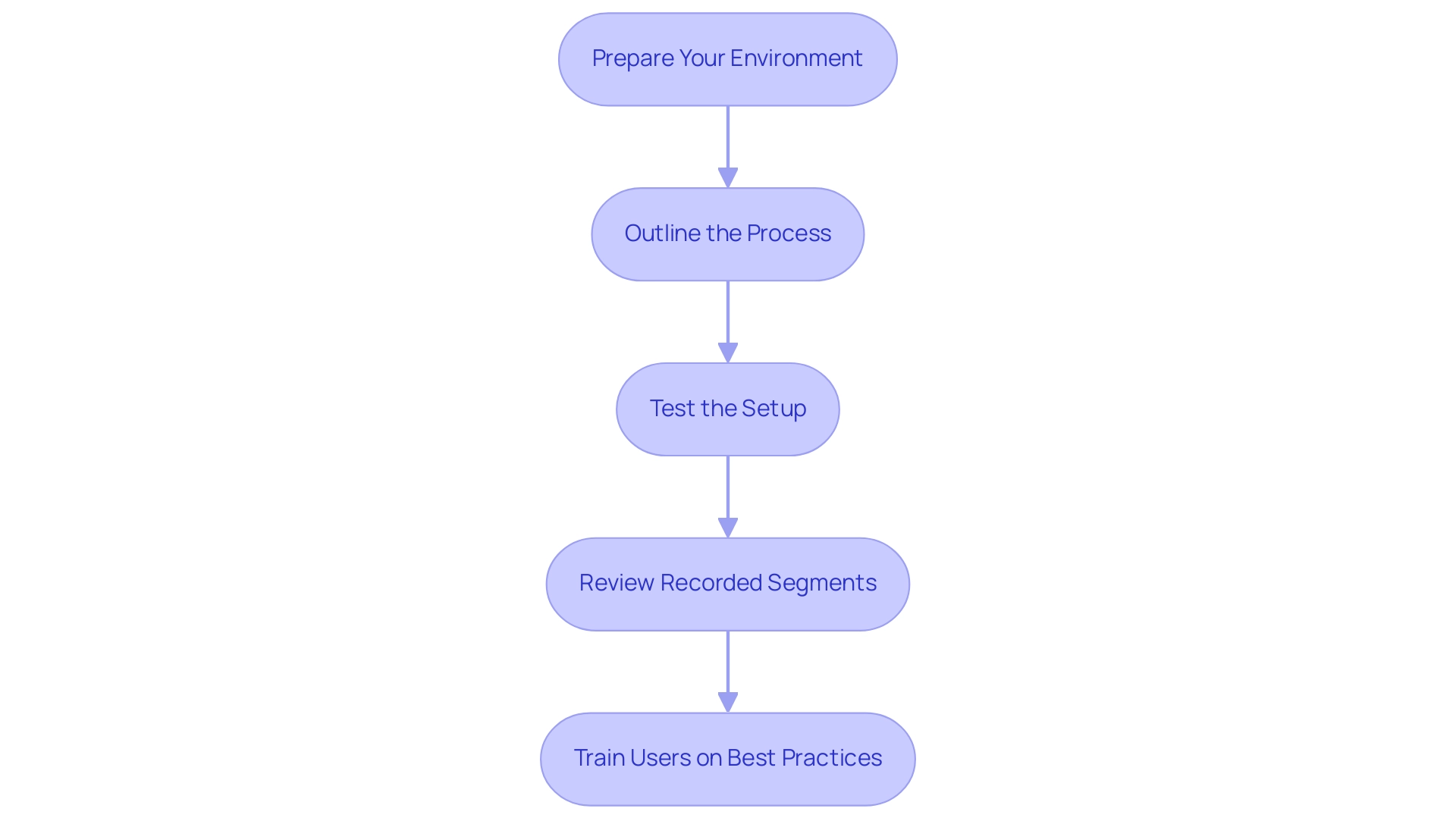
Leveraging Feedback for Continuous Improvement
To ensure the ongoing success of the discovery bot and enhance operational efficiency, it’s crucial to actively seek and incorporate feedback from users and stakeholders. This engagement promotes an atmosphere of ongoing enhancement, which is crucial in a swiftly changing AI landscape where solutions like GUI automation and Robotic Process Automation (RPA) are revolutionizing business operations. Here are effective strategies to leverage feedback:
-
Conduct Surveys: Distribute surveys post-session to gather insights on user experiences. Focus on questions that explore challenges, ease of use, and suggestions for enhancements, similar to how a mid-sized healthcare company reduced data entry errors by 70% through automation.
-
Hold Review Meetings: Schedule regular collaborative meetings to discuss the usage of the discovery bot among team members. This approach can highlight common issues and encourage collective problem-solving, much like the collaborative efforts that enabled a 50% acceleration in software testing processes.
-
Analyze Recorded Data: Review recorded processes to pinpoint recurring problems or inefficiencies. This analysis will inform your strategies for refining future productions, paralleling how companies have achieved an 80% improvement in workflow efficiency through targeted automation.
-
Implement Changes: Adapt your recording practices based on the feedback collected. This might involve altering how procedures are documented or enhancing training materials for users to streamline tasks and reduce errors.
-
Celebrate Successes: Recognize and celebrate the improvements achieved through user feedback. Acknowledging these successes can inspire users to continue pursuing enhancements in their use of the discovery bot. For instance, Moseley Architects implemented the Procore Connector across 28 projects, processing over 3000 submittals, resulting in a savings of 600 hours and $30,000. This illustrates the tangible advantages of simplifying methods through user feedback.
As Patrick Covert, Director of Information Technology for Moseley Architects, emphasizes,
Any tool that simplifies the complicated technology landscape in the construction industry is a win. Streamlining our construction management procedures enhances our overall project delivery. This mindset is essential for driving efficiency and maximizing the advantages of automated tools.
Furthermore, the implementation of these automation solutions resulted in a significant ROI achieved within six months, underscoring the effectiveness of integrating user feedback into operational processes.
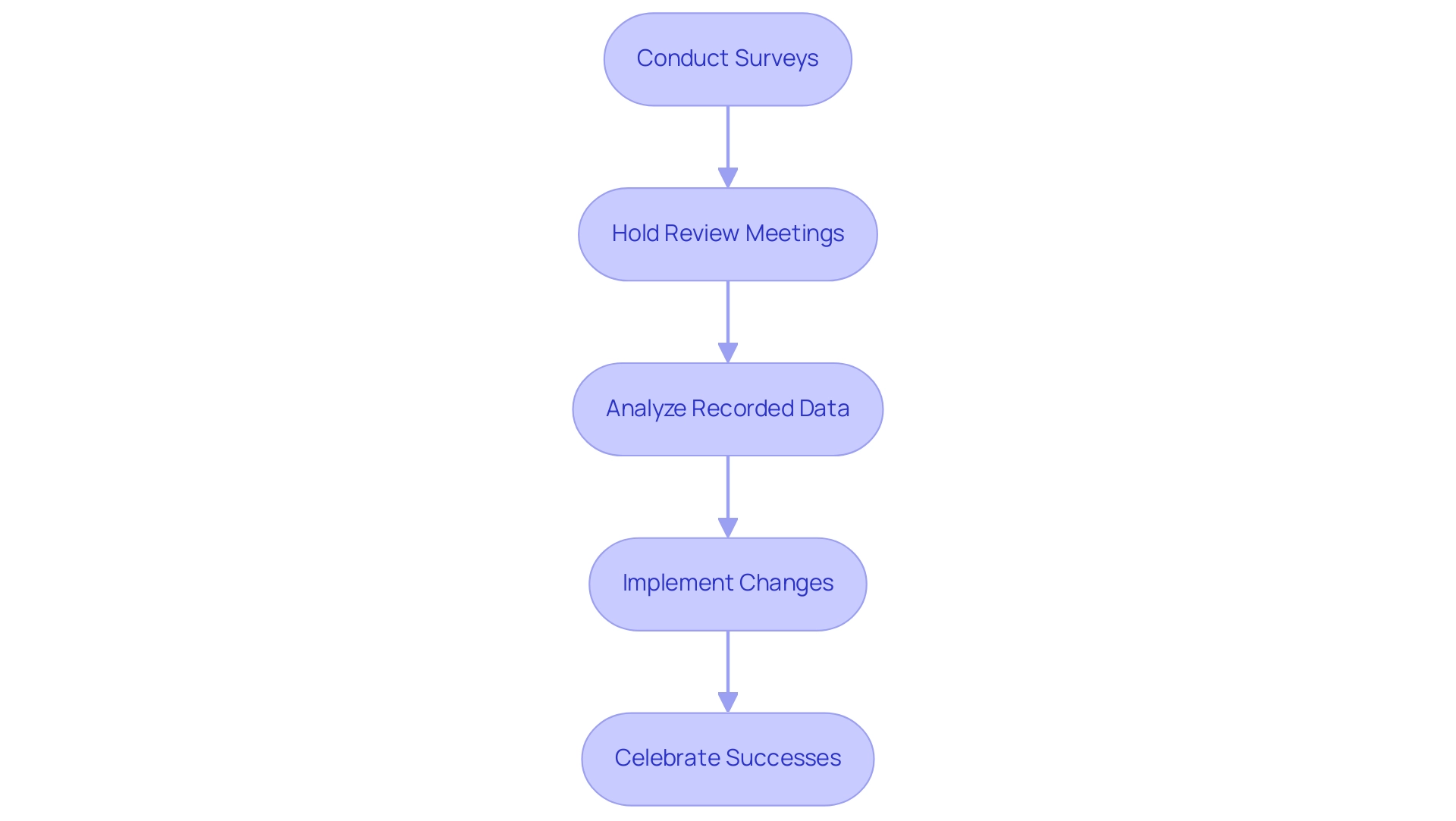
Conclusion
Maximizing the potential of the Discovery Bot is essential for organizations aiming to enhance operational efficiency through automation. Understanding the 60-minute session limit is the first step in navigating its challenges. By breaking down lengthy processes, utilizing the pause and resume features, and meticulously documenting steps, users can ensure that no critical information is lost during recordings. The practical strategies outlined provide a roadmap for overcoming these constraints, enabling teams to capture every essential action without interruptions.
Moreover, implementing best practices—such as preparing the recording environment and training users—further empowers organizations to leverage the Discovery Bot effectively. Encouraging a culture of continuous improvement through user feedback not only streamlines processes but also enhances the overall quality and reliability of recordings.
In a rapidly evolving landscape, where automation tools are integral to operational success, adopting these solutions will lead to improved productivity and reduced error rates. Embracing these methodologies positions organizations to thrive in a competitive environment, ensuring that they remain agile and responsive to the demands of modern business. Now is the time to harness the full capabilities of the Discovery Bot and drive greater efficiency across all operations.
Introduction
In the digital landscape where efficiency is paramount, API triggers emerge as powerful tools that can revolutionize the way organizations operate. By automating responses to specific events, these triggers facilitate seamless communication between applications, transforming previously manual tasks into streamlined workflows. From enhancing customer engagement through timely notifications to optimizing project management processes, the potential applications are vast and varied.
However, realizing this potential requires a clear understanding of how to set up, manage, and troubleshoot API triggers effectively. This article delves into the essentials of API triggers, offering practical insights and step-by-step guidance to empower organizations on their journey toward operational excellence and productivity enhancement.
Understanding API Triggers: The Basics
API activators, also known as API triggers, are automated responses that initiate specific actions in applications based on predefined events. For instance, when a user subscribes to a newsletter, an API activation can automatically send a welcome email. Comprehending API functions entails acknowledging their role in linking various software applications, enabling them to interact and execute tasks without manual intervention.
This automation not only saves time but also reduces the likelihood of errors, thereby enhancing overall productivity. By leveraging Robotic Process Automation (RPA) and tools like Power Automate, organizations can streamline workflows even further, transforming manual processes into efficient automated systems. Power Automate offers features such as the ability to connect various applications and data sources, making it a versatile solution for enhancing productivity.
Furthermore, integrating tailored AI solutions with RPA can provide additional insights and efficiencies, while a thorough ROI assessment ensures that organizations can measure the benefits of their automation efforts. API activations, or API triggers, can be established across multiple platforms, such as CRM systems, marketing automation tools, and project management software, rendering them vital instruments for boosting operational efficiency and improving business productivity.
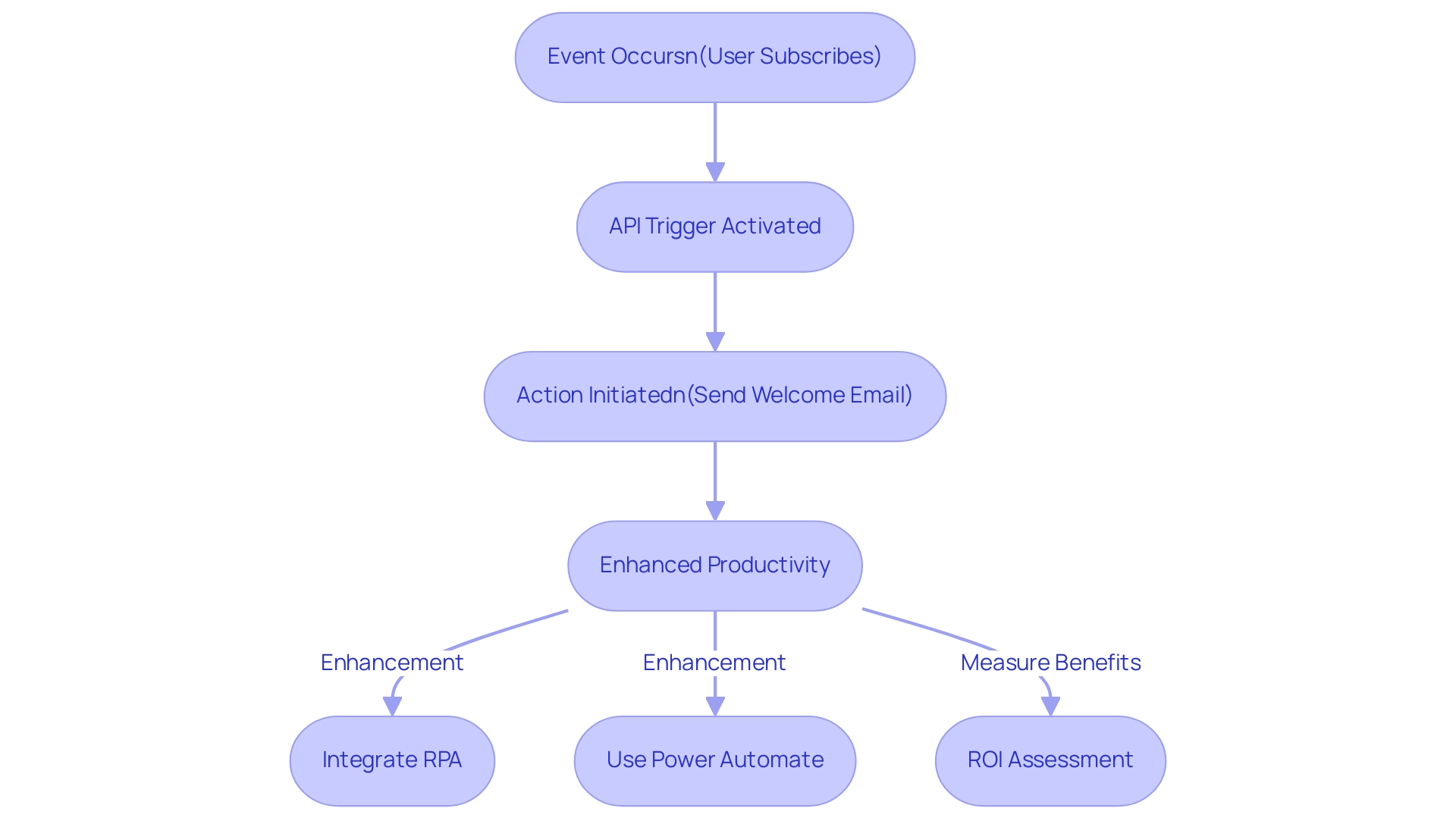
Step-by-Step Instructions for Setting Up API Triggers
-
Identify the Trigger Event: Determine the specific event that will serve as the API trigger for the API activation. For example, this could be a new subscriber in your email list.
-
Access Your API Management Tool: Log into the API management platform you are using (e.g., MailChimp, Apigee).
-
Create a New Trigger:
- Navigate to the ‘Triggers’ section of your API management tool.
-
Click on ‘Create New Trigger’ or a similar option.
-
Define the Activation Event: Choose the event type that will serve as the API trigger for the activation. For instance, if using MailChimp, you might choose ‘New Subscriber’.
-
Set Up the Action: Specify what action should occur when the initiating event happens. This could include sending a notification or updating a database.
-
Test the Activation: Before finalizing, run a test to ensure the activation functions correctly, which is crucial for maintaining operational efficiency within your workflows, especially when leveraging Robotic Process Automation (RPA) to minimize manual tasks and reduce errors.
-
Activate the Mechanism: Once testing is complete and successful, activate the mechanism to start automating your workflow. This step is vital as it integrates seamlessly with tailored AI solutions, enhancing overall productivity and enabling informed decision-making through Business Intelligence via an API trigger.
-
Monitor Performance: After activation, regularly check the performance of your API functions to ensure they are functioning as intended. This monitoring is essential for informed decision-making and overcoming technology implementation challenges in today’s rapidly evolving AI landscape. By utilizing Business Intelligence, you can transform the data collected from these signals into actionable insights, further enhancing efficiency and identifying potential cost savings.
By following these steps, you can effectively set up API signals that not only streamline your operations but also enhance productivity through the strategic use of RPA, tailored AI solutions, and Business Intelligence.
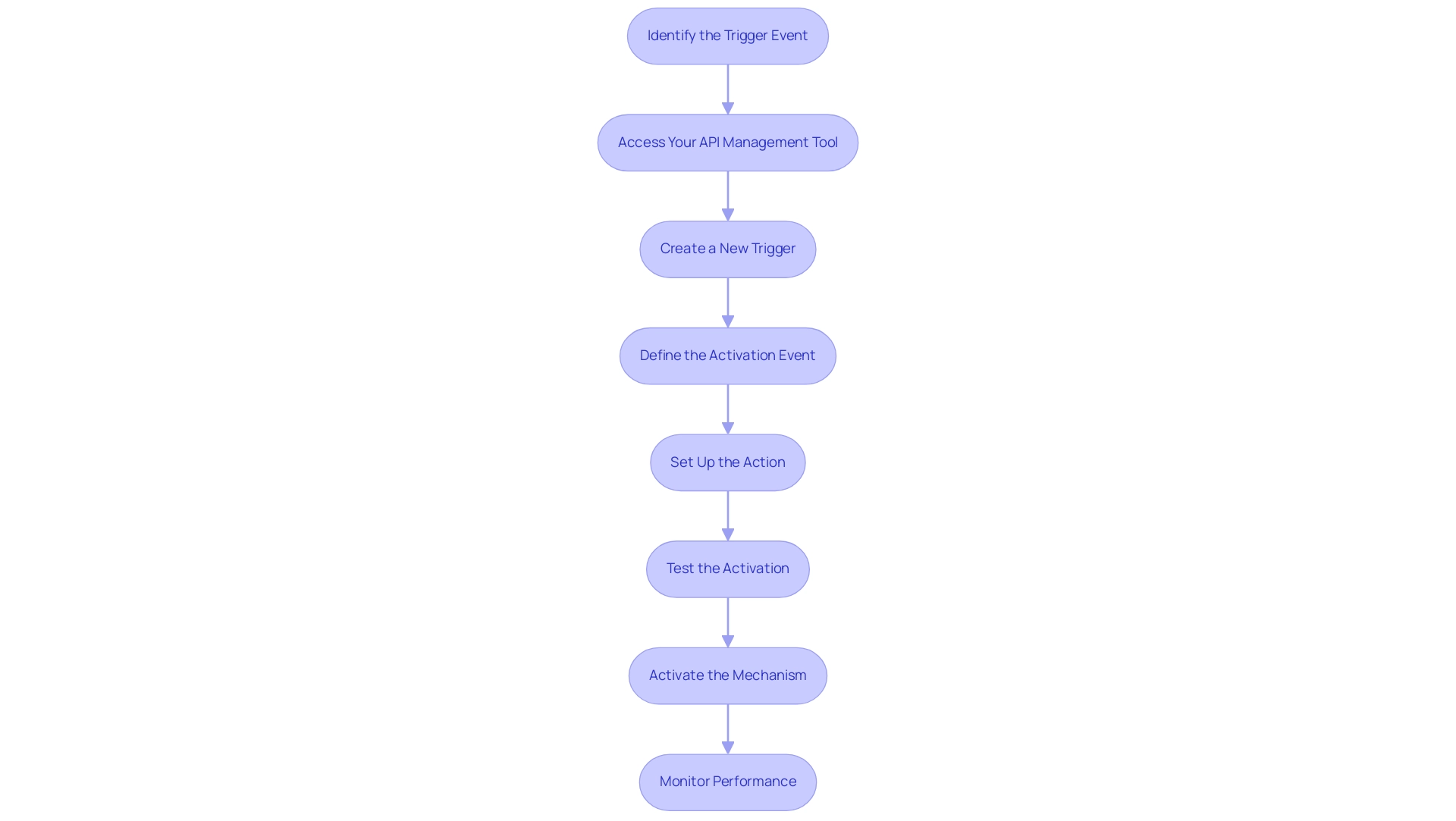
Common Use Cases for API Triggers
Api triggers can be employed in numerous situations, improving efficiency and productivity through automation. Examples include:
- E-commerce: Automatically sending order confirmation emails when a purchase is made, ensuring timely communication with customers.
- Marketing Automation: Initiating personalized email campaigns based on user behavior, such as abandoned cart reminders, which can significantly improve conversion rates.
- Customer Relationship Management (CRM): Updating customer records or sending follow-up emails after a new lead is captured, facilitating better engagement and faster response times.
- Project Management: Notifying team members when a task is completed or when deadlines are approaching, helping teams to stay aligned and focused on priorities.
By exploring these use cases, organizations can not only identify opportunities to implement actions through an api trigger but also leverage Robotic Process Automation (RPA) and Business Intelligence to further enhance their workflows and improve customer engagement. For instance, integrating RPA with Business Intelligence can provide actionable insights into performance metrics, leading to informed decision-making that drives growth and efficiency. Tailored AI solutions can also be deployed to optimize these processes, ensuring that organizations remain competitive and responsive to changing market demands.
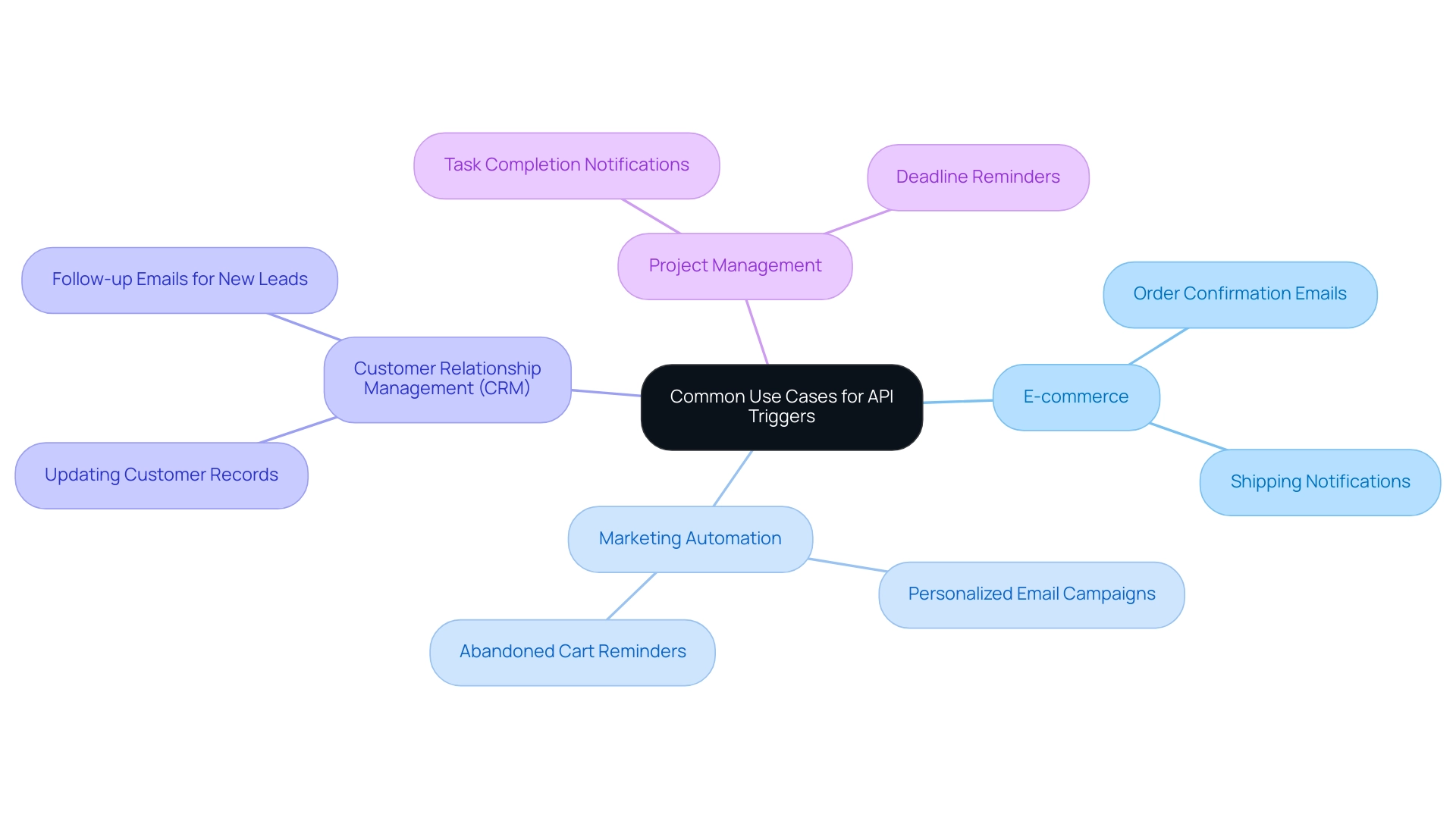
Troubleshooting Common Issues with API Triggers
Even with properly set up API triggers, problems may occur that can impede functional efficiency. Here are some common problems and their solutions, specifically tailored to enhance your workflow:
- Trigger Not Firing: Ensure the event you defined is correctly set up and that your API management tool is functioning properly. Implementing RPA can automate checks or alerts that ensure proper configuration, minimizing the risk of connectivity issues that disrupt automated workflows and impact overall efficiency.
- Incorrect Actions Executed: Double-check the action settings to ensure they align with the intended outcomes. Misaligned parameters can lead to errors, undermining the benefits of RPA. Review any data being passed to the action to ensure accuracy.
- Performance Lag: If activators are slow to respond, consider optimizing the performance of the API calls or reviewing your API rate limits. Utilizing Business Intelligence can provide insights into API performance data, helping identify bottlenecks and optimize processes. Performance enhancement is essential for preserving the speed and dependability of your automated processes.
By understanding these challenges and applying the suggested remedies, you can utilize RPA and Business Intelligence to sustain efficient workflows with API triggers, ultimately fostering growth and innovation. Tailored AI solutions can also enhance these processes, aligning them with your specific business goals.
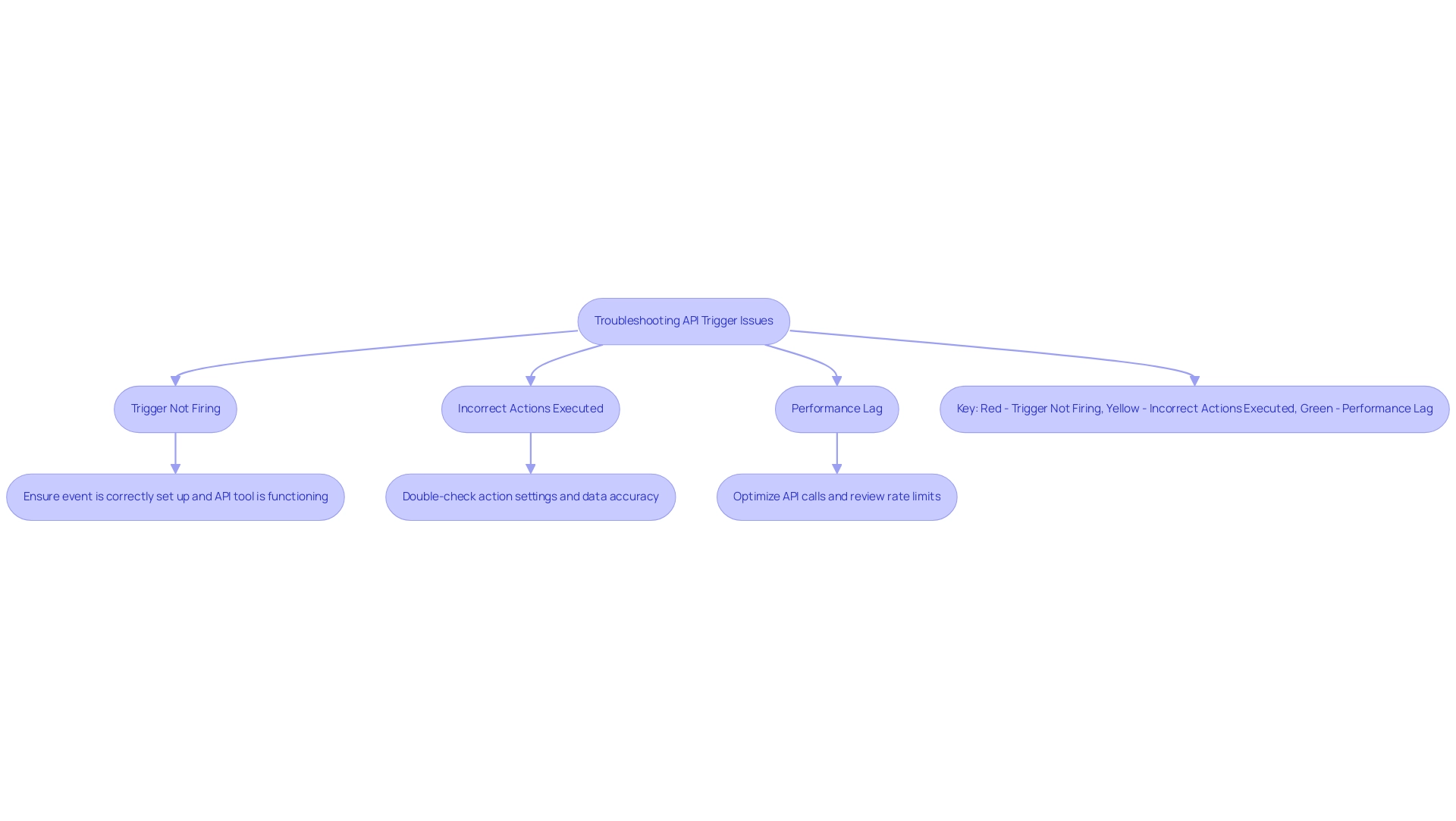
Best Practices for Managing API Triggers
To efficiently oversee API events and improve efficiency, consider the following best practices:
- Regularly Review and Update Events: As business needs evolve, so should your API events. Frequent evaluations guarantee they stay in sync with your business objectives, especially as you utilize Robotic Process Automation (RPA) to simplify workflows and lower expenses.
- Document Your Signals: Keep thorough records of your API signals, including their purpose, settings, and any modifications made. This assists in troubleshooting, onboarding new team members, and integrating customized AI solutions that align with your business goals, including the use of Business Intelligence to extract actionable insights from data.
- Analyze Performance of Events: Use analytics to monitor the effectiveness of your events. By following these best practices, organizations can ensure that their API triggers are effective, secure, and aligned with their operational objectives, ultimately transforming business operations and enhancing productivity through informed decision-making while identifying patterns and making adjustments as necessary to optimize efficiency, especially when utilizing tools like EMMA RPA or Power Automate to automate manual workflows for cost savings.
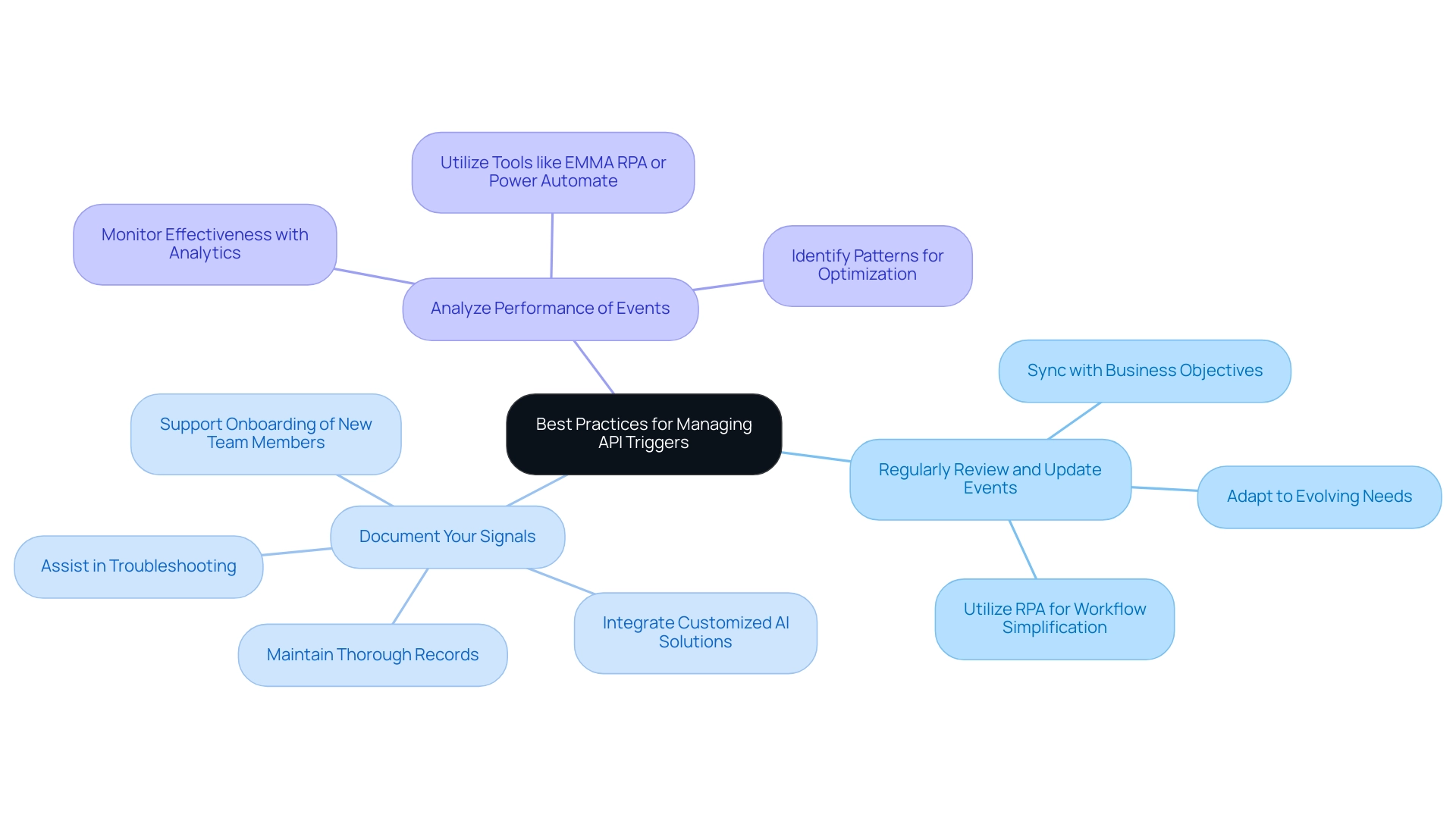
Conclusion
API triggers stand as pivotal elements in the realm of operational efficiency, transforming how organizations automate their workflows and enhance productivity. By understanding the fundamentals of API triggers, setting them up correctly, and addressing common challenges, businesses can unlock a wealth of opportunities for streamlined processes. The step-by-step guidance provided equips organizations with the tools needed to implement these triggers effectively, ensuring that every action is executed flawlessly in response to predefined events.
The diverse applications of API triggers—from e-commerce to project management—demonstrate their versatility and potential to drive significant improvements in customer engagement and operational workflows. By integrating Robotic Process Automation (RPA) and Business Intelligence, organizations can not only automate routine tasks but also gain valuable insights that inform better decision-making. Moreover, adhering to best practices for managing API triggers ensures that these systems remain agile and responsive to evolving business needs.
In conclusion, embracing API triggers is a strategic move toward achieving operational excellence. By leveraging these automated responses, organizations can enhance efficiency, reduce errors, and ultimately foster a more productive work environment. As businesses navigate the complexities of today’s digital landscape, the implementation of API triggers stands as a key initiative that can propel them toward sustained growth and innovation.
Introduction
In the rapidly evolving landscape of life sciences, organizations are increasingly turning to Robotic Process Automation (RPA) as a transformative solution to enhance operational efficiency and accuracy. By automating repetitive, rule-based tasks, RPA not only alleviates the burden on human resources but also paves the way for significant improvements in data management, compliance, and overall productivity.
As the industry grapples with challenges such as staffing shortages and the need for precise regulatory adherence, the integration of RPA technologies emerges as a crucial strategy for fostering innovation and driving growth. However, while the potential benefits are substantial, organizations must navigate the complexities of implementation, addressing employee concerns and ensuring robust infrastructure to fully harness the power of automation.
This article delves into the myriad applications of RPA in life sciences, explores the benefits and challenges of its adoption, and highlights future trends that promise to reshape the industry landscape.
Defining RPA: A Key Technology in Life Sciences
Robotic Process Automation (RPA) represents a groundbreaking shift in how organizations streamline operations, utilizing software ‘bots’ to automate repetitive, rule-based tasks that have traditionally burdened human resources. In the life sciences sector, the integration of RPA in life science is particularly significant, enhancing operational efficiency by automating critical processes such as:
- Data entry
- Patient record management
- Compliance reporting
With an astounding 90% of invoices not attached to a purchase order being processed manually, the urgency for automation becomes clear.
However, scaling RPA is proving more difficult than anticipated, with only 3% of entities having scaled their digital workforce. As emphasized by Deloitte, “Yet scaling RPA is clearly proving more difficult than expected: only 3% of entities have scaled their digital workforce.” By implementing RPA solutions such as EMMA RPA and Microsoft Power Automate, companies can minimize errors and drastically reduce processing times, ensuring that essential information is managed with the utmost precision.
This shift not only mitigates risks but also allows life sciences companies to leverage RPA in life science to redirect their focus toward higher-value activities, such as research and development, while simultaneously adhering to stringent regulatory standards. Notably, 66% of CFOs in the finance sector expect to allocate more time and resources towards RPA technologies, indicating a growing recognition of its potential to drive growth and operational excellence. For instance, in the finance industry, 92% of finance leaders associate RPA with driving growth, showcasing its potential impact across sectors.
By leveraging user-friendly automation tools like EMMA RPA and Power Automate, organizations can achieve significant enhancements in efficiency and compliance through RPA in life science, laying a robust foundation for future advancements. In fact, companies that have embraced RPA have reported reductions in entry mistakes by up to 70% and accelerated processing times by 50%, demonstrating the tangible benefits of these technologies.
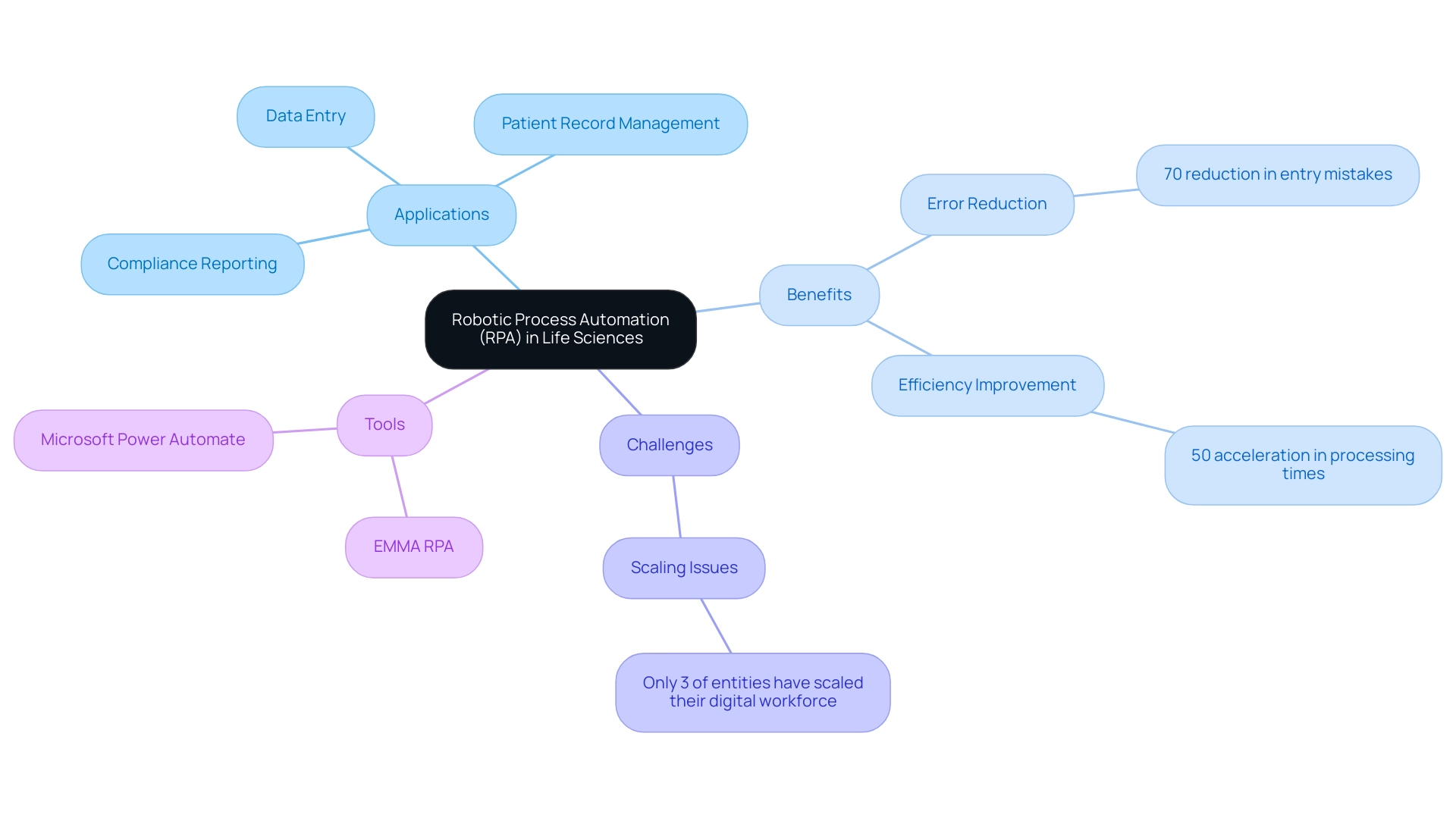
The Benefits and Applications of RPA in Life Sciences
Implementing RPA in life science brings forth a multitude of benefits, including enhanced information accuracy, improved compliance, and greater operational efficiency. For instance, in clinical trials, RPA streamlines the collection and analysis of trial data, drastically reducing the time needed for data processing while minimizing human error. Many entities are grappling with staffing shortages and repetitive tasks that hinder productivity; in fact, a recent survey found that 83% of employees utilizing AI-powered automation believe it significantly alleviates burnout and boosts job satisfaction, with 89% reporting increased satisfaction due to automation.
The use of RPA in life science applications is pivotal in managing regulatory submissions, ensuring that all required documentation is compiled and submitted promptly, thus addressing the common struggle with outdated systems. Additionally, a Robocorp survey indicates that 65% of respondents believe they would benefit from usage-based pricing models, highlighting a growing trend in the industry. To overcome these implementation challenges, companies can adopt a phased approach to RPA integration, starting with pilot projects that allow teams to adapt gradually and refine processes.
By embracing RPA, companies can not only optimize their workflows but also nurture a culture of innovation, enabling teams to devote more time to strategic initiatives that enhance growth and improve patient outcomes. As noted by experts at GSS IT Consulting, ‘With our experience from working on complex projects, as RPA consultants we are able to guide a company through the entire process of RPA implementation.’ This guidance is essential as RPA in life science platforms advance, incorporating sophisticated AI capabilities that redefine the potential of processes.
Insights from the case study titled ‘The Future of Automation‘ reveal that these AI advancements could replace up to 30% of US work hours by 2030, emphasizing the transformative potential of RPA in life science technologies.

Challenges and Considerations in Implementing RPA
Despite the compelling advantages of Robotic Process Automation (RPA), companies often encounter significant obstacles during implementation. A notable challenge is employee resistance to change; statistics reveal that a substantial portion of the workforce feels apprehensive about adopting new technologies. According to a recent survey, 83% of employees utilizing AI-driven tools believe it can reduce burnout and improve job satisfaction, yet many remain hesitant to fully adopt RPA.
This underscores the necessity for organizations to proactively address these concerns. Remarkably, 89% of employees report increased job satisfaction due to mechanization, highlighting the positive impact RPA can have on morale, despite the initial resistance. Additionally, the requirement for a robust IT infrastructure and strict adherence to data security and compliance standards cannot be overlooked.
Engaging stakeholders early in the process is essential to facilitate a smoother transition. Offering thorough training and assistance can ease concerns and enhance confidence in the technology, while a detailed evaluation of current processes will aid in recognizing tasks suitable for mechanization. Furthermore, integrating tailored AI solutions can enhance the effectiveness of RPA implementation by ensuring that the technologies align with specific business goals.
By addressing these challenges directly and strategically, entities can unlock the full potential of RPA, ultimately maximizing efficiency and fostering a culture of innovation. As the global RPA market is projected to grow at a CAGR of 27.7% from 2023 to 2028, it is crucial for companies, particularly small and medium-sized enterprises (SMEs), expected to adopt RPA solutions at a 25% annual growth rate, to navigate these hurdles effectively. This growth underscores the urgency for businesses to embrace RPA and tailored AI solutions to remain competitive.
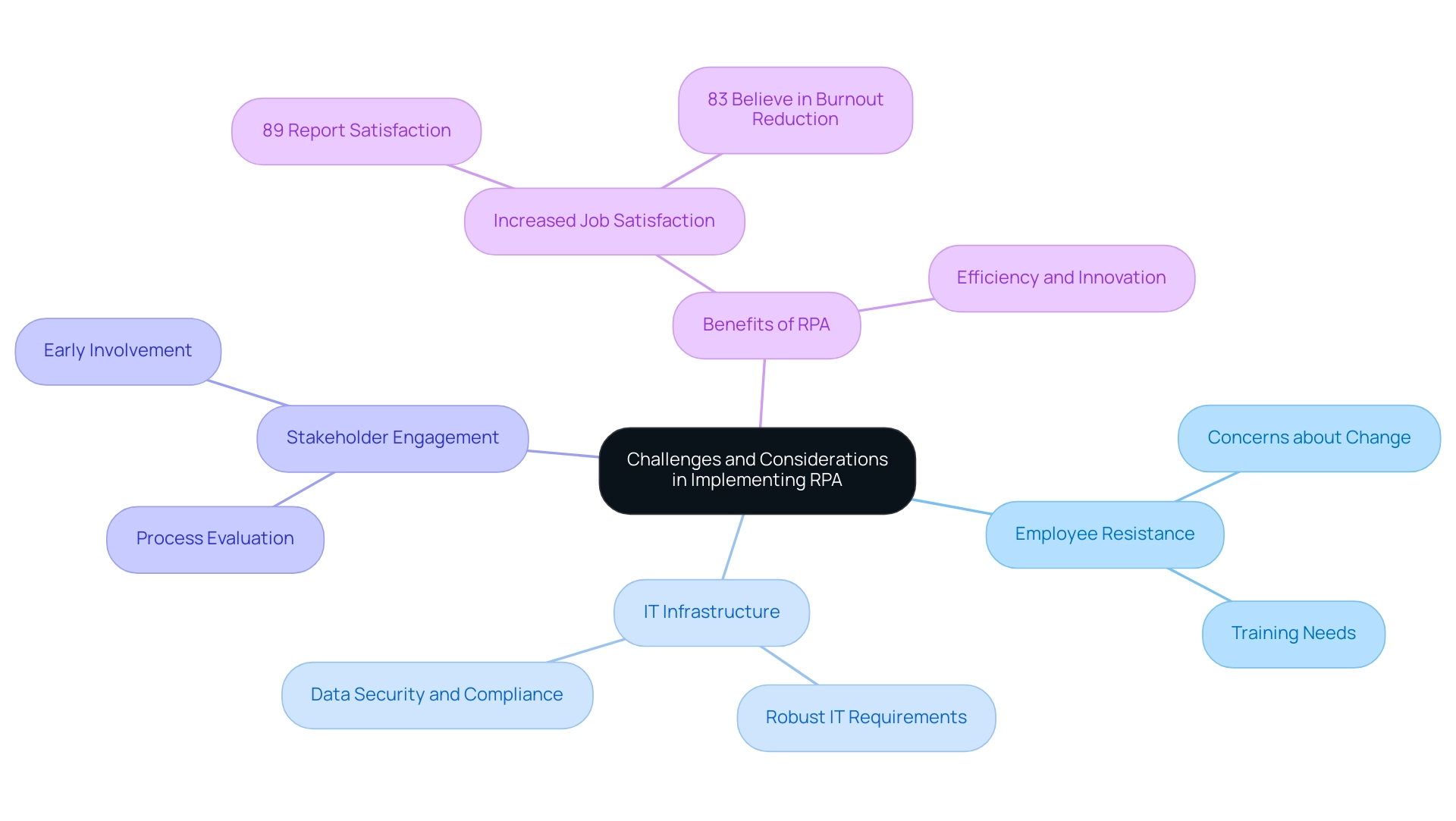
Future Trends in RPA and Life Sciences
As technology continues to evolve, the landscape of RPA in life sciences is poised for remarkable expansion. The combination of artificial intelligence (AI) and machine learning with RPA is transforming operations by enabling intelligent systems that adjust to dynamic environments and utilize data patterns for improved decision-making. RPA directly addresses manual, repetitive tasks that can significantly slow down operations, leading to wasted time and resources.
By automating these processes, companies can achieve substantial time and cost savings, allowing teams to focus on more strategic, value-adding work. The global blockchain technology market, valued at USD 10.02 billion in 2022 and projected to grow at a staggering CAGR of 87.7% from 2023 to 2030, underscores the significant technological advancements reshaping the industry. Moreover, the increasing adoption of cloud-based RPA solutions is driving the use of RPA in life science, equipping entities with the scalability and flexibility necessary for implementing automation strategies without the burden of substantial infrastructure costs.
These advancements not only drive operational efficiency but also play a crucial role in the ongoing digital transformation of the life sciences sector, particularly through the integration of RPA in life science, empowering organizations to remain competitive and responsive in an ever-changing market. A prime example of AI integration in healthcare is an early warning system that analyzes over 100 points from patient records to predict potential health deterioration, thereby enhancing patient care and operational excellence. Additionally, case studies illustrating the adoption of blockchain for healthcare data security highlight how technology is being utilized to enhance data integrity and confidentiality, addressing the increasing demand for secure transactions and compliance with data privacy regulations.
To effectively implement tailored AI solutions, enterprises should assess their specific business goals and challenges, ensuring alignment with their automation strategies.
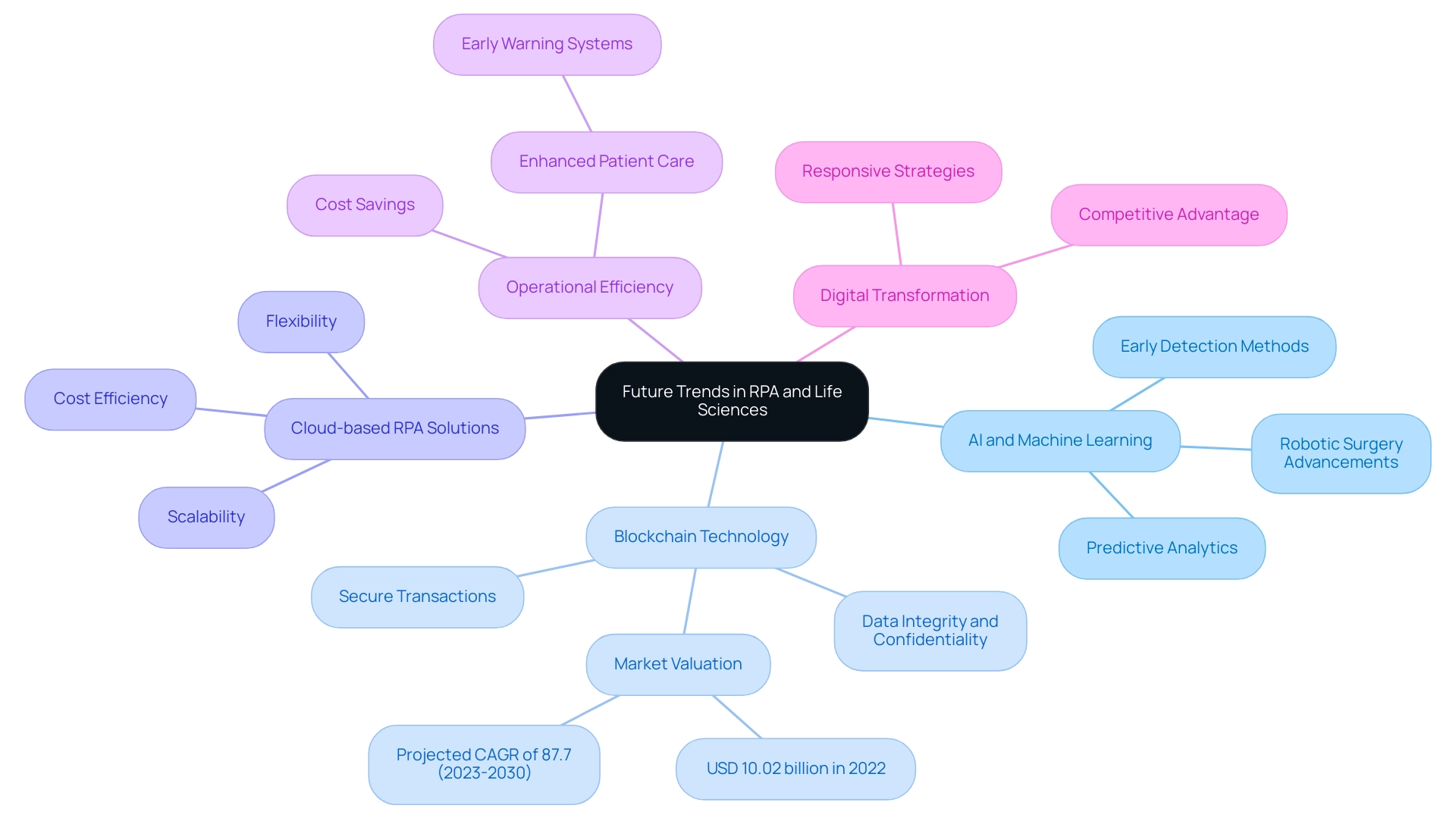
Real-World Case Studies of RPA in Life Sciences
A variety of organizations in the life sciences sector have effectively harnessed RPA in life science to optimize their operations. For instance, a prominent pharmaceutical company implemented RPA to automate its drug approval process, resulting in a significant reduction in the time needed for regulatory submissions. This corresponds with the findings from a mid-sized healthcare firm that encountered challenges such as manual information entry errors and slow software testing.
By automating information entry, software testing, and legacy system integration using GUI automation, the company achieved a 70% decrease in entry errors and an 80% enhancement in workflow efficiency. Furthermore, statistics indicate that AI algorithms utilize electronic health records, biomarkers, and genetic profiles to identify suitable patients for clinical trials, showcasing how RPA in life science and AI enhance operational efficiencies. Additionally, a biotechnology company adopted RPA to improve patient information management, leading to enhanced accuracy and expedited patient onboarding processes.
The necessity for data-driven insights becomes even clearer as entities strive to transform raw data into actionable information, enabling informed decision-making that drives growth and innovation. Such case studies underscore the potential of RPA in life science to revolutionize operational workflows, streamline costs, and enable organizations to concentrate on innovation and superior patient care. As highlighted by Bannigan et al., the availability and potential of advanced machine learning technologies in pharmaceutical and materials science further enhance these operational efficiencies, illustrating the synergy between RPA and AI in driving progress within the industry.
Notably, the ROI from these implementations was achieved within six months, emphasizing the effectiveness of the solutions.
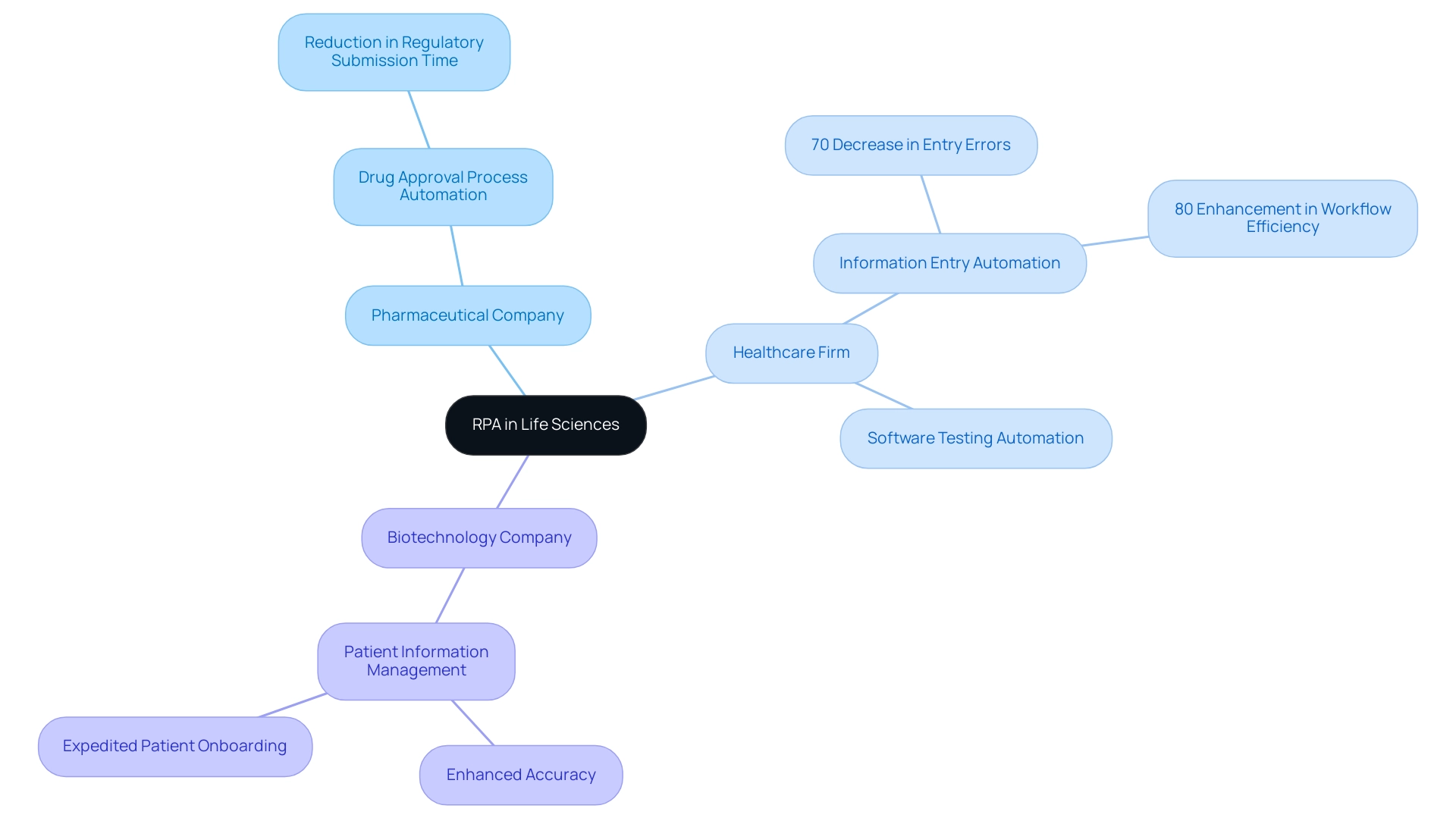
Conclusion
Implementing Robotic Process Automation (RPA) in the life sciences sector is crucial for organizations seeking to enhance efficiency and accuracy. RPA significantly improves data management and compliance, with reports showing reductions in data entry errors by 70% and processing times by up to 50%. These advantages underscore the importance of adopting automation.
However, challenges such as employee resistance and IT infrastructure needs must be addressed. Engaging stakeholders and providing thorough training can ease the transition and foster a culture of innovation. A phased approach to RPA implementation allows organizations to maximize its potential effectively.
Looking ahead, the integration of RPA with artificial intelligence and machine learning will further revolutionize operations, enabling intelligent automation that enhances decision-making and efficiency. As the RPA market continues to grow, organizations prioritizing these technologies will be better equipped to overcome industry challenges and improve patient outcomes.
In summary, the time to embrace RPA is now. By leveraging automation, life sciences companies can optimize workflows, drive innovation, and ensure sustainable growth in an increasingly competitive landscape.
